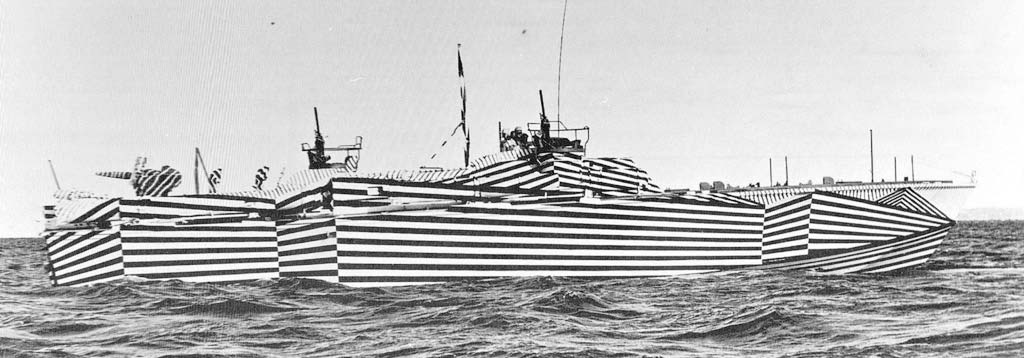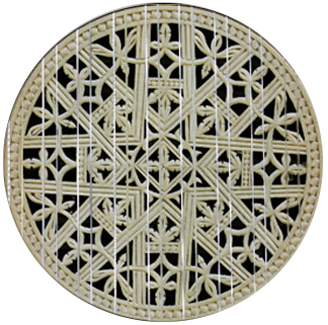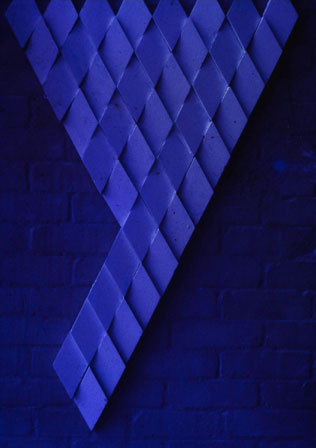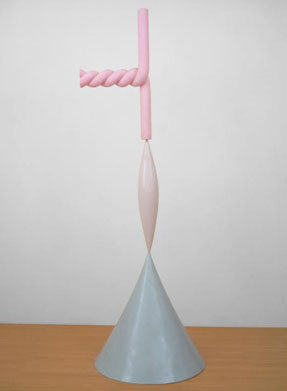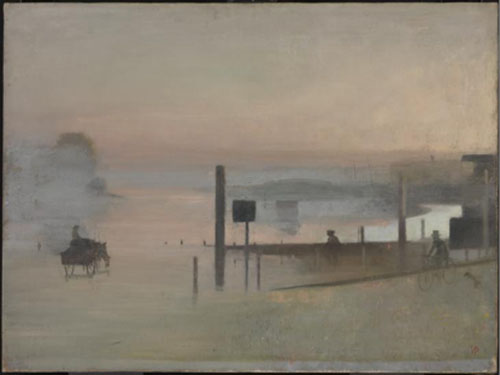Home |
Gallery |
Books |
Memories |
Contact |
|---|
Stories from my past
Intermittent thoughts on a variety of subjects, mostly science and art. A journey through my relation to fine art, figurative painting, conceptual art, sculpture, a bit of interior design and some childhood memories.
Feel free to browse or choose from the list of memories below...
|
Uncertain at St Dunstan's College
|
|---|
Time's up
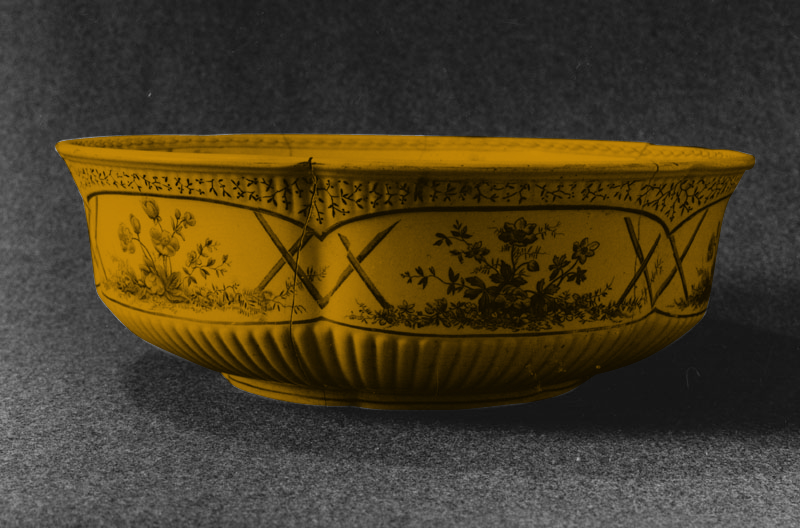
On a quest to find things that nudge towards current truths scientists come up with experiments actual or in thought. Listening to a series of lectures The biggest ideas in the Universe (https://www.youtube.com/watch?v=HI09kat_GeI ) from Sean Carroll, I face an inability to completely grasp our differences. It's a trivial relief from my concentration when he sidesteps from where he wants understanding to be at current rest, into the domestic. Two of these occur when he turns to deal with his cats … "he's a great cat" and another later in the series … "wants me to play with him." By the by I think his two cats are named Ariel and Caliban from The Tempest so perhaps he has an interest in the arts alongside his scientific studies. These minor distractions don't really stop me trying to follow quantum physics; I plough on bewildered but at least catching the odd glimpse.
Alongside his 24 lectures I have listened to Juliet Stevens reading The Golden Bowl by Henry James. Would that I had changed as much as Maggie whose strength and understanding blossom as the pages pass. While Maggie engineers her family into positions, places even, that helped me see errors I had made, Mr Carroll made me think about where that past might be. Linking thoughts between quantum fields and Maggie's plight in the Bowl may seem odd, ridiculous even, but at the very least it makes me think there's more to betrayal than primary reaction.
It's easier to click magnets onto a refrigerator door than to remove them, admittedly only slightly but there is a difference.
It's easier to avoid quantum field theory than try, at the very least, to have a wee peek at what others are doing.
It's easier to begin an understanding of 'fields' once we have recalled those we witnessed with magnets.
It's easier to understand the significance of a/the crack in The Golden Bowl than to imagine one across our Moon.
I look out and upwards at the Moon,
A crack across it.
Two weeks go by, the Moon is split in two.
I study the separate pieces through my telescope
No further cracks appear. Anon.
Besides the difficulty of Field Theory one, and only one, of the many things Mr Carroll and The Golden Bowl bring to mind is time; what a tricky subject …
I remember hearing Samuel Beckett's play Lessness, read on Radio Three back in the 1970s, here's a quote or two
"Old love new love as in the blessed days unhappiness will reign again."
"Figment light never was but grey air timeless no sound."
"Blacked out fallen open four walls over backwards true refuge issueless."
I'd miss-remembered some of his beautifully read but shocking lines from the 1970s radio three programme that over the years have brought tears to mind rather than eyes; making me wish I had tape recorded its reading … To be able to listen again to readers Donal Donnelly, Leonard Fenton, Denys Hawthorne, Patrick Magee, Harold Pinter, Nicol Williamson would be wonderful
Apparently Mr Beckett wrote all of the sentences for this work on separate sheets of paper and selected the final order at random. There is a view of time as a filmstrip, separate images like that link to movement when passed at speed. What might it be like were the 'time filmstrip notion' projected in a random order rather than a continuous flow?

There are other views of how time might function explained by Mr Carroll but so complicated that all I can do is daydream them and should you wish to grasp the Block universe, (diagrams above from Mr Carroll) where the future is as real as the past v only the past is real, you'll have to listen to his explanations rather than a list of my responses which I'll spare you. That said I might well be unscientific because of my personal preference for truths that we sometimes see in art.
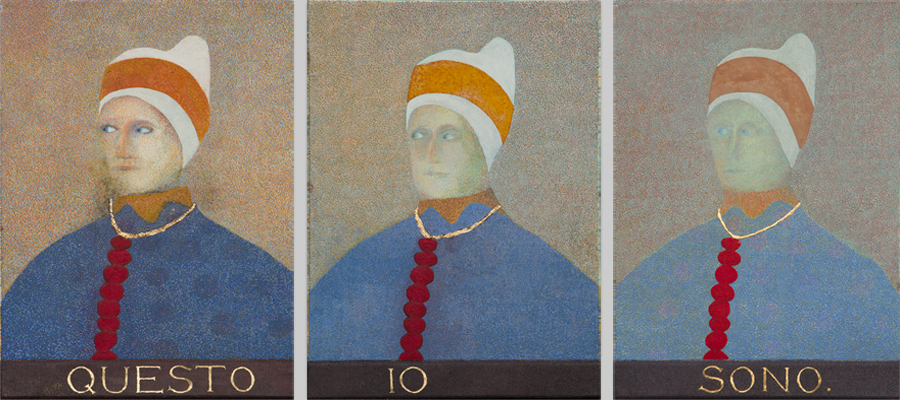
Linking space-time, block universes, many worlds, et al with The Golden Bowl, Lessness and my response to Bellini's Doge of Venice is my attempt to inject thinking into the art I try to make. Uncertain if I have failed so far hangs around in my thoughts and time's nearly up. [ho ho] Not giving up on the pursuit of grasping what understanding is, remains and is an enjoyable battle.
This box diagram seems a poor image with which to conjure my time spent looking …

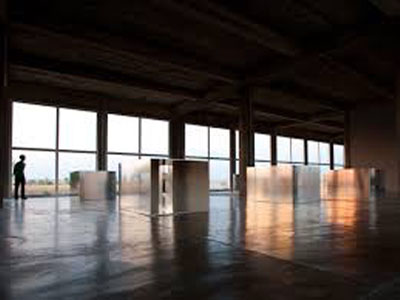
… though it's interesting if one extends it to the array of boxes in Donald Judd's installation at Marfa in Texas. I cannot remember exactly the 'now' planes that exist inside Mr Judd's boxes but still recall the immense feeling the installation conjured making me dream of being both inside and outside of time and space.
Trying to follow Mr Carroll, I'm listening to his lectures again this time along side James Joyce's 'Ulysses' which is giving me fresh thought about how far our lives are away from what makes them possible. It's a shame that religions hang on to old texts as clearly a deity, if there is one, must have known at the time of creation that our biology would really struggle with a leap from classical to quantum. It might seem strange in the block universe to believe backwards … that thought would leave as well as arrive. Placing religious thinking alongside, inside even, the swop from classic to quantum requires new texts alongside as well as inside time. Finding out that we weren't at the centre of things was a shock, that the universe is unthinkably sized, that we are so minute, that classical thinking is in the past … well nearly … umm … makes one think a deity may well have other things on its mind besides us. A deity who knew everything about not just us but everything would have no curiosity and so perhaps could not make art.
Soon after Fanny Assingham breaks the Golden bowl Adam and Charlotte Verver leave for America, the broken parts are left behind …
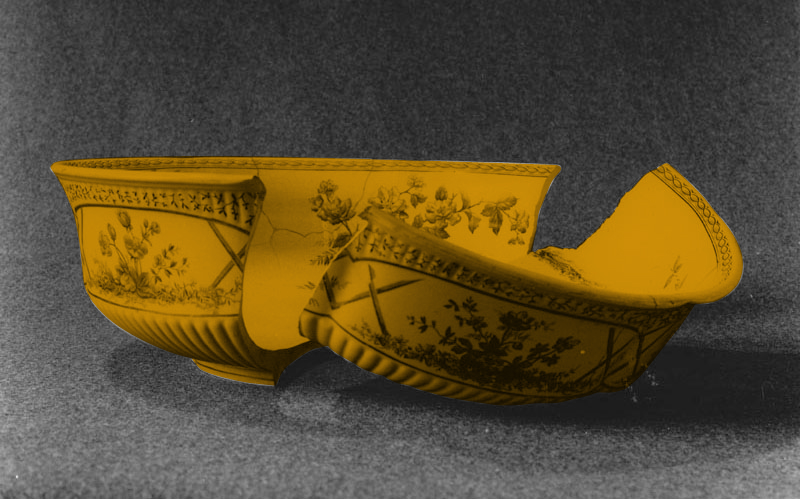
This is my very own broken bowl. It fell apart in 1976 when time altered as my belief in friendship needed rethinking. When Maggie knew that lies of omission might break her father's heart, as they might well have already broken hers, she waited in time. Henry James embedded Maggie's lines in Art rather than therapeutic treaties because Art, like prayer, is an act of love rather than petition.
Stamps.
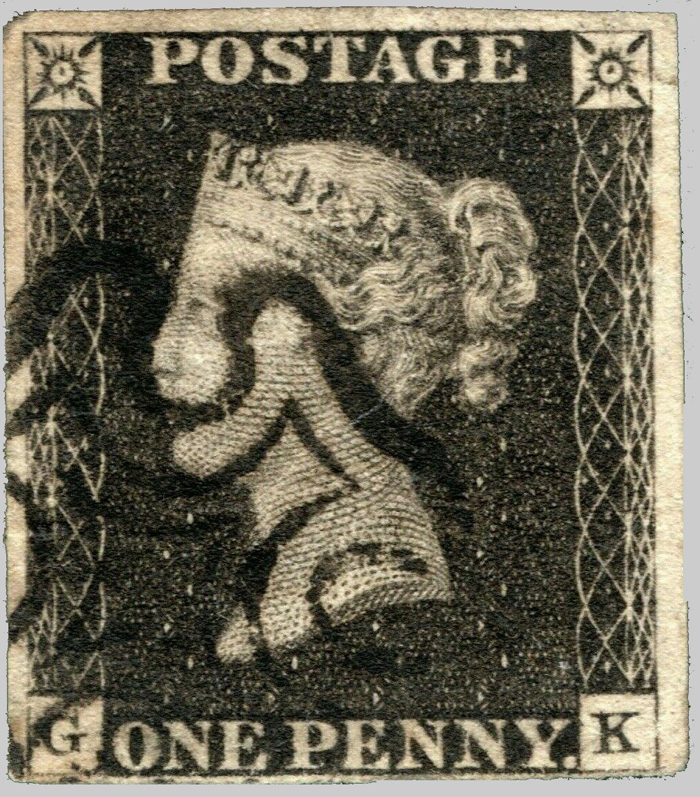
As a child 'The Three Musketeers' Stamp Club' was pencilled onto a wall where I met with fellow collectors; we wanted, no dreamed of a desire, at the very least, to see a Penny Black. These days I can see an image of a penny black with a few flicks of the keys, even read of another Wallace who pioneered our postal system. When I wrote 'Six Letters' (elsewhere on this website), HV3, as I called him, sent letters to his six wives and used stamps until he got to his last wife Katherine Parr and there were no stamps left, instead she had to 'Burn the Rose'. The other thirty letters in that work are, in a way, also fake because I never sent them, they too 'Burn the Rose'.
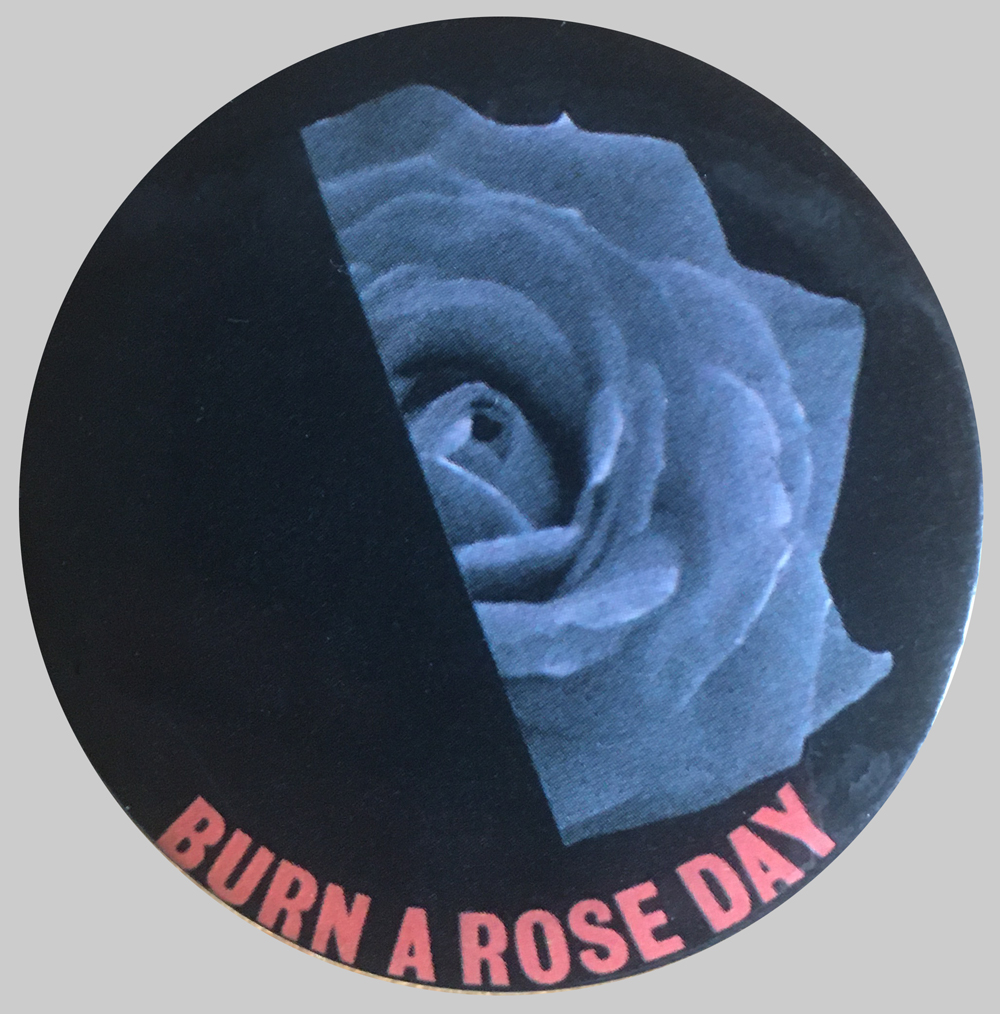
What I wonder connects being a child and wanting to see a Penny Black with my memory of being a child and wanting to see a Penny Black? What connects a rose with a burning? Perhaps artists make works without knowing why and does that mean they are obscure, difficult and sometimes unfinished because one kind of thinking sits badly with another. A visual artist may embark on a work wordlessly; when asked "What's…?" the visual thought is passed to words and may cause a snap.
I had a snap when post art school I thought to enter the 'Art World' but like skimming Earth's atmosphere attempting entry I was left high and dry. Still in pursuit of art the feeling I get when/if I manage to step inside a work remains to this day, I am content. It no longer matters that I never struck gold, if that's how it feels for those who have. What I have is the opportunity each day as I work to think about my past. 'The Three Musketeers Stamp Club' was little to do with posting letters but more the cultures of collecting; my painted past may have little to do with success in a gallery but more to do with my private life. Many painters hope their works will be paid for as well as collected, we all need to make ends meet.
During the repetitive parts of my work I listen to talking books and so heard of Charlotte Stant in Henry James' Golden Bowl; it was a moment of externalising, seeing myself perhaps as others had. A ghost of myself was being handed to me by the great writer as he presented perhaps a way of thinking about how we can attempt to live well. As a child Adam Verver, Charlotte's husband, may have begun his collections with stamps and I wondered if he had owned a penny black because he could; if he had married Charlotte because he could or perhaps for the Prince; if he had loved his daughter because, unlike his wife, she loved him. We attempt to understand our relationships but like time they/it passes without us knowing its speed or direction … that our feelings vanish when we die. Well aware of the cracks like those of the Golden Bowl I try to see; seeing is my pleasure.
This Charlotte moment shares the coloured dots I am applying as I continue my way through the 'Bowl' hoping to come to terms with failures from my past…
"Well now I must tell you, for I want to be absolutely honest… I don't want to pretend and I can't pretend a moment longer. You may think of me what you will but I don't care … I came back for this and not really anything else. For this … to have one hour alone with you"
Soave sia il vento
(Gentle be the wind)

In 'À la Recherche du Temps Perdu' Swann floats from one group to another with gentle ease until he falls in love with Odette, Madame Verdurin exhibits the cruelty she perhaps does not know she has. It's easy to dislike the shallow Madam V. to sympathise with Swann as he changes floating to anxious steps. For me the saddest thing is that he cannot manage grief alone but needs the help of others.
Groups come and go with us all, we might be within The Three Musketeers Stamp Club as children or even play Prisoners Base to capture one another until the tall man in the top hat, Swann, arrives to free his daughter and return her safely home. Proust's work wove itself into my life over a number of years and I remember when Albertine first died I stopped work and paced the room stunned that she was no more. Listening more than once, she has died many times and for others too but my first time was a heart beating fast moment until a notion struck me. I walked to my player removed the disc and replaced it with an earlier one … Albertine lived and led me to the book I made … 'Albertine's Truth'. I also painted 'Albertine's Truth' but no longer hold the memory of its orange colour until I travel to London where it hangs behind a sofa.
It seems to me that Swann appears in Proust's work as the ghost of the narrator. I love the presence he brings, first when he enters through a garden gate to the sound of a bell and into a small family group. Then later in appearances with 'The Little Group' of that self-seeking Madam Verdurin where he faces the issue of 'where do I belong' v 'who do I truly love'.

He, Swann, may have been depicted in a work by Renoir binding in another way our fiction with reality, at the back of course with his top hat and his sorrow. That sorrow touched me deeply; I imagine him paused, frozen in time with the forgotten Bergson but I thank him beyond measure for this: -
"To think that I wasted years of my life, that I wanted to die, that I felt my deepest love, for a woman who did not appeal to me, who wasn't even my type!"
"Rudy beag bocht
(poor little Rudy)

Like the forgotten Henri Bergson I feel differences in time rather than a variation in its speed. So listening to a reading of James Joyce's Ulysses as I tinkered with my task I felt a little odd, was I still fifteen and making decorative objects for presents. My left overs would certainly be similar to many others we sweep up; I wonder about our left over fragments, even go as far as to imagine a row of boxes filled with their differences … say the bits chipped off the Apollo Belvedere, bronze fillings from a Henry Moore even the crumbs from a gorgonzola sandwich with a trace of mustard left by Leopold Bloom.
"But you know I'm so glad to be on my own" is a line from a song; it continues "Still somehow the slightest touch of a stranger can set up trembling in my bones". As Bloom wanders the Dublin streets he might dwell upon these sentiments; has he, like Joni Michel who sings the song, made an exodus from his loved one or has the loved one evaporated? Bloom is left with a ghost of himself he cannot bear to see; that ghost, Blazes Boylan, folds the voluptuous Molly into a gin and splash that he offers to the side-lined husband. Bloom fears the intimacy he had shared with Molly for though still in love with her he's constantly forced to be on the fringes of her thoughts. In their bedroom, always knowing that one of them is upside down, Bloom sleeps as Molly dreams or is that the other way round. In that other Ulysses book, perhaps Bloom would be the one who unpicks the past days work.
Were I to submit my fragments for others to see, 'Post Modern' as it were, I would be refused an entrance and so, like Daedalus, gradually become aware of my own stamp … Penny Black- Broken Crack - Wrong Track -Thinking Slack -Tic Tac - Nick Nack - Ack Ack.
"I fear those big words that make us so unhappy"
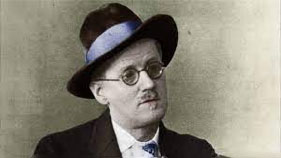
"Ineluctable modality of the visible; at least that if not more, thought through my eyes"
Scrolls.

Long ago in an episode of 'Hancock's 'alf hour' our protagonist reads a learned tome but soon, to audience mirth, ends up reading the dictionary. New words pop out from Will Self, well new to me at any rate; there are times when I think he has them all tucked away in a secret place where the rest of us can't quite see. More of a dyslectic listener than a reader I have heard more than read the wondrous Mr Self. Rather to my annoyance, like Hancock, I have to stop his flow and look up the parts of his vocabulary that will never belong to me.
A close call was 'xxxxx' … well codex actually and I apologise to Mr Self for not having it logged. I'd hate to be on the wrong side of his meaning of codex so, incorrectly I expect, wander off into a 'text before books' meaning. Codex before paper folded in 'octavos' … Look that up in your Longer Oxford Mr Self. The history of paper almost certainly begins in China with wasp observations and for me at least has an ending of some sort or another when we left the elephant world for something not quite A1?
Imperial - Half Imperial – Elephant – Double Elephant – Atlas – Antiquarian et al – versus - A0 A1 A2 A3 A4 A5 … HUH
The paper I use rolls for my scrolls is Bockingford made in Somerset quite near the city of Wells. Sadly I have to have them cut on a mechanised saw that leaves me with imperfect edges unlike the preferred factory blade. I have been working on scrolls for a while now; there's something really appealing about the process. I, like many other artists, still use rectangles that make spaces for us to look through, into and at. I am probably working on my last few canvas rectangles as I have discovered time consuming scrolls. I think, if I finish any, they may be my best works. It's as if the late great Barnett Newman is looking down and whispering into my ear, "Looks like you finally found the route to your subject Andrew". There are always dangers with new ventures but to my mind it's essential to work at the edge … 'to walk on tiger tails'
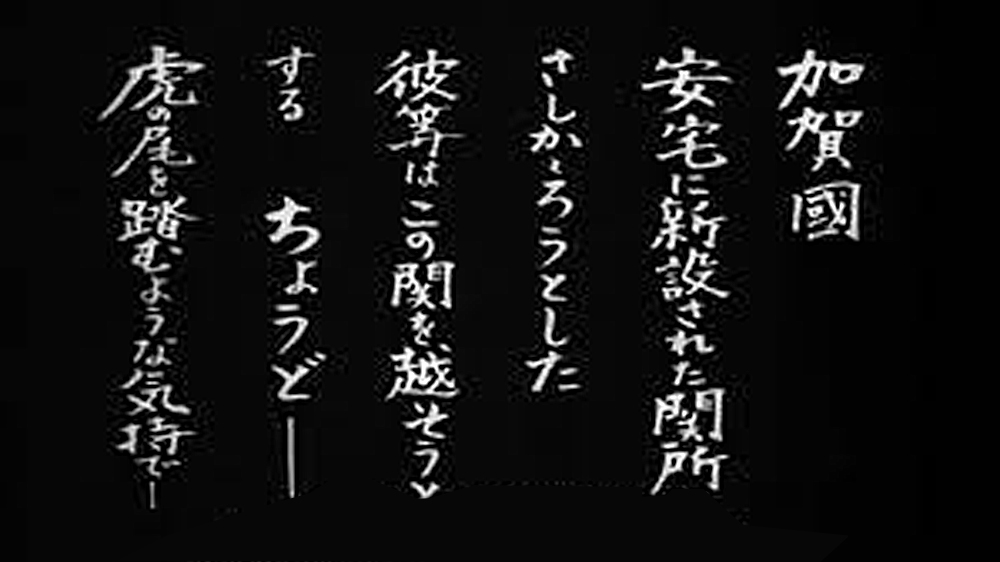
With the unease of one about to tread on a tiger's tail.
I remember the 1952 Japanese film 'The men who tread on tiger's tails' where a scroll is read in dangerous circumstances in that there is nothing actually written and the reader is making up a text.
My early ventures into scrolls were tentative but my improvised actions led to this. What I didn't know was whether it was a complete format?

The rectangle problem is one described by Clement Greenberg in his 1948 essay 'The crisis of easel painting'. Manet is in there as he initiated a change than rocked the process of western art possibly leading to many artists leaving their rectangular tradition. What we have these days is the reproduction and edit difficulty brought to mind by Marcel Duchamp. Here's a later scroll example: -

and edit …

John Berger talks about the issue in his 1970s television series 'Ways of Seeing'. How easily edits work on camera but are differently available by eye when we are in front of the work itself; finding out how to look at a painting is difficult, we all need help. Television commentary is useful but tends to skip available differences focusing on the presenter's single view. To my mind unless we connect via looking when in front of the actual work the art remains as possibility, un-transferred as it were. With cultures embedded in rather than open to change it is easy for 'a looker' to seek contentment rather than participate in the effort that looking at current works demands.
But, and it's a big but, what we have to face is, do we need any longer to be with the actual work or see via the various ways we now have of reproduction? I have no answer and in a way, because it contradicts my belief in being with the work itself, am glad I don't have much time left to concern myself with such a huge issue.
I can't quite grasp how or indeed whether I have happened upon this issue with my scroll works; perhaps that's why I think I have found something more pert than my canvas rectangles. Looking back at my first scroll venture it's easy to see a set of attempts to activate space/s, what I had to face up to was their separations … could they be cut up and placed side by side? What I love about my current thinking is that it hangs in the visual flank of thought unlike any other that has passed through me. I have stayed, perhaps for too long, in what I was taught many years ago, trapped between the culture and desire to be alike … to be with others.
In my scrolls I desire a continuous flow even though I am aware I am still using a rectangle albeit a long thin one. With this in mind I'm anxious to find a route that means the scroll is something other than a 'series of rectangles' separated but on the same sheet and into, at the very least, something that needs to have a 'walk on by' quality. This poor explanation only approaches the thought flank already mentioned.
Imagine scrolls arranged in a cylinder you have to duck to enter; I think that John Berger presented a work in this way and though it might work I try to dream up other ways to present. I'll keep edging my way hoping that when the tributaries end the river'll begin and I'll be sailing along it in an unknown direction.
Another way of getting my thinking mustered is via Amara, a girl of about twelve just after she arrived in London. She has her first ever day in an English school and is handed an exercise book … "Write your name on this Amara" - "aktub asmuk ealaa hadhih aleimarati" in Arabic … Amara wrote her name on the back or did she? The book as an object has two fronts; two backs one middle but my recent brush with Kierkegaard has given me another thought or two enlivened by the quote "Life can only be understood backwards; but must be lived forwards". I would like to make a scroll that could be opened from either end but sadly it cannot be done.
"Imagination dead imagine" this time a quote from Samuel Becket adds to my desire for circular thinking but I had a stroke of luck with a dyslectic error that led to an Homage to the great man. Here's how it happened …

I took this rather poor snap in my workroom and just in case you haven't noticed left out an I … AMBITON should of course be AMBITION. After the discovered error I pencilled 'Not I' … 'omage to Samuel Becket at the end and began the work again but this time added a different end and beginning.

Though incomplete you can at least see the eye of Horus on the right and on the left the beginning of a Celtic Knot. My spelling mistake led me to an addition that took me a step closer to understanding what I was up to. This text is long enough for a single scroll so does not have the difficulty of separation as this one had done a few years ago.

As mentioned above this was an early attempt to link text that I had used in paintings and evoke connections because they are on the same sheet but I soon saw the problem that needs a better link than the paper they are painted on.
From above … and here's the detail problem again, images presented on screens versus 'being there': -


Should I use music 'dots' to help the flow from 'Inside the inside' and onto 'Hilbert's Hotel' I wonder? Well not so far as I have a slight fear of loosing the arrow before I have mastered how to draw the bow (Ref: - Zen and the Art of Archery).
I have found or rather am finding other linking thoughts and that is the wonder of old age. By now fairly certain that we are absurd and responsible for more than we admit I wander through the days longing to find out more … A worry though is that the Kierkegaard quote "Life can only be understood backwards…"
Do I need to understand before I proceed … umm … I think not or I would lose my tiger's tail.
Uncertain at St Dunstan's College.
During the non swinging years of the 60s I went to the Whitechapel Gallery; it was1961 and I'd read a newspaper article called 'Walls of Glass' about an art exhibition. Tweak this link and you'll see me as I looked back then at that exhibition, well it might be me, I'm uncertain. https://www.whitechapelgallery.org/exhibitions/rothko-in-britain/
It's hard to select a single trigger that got me away from one kind of life and into another but the gallery visit may have been one. In some ways half a dozen years of electrical apprenticeship were good for me but I was keen to find something different; we seldom truly commit to the things we are out of tune with. A mixture of chance and uncertainty got me into an art school; I was so naïve at that time I thought there was only one, such a lucky break then for a London Lad.
After the wonderful time spent in art school I needed a job and teaching offered part time employment that gave me days of the week to carry on with my own work. I spotted an advert in a newspaper for a part time craft teacher, after a couple of interviews I became a teacher in the junior department at St Dunstan's College. The vacancy included some art teaching though I preferred craft where children stand a better chance of learning to look, making objects rather than images. Making things that can be painted made more visual sense to me though I hope I got better at an introduction to drawing and painting for children. To begin with there was a speed issue; seven year olds can go through quite a stack of paper in forty minuets … umm … making a flat disk spin with interchangeable coloured tops takes more time but is it an art or a craft lesson. There were many issues to deal with and as I learned how to get children hooked I began to look forward to the time I spent with them as well as the days spent working on my own.
Over the years encounters with other teachers led me to thinking about the education system that crams our brains with a high percentage of things many will seldom use in what ever our world of work turns out to be. Talking about education was only interesting with a few teachers and we helped each other in many ways. Class management was seldom discussed, some 'strict' teachers frightened children and some children frightened teachers. I was never strict but did get better at class management, I'm still unsure quite how.
There were some great teachers and some who were dreadful, most of us jogged along as average and I suppose that's the same for more or less all aspects of human endeavour. One of the things I grew to dislike was prize day; terms like winners and losers, good-better-best et al un-eased me. I only once found a good solution to my discomfort when I gave my own prize of 'Concord memorabilia' to the child whose end of term marks meant being in the seldom-mentioned middle. This is not an easy issue, in later years the school came up with 'records of achievement' something for everyone but that seemed to me to be a crap idea too. I liked a notion I had back then which was complicated but boiled down to chance; my head of department thought it was hilarious.
Antony Seldon was deputy head for a while; during his stay the school became buzzy and we got an opportunity for a Lord Mayors Float through the city. I was asked to join the team and remember my list of suggestions at an early meeting, one of which was that we make a hot air balloon en route launched near the end of the route. "Totally Barking" came from Mr Seldon "That's why we want you in the team Andrew"; what I was really there for was to make the entry. The whole episode was a fascinating insight for me into the world of management.
It was easy to see that Mr Seldon was good at the system we had, as said he made the atmosphere buzzy but as we all do he had flaws … umm … I think in his mind academic achievement was the zenith. I wonder why the academic is used as the judgement for our intelligence when for many of us the time might be better spent finding out what you're good at rather than bad at.
Were education to be addressed to the many rather than the few there would be quite a number of changes to the curriculum. Here's a simple example with mathematics; there is a hidden change in maths somewhere among our years at school from calculation to maths itself … not entirely dissimilar to the change from colouring in to art. I witnessed a child made things with millimetre accuracy whose maths was described as poor. Of course we need to calculate but few of us encounter surds or calculus in our employments. Personally I loved geometry though algebra and trigonometry were and still remain an anathema of the time I'd rather have spent with Euclid.
All through the years I worked at St Dunstan's College I was 'light relief'; watching the way it worked was a revelation. As a minorities teacher all that really mattered was my relation to the children. I had no interest in it's being a career, as my brother once remarked, "in school there are HODs HOYs and HOBAs" … Heads of Department, Heads of Year and Heads of Bugger All. As previously stated there were, as in most of human activities, those who were good at it alongside those who were awful. What I learned through the years was quite remarkable; earwigging in the staff room was interesting but the children's revelations were quite, quite remarkable. Gradually I learned to see through and into the disguise of their language, what children reveal as they interact is often very different from what they say.
I try to remember the years of teaching children with warmth for all even though there were many whose grids were not aliened with mine. Each and every child will have a different truth from mine not only about each other but all of us who tried to nudge them towards an early response to how things operate.
As a schoolmaster I willingly learned to deal with uncertainty; watching children make things as a slow dawn. I was and still am uncertain about mistakes though at least I realize it's probably the same one over and over rather than the foolish pretence 'I won't make that one again'.
Children make fewer mistakes than those handed on by judgements from teachers and indeed many parents. This applies particularly to making things; 'which is the best?' alongside 'which is your favourite?' was a simple first step for me to deal with. Children find difficulty with these two 'Good – Better – Best and Good – Better – Favourite', as do some of us older responders. In art as well as craft this makes for real visual difficulties; sorting out what they are and how we educate remains unresolved. What exactly does "She/He's good at art' mean when there are no clear values/rules other than preference; it would seem that resorting to 'best depiction' remains even after a child has passed through the parental 'pin it on the fridge years'. The difficulties of looking, beauty, well made objects and art itself are not for children to unfathom though we might aim for a better set of responses for them to witness.
Hanging onto my uncertainty through the birth of our National Curriculum was tricky, the pretence that thinking is best when linear leads to despair for many children. Here's what my head teacher liked to see pinned up for 'Open Days': -
CLOCKS
1/ Idea sheets
(Draw as many ideas as you can think of for what you want your clock to look like)
2/ Two Favourites
(Study your first sheet and select your two favourites. Draw these two showing more details)
3/ Final Choice
(Make a detailed drawing of your favourite clock)
4/ Working clocks.
"That's lovely Andrew , parents'll love it" … of course I've left out many of the joys and sorrows that crop up when children made/make things. Clocks (in this case) where it's worth a mention of one girl's 'tear drop clock'; among the surround of muddled numbers she wrote and scribbled over "a time to cry"; her sheets of stages 1.2.3. were not inside her folder.
There's nothing wrong with stages '1.2.3.' thinking but it leaves many other pathways out. Unlike the scientist Hugh Everett, I do not begin to understand quantum thinking; even so I know that light takes all possible paths via a leaf on its route to photosynthesis and energy. Surely we need a rethink that includes rather than selects a single standard, if our leaders are of all one type it's because many 'average' children are neglected. In what became D.T. classes I used a few terms like these 'Oh no I've got to think', 'Make it work, make it look good' and 'Beware the delight of your first idea'; I hope these. Sometimes chanted or said with actions helped children thrill to the joy of making things though I lament my being less help with art in their early years.
As the years passed I gradually became a better teacher though I was never great as some I have seen in action, because I never fully committed; perhaps that's also why I'm the artist I am. Telling stories of teaching moments is almost certainly best left to writers like Gervase Phinn; he makes us smile, even laugh out loud.
So, my best efforts in the classroom were an introduction to making things, Craft rather than Art. A good start might be to change their titles though not like this … Craft became C.D.T. (craft design and technology) somewhere along the way the C was dropped along with finger dexterity and hands holding tools. D.T. design/technology, as it ended up, meant that most of the time a child spends is writing record sheets. There is nothing more likely to put many children off making things than record keeping. Records are wonderful as historic documents
but makers of objects leave objects for us to look at rather than read about. Of course records fascinate us when we happen upon them in museums or behind panelling but they defiantly put many children off the pleasure zones of construction.
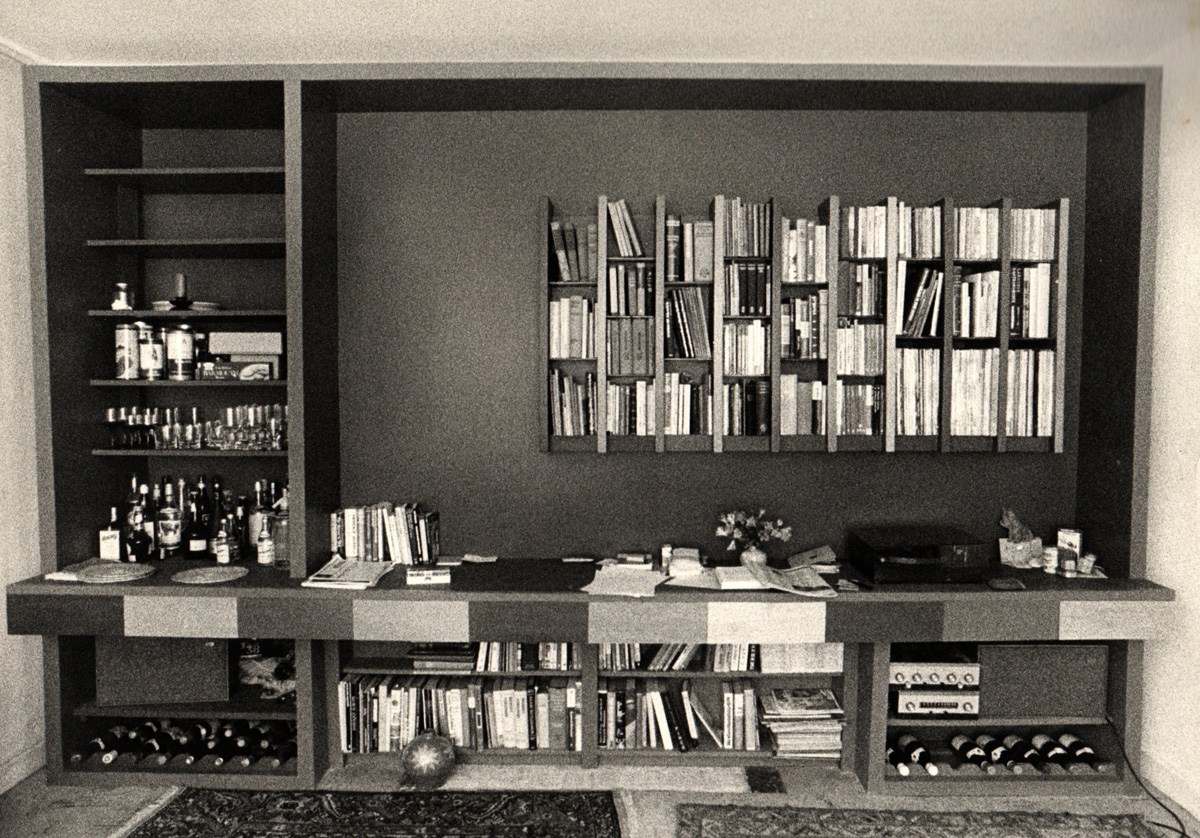
I seldom make plans for the things I make though there is nothing wrong with a route that does so (so none for the above, which I made in the early 1970s and still hold onto the buzz I got while making it). Isobel's 'teardrop' clock was beautiful even if there were no plans; the surprise for her was that I told her it was wonderful and that's because it was. Sadly I doubt many academic teachers would have rated it highly; there is great danger in the red pen, I became a truant because of its power over my emotions. One of my aims as a teacher was to have children in the room that didn't have the red pen sword of Damocles hanging above.
There are a few memory moments of my/the time I spent teaching, tucked away in the loft. One is the most wonderful set of records, even I can see they are great, made by an eight/nine year old; the sort of child loved by academics. These are superb sheets though I can't recall a single thing he made in three dimensions. My dozen or so 'Barry sheets' as I call them, if marked would be marred by red pen but still admired by the academic, recognition for Isobel's 'Tear Clock's beauty unnoticed.
I remain uncertain of a way ahead; certainty seems to me to be the road towards a dead end; looking at art can be hard work and distinguishing it from craft extremely muddled. Children may paint, draw and make things but to call their outcomes 'Art' plants misconceptions. My head teacher, bless him, would say pointing towards a wall space "can you put some Art there Andrew?" I dutifully pinned up things I knew he would like rather than the children's range of possibility.

I doubt there has ever been any 'Art' in a junior school no more than there has been great works of literature or breakthroughs in understanding string theory. What there was, was a range of possibility a chance; I once watched a girl construct a bridge, she was an intelligent maker; sadly after teacher and parent guidance she took to the well trodden path that neglects the full range of human response.
I loved watching children in my room of wonder, some were happy with 1.2.3. others with routes of their own while a few wandered around looking bewildered but possibly content with making nothing. I imagine in academic classrooms there were also children doing nothing though perhaps they spend time making headway with how to become invisible. Why do we only give gongs to 'top children' and later on to 'top people'; as the late great Richard Feynman points out "I've already had the prize".
I have to admit that I loved many of the children who spent time in 'my room'; I'm uncertain if they picked up a thing or two from me but I hope they remember vaguely. Things like, "An oasis in a sea of troubles" told to me on a train bound for Farnham School of Art by a lad I'd taught as a child, are rare but touching.
I thank both children and staff who worked with me at St Dunstan's College they were the years of …
"\Miracles and wonder" Paul.Simon.
PS
When I left my position was bombed and replaced by no one.
Good and Bad Government

I find it hard to picture Mr Rees-Mogg singing ‘See saw Marjory Daw’ to any of his six children but I can remember him laying back on the front bench of the Tory government seats. In Lorenzetti’s paintings of Good and Bad Government the depiction of Peace is also at rest though in this case not to show disdain.
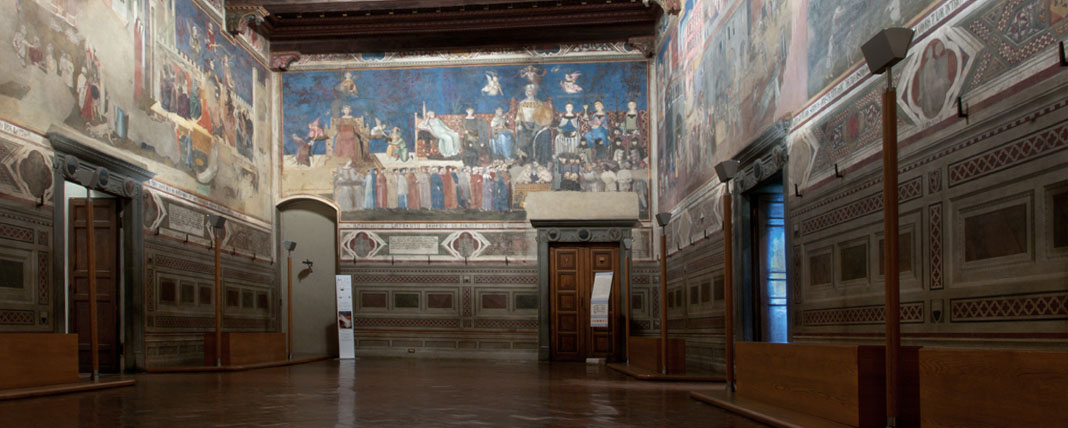

Years ago we students were introduced to the Lorenzetti works during an art history lecture that prompted an interesting seminar with Nicky Gavron’ née Coates; interesting also because she left the art history department and took to politics becoming deputy Mayor for London. Like the rope that threads through the Lorenzetti allegory we leave trails that link our actions one with another.
The room where these works still ‘live’ is in Sienna, the Sala dei Novae (Council Room) of the Palazzo Pubblico (City Hall); it is said they were painted to remind ‘The Nine’ of their responsibilities. The Nine were elected magistrates who sat within the three murals depicting ‘The Allegory of Government’, ‘The Effects of Good Government’ and ‘The Effects of Bad Government’. The last being in a sorry state of repair, ironical because many of our world governments are presently in much the same state.
The majority of ‘public’ works from those times were concerned with religion so this one interests art historians because of its subject and commission. Imagine our own English Parliament commissioning art works to sit within. Rather than works like those of Lorenzetti I would suggest a swop to eight paintings by Ad Reinhardt.
Ad Reinhardt's have no illustrative qualities of the virtues, justice, wisdom et al in the same way as Lorenzetti presents them but they do contain visual messages. Writing an essay about these two artists is tricky; on screen one cannot get near the paint quality or be in the same space to let anything flow out from the work and into you.
There was an enjoyable moment for me in a recent television programme when during an exchange between an art dealer and an art restorer the term "You've got a good eye" was used. The series of programmes follow the 'discovery' of a neglected work then through the highly skilled cleaning and restoration process to, hopefully, the restored status of a neglected work. Two easy aspects of 'A good eye' in this context may mean, firstly that the dealer has spotted a well-painted picture and secondly that the restorer has the skill to help us re-see its former glory. Matching pigments is always tricky but when a delicate work is being restored it's vital to be spot on; there are now machines that make possible, via spectroscopy, the analysis of original pigments used. Science plays a huge roll in the 'upkeep' of our treasures and certainly the great physicist Chandrasekhara Venkata Raman has lent a great deal to the analysis of used pigments; even so the touch of a skilled restorer with a 'good eye' is vital.
Lorenzetti was a thoughtful artist and when 'Bad Government' is restored the work will need a currently skilled 'painter' with a 'good eye'. The work, post restoration, will remain a Lorenzetti however and not have the name of the restorer added even though she/he might get a mention.
When the current government in Downing Street spent a large sum of money on a 'Briefing' room they might, but did not, have thought to add any form of allegory either new or restored that would remind them of 'The effects of good Government' or indeed 'The effects of bad Government'.
'See saw Marjory Daw' might seem a reasonable anthem for us to sing for our governments as they swing from right to left and back again …into and out of power. The desire to be fair for all our population seems remote from the current nine
Farnham school of Art
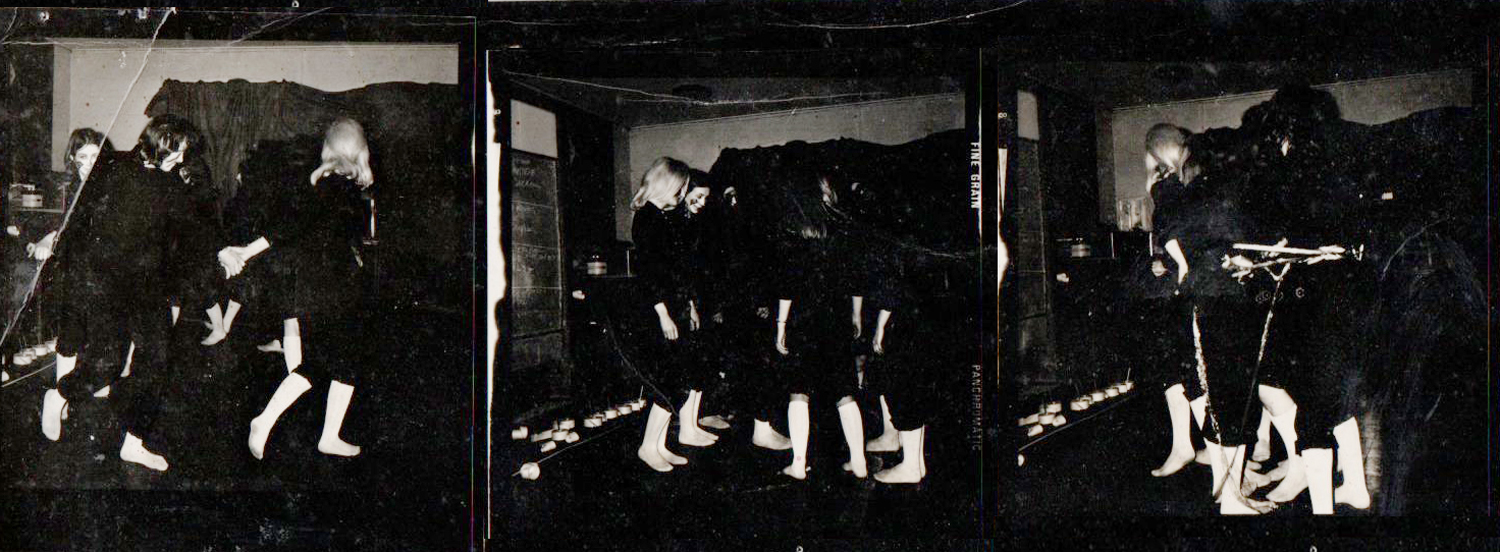
A large number of artist's web sites include the various places they taught; were I younger and not on the way out I may well do the same. Without any bullshit padding, the truth is I only really ever taught in two places and only well for parts of the times there anyway. Farnham School of art, now West Surrey College of Art, where I worked for close on twenty years was one of the two.
There were two main phases to the time I spent at Farnham; one was in the early years when I co taught, with Kay Fido, Performance Art as it was named back then. I have no idea if there are still classes in live performance art but there are plenty of videos being made. One of our early 1970s student performances, called 'Wall', has a 16MM film we made that I hope to locate and make available some day. The snap above was called 'Yellow Sock' and just goes to show how limited our means of recording was in those days, unless you had an interest in photography yourself and I admit to being hopeless with a camera.
Many students enjoyed the days we worked on this way of seeing the world and yet I was mostly nervous of pushing towards this particular edge of looking. Thinking back I think we ought perhaps to have made more tableaus; this form of art is not about the story telling and drama of theatre; Gilbert and George, two people one artist, made some performance works that reveal the difference between a visual based work and a word based one.
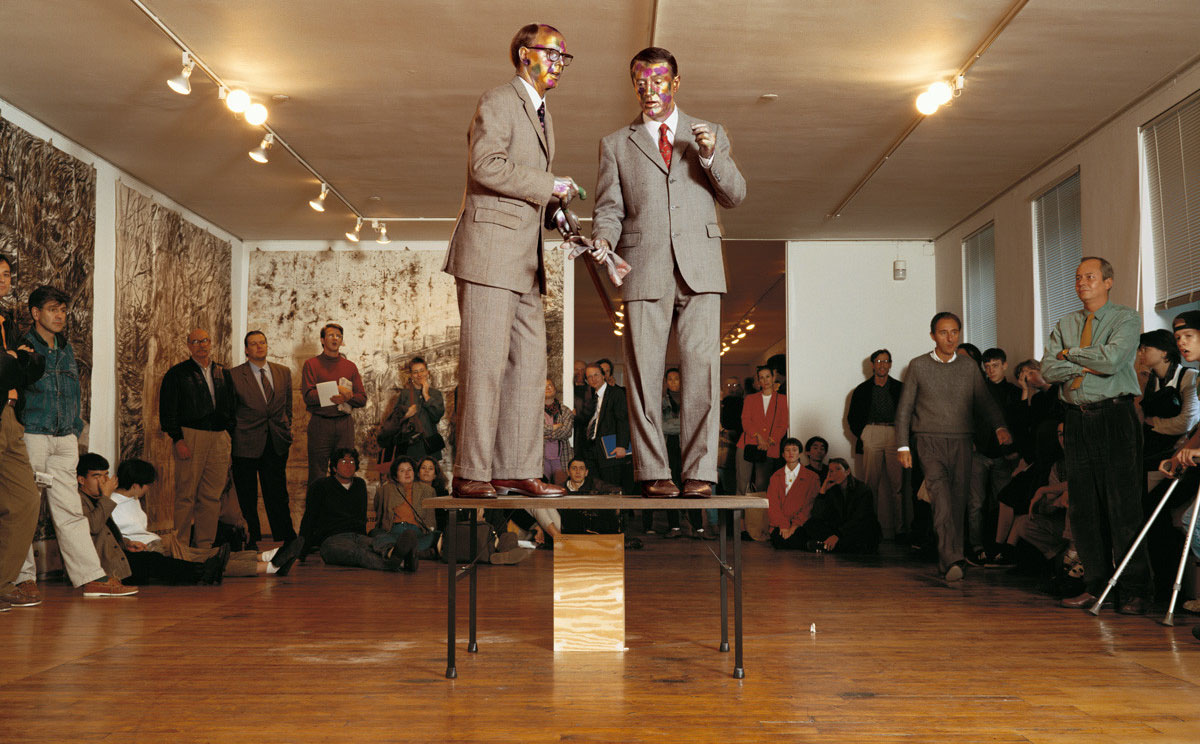
I know this is difficult because watching theatrical performance includes what it looks like but the essential elements are actors who speak. Performance art differs in that it is best at being still; were I to be working with students these days I would need to include a great deal of discussion on the nature of time. I believe that time is an essence of great works of art and students need to be introduced to its significance. I believe that this form of visual art began with Dada and continues to this day with artists like Marina Abramovic … well worth investigating.
For a lot of the years at Farnham things in my personal life screwed up my desire to teach well. I just have to hope I was able to hold my distress at bay; having to focus on the well being of others certainly helped me. I am unsure how or why performance teaching came to an end but changes of department heads have their effects and it may have been one of these that lead to 'drawing day' being on a Thursday. I was lucky enough to have worked for quite a few years on that day, helping students to see differently as they learned to draw. To my mind there is no better way to make the necessary change from words to visual thinking than with pencils and paper.
Drawing in groups is different from doing so alone; the
atmosphere in a drawing class holds, I imagine, a special memory
for many people. There may well be other things we do together
that are moving, absorbing and fulfilling but to my mind finding
out how to look beats them all. We mostly see in order to
recognise objects; you can leave the room because you know what a
door looks like. Learning to see things as a whole, to become
aware of the space between them and the distance from where you
are, is made different when you learn to record what this means by
a description/depiction made with a pencil.
It is not unlike learning to read, swim or ride a bicycle in that
the moment you can do it is tricky to explain.
I may be wrong in my foot stamping that drawing is the best way to alter the way you see; art schools may now have other ways unknown to me where this change can be made but some how or other I doubt it. The important thing is to agree that seeing the world as objects is different from seeing it as 'space'. A problem with this is that drawing is a skill that needs practice but it also needs thinking and talent can be a danger, not always but sometimes. Being gifted makes it possible for steps to be left out "… he had the gift so it wasn't real art" says Molly Bloom in James Joyce's Ulysses. "Loosing the arrow before completing drawing the bow" from "Zen and the art of Archery" is another way of explaining that we need all the steps to get the final thing right.
We so admire skill that we may well stumble around trying to define exactly what it is. Belief that skill is art can well lead one up the wrong path. When teaching you have to keep trying to help students find their place, their process and not transfer your own way. I'm sure I failed many times but hope the ones who 'clicked' still enjoy seeing the world differently. This 'click' moment can vary considerably in the amount of time it takes but teacher and student have to commit for it to be possible. One thing I know for sure is once a student 'has clicked' with drawing, time alters. Perhaps because when you begin to see the world as space rather than as 'objects' you unfold for yourself something than cannot be said. I hope this doesn't sound to highfaluting but I believe those who believe that to be good at it is luck are just plain wrong; at the very least it's hard work and hard thinking.
"Then what is time?' If no one asks me I know what it is. If
I wish to explain to him who asks, I do not know".
Saint Augustine
"Then what is Art?' If no one asks me I know what it is. If I
wish to explain to those who ask, I do not know".
When art begins to flow from the work into your essence you have found a place to be still. It is the gift of very few to go on and make it flow for others.
I have no clear memory of conversations I had with students about these issues; most exchanges were concerned with the practice, how to hold the work open so you remain looking and not making a copy for example or how to alter things rather than erase them. Though I sometimes feel I'm getting close to deeper looking I'm sure many students went on to be far better artists than I have managed. Many, like myself, remain at pyramid levels below the pinnacle, loving the work but not quite good enough to make a step into the public domain. It's a difficult thing to think about showing your work and we can easily make mistakes.
So many things are important when trying to put students into a place where they begin to see. One of the tricky ones I seem to remember is talking to a group and talking to individuals. Each student has to feel both special and a part of something else. I have three photographs of works by a young woman from my time at Farnham and hope she went on to enjoy a visual life; I found her fascinating because of her brilliance, her willingness to wait and her complete modesty.
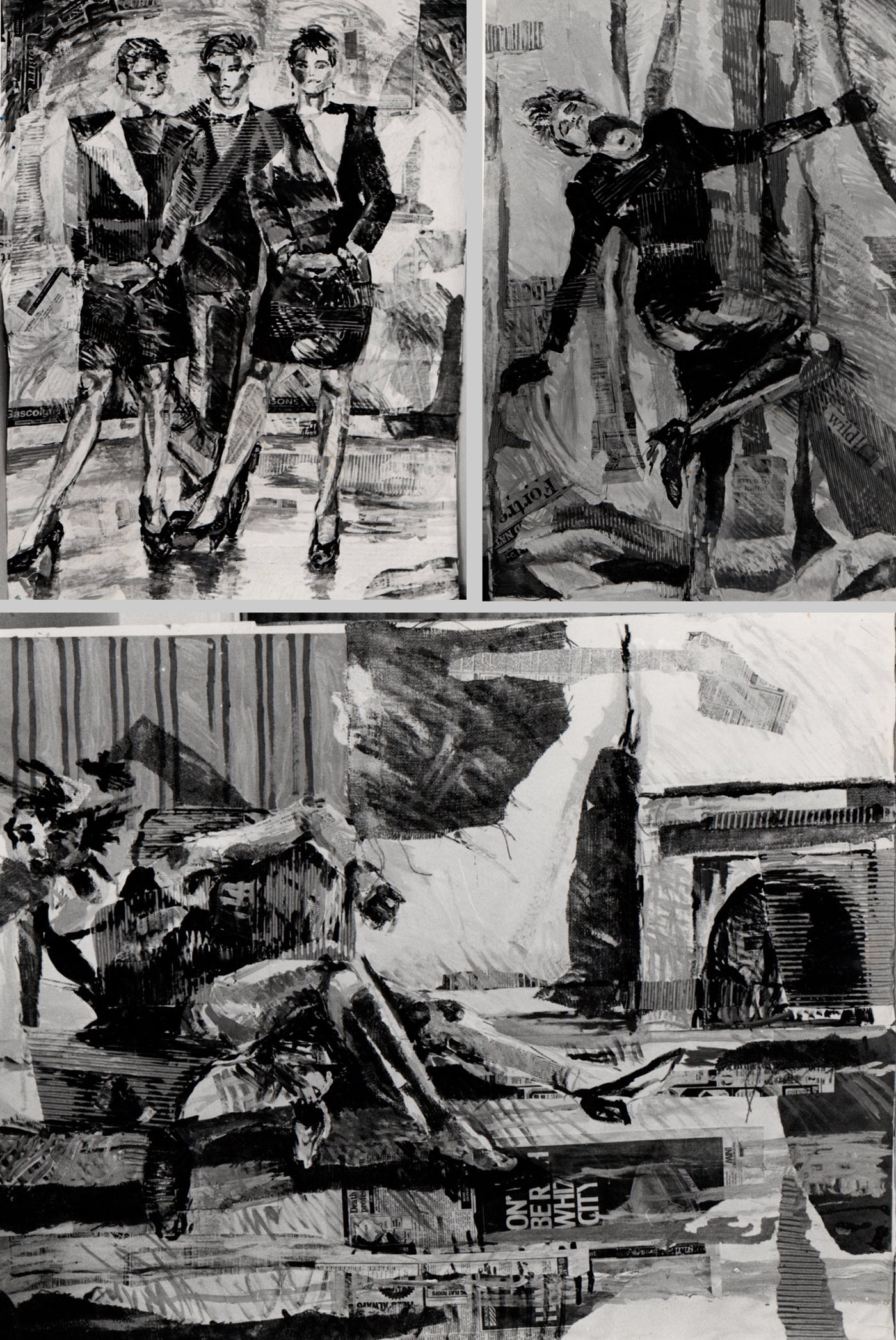
One of the things this woman quickly grasped was 'the rectangle' and its fundamental significance; one sees so many drawings that float in their rectangle. I remember Euan Uglow going on and on about this issue when I was a student and hope I managed to pass it down the line.
I tried not to repeat the subjects I set up from year to year though some blended into more than one theme. In the 'cubist year' I remember students being in a circle round a still life which I rotated a few degrees every twenty minutes or so until they had gone full circle. In the afternoon the subject remained still and the students moved from chair to chair round the subject. I wish I could see the results of this and hope I tried the same notion both early and late in the year's course. There are suddenly more and more memories popping back but it would be tedious to recall them all in this notation.
I was one of the mid eighties cut backs; I wasn't told, "You're no longer needed" but somehow or other I, along with others, knew it was over; it was almost certainly time for me to stop.
I loved the years I helped students with drawing though these days I wonder about the entropy in my classes … In thermodynamics you need a cold sink for things to function; in art you need a 'dump' even though there are elements you long to preserve. Keeping the fuel fresh is vital, so to my mind saying, 'It's new for them' ain't always good enough. It was just as well for me that I stopped teaching in art schools in the mid eighties; I was probably past my prime and needed to try something else.
Working Wall
This is a snap of a wall where I worked in the 1960/70s, a pretty grim snap I agree but it's one of very few I have. The thoughts it conjures are of me at another time when I was in another place. Since then trying to work out what art might be has been a fascination even if I can't fully explain what I've found out or for that matter very well delete.

I recently gave a talk to a small group of people in a science group I'd joined because I think that science gets as close to an understanding of 'where we are' as do the arts.
I kicked off with …
"At art school in the 1960s the nation was in the process of
swopping course titles and gongs and to my mind sadly, in art
schools anatomy was dropped from the curriculum. Anatomy is/was
an easy link between art and science … about seeing in order to
understand … we might refer to it as art illustrating rather
than art illustration but … "
Well something along those lines but the exciting part for me was linking, or trying to, Wolfgang's Pauli's exclusion principle with the kiss by Rodin and the decorative element in Gustav Klimt's painting of a kiss.
"Hold two strong magnets with like poles and try to push them together … now turn one round and recall a first kiss and the moment you both knew. Science and art are able to both repel and attract … unlike these magnets we are able to imagine and to actually feel a given strength…"
Slowly I began to lose my confidence picking up that this was not really going down that well. A zoetrope I'd made to show rotatory and linear forces was entertaining rather than engaging; umm I thought separation as well as fusion is a strong human quality. Stumbling on I got to the end …
"Years ago there was a public debate between Albert Einstein and Henri Bergson about the nature of time … science may be seen to speculate while in many ways the arts reflect so perhaps we could, with fusion, crack, the way time works..."
but it was a failure.
What do those old drawings and maquettes on 'my wall' have to do
with any of this? Well most of us are unsuccessful, after all
hardly anyone sees what we do. It used to bother me like mad that
no gallery owners floated through the window to my work rooms
declaring their joy. As a friend put it long ago, "Andrew, you're
a closet artist" and so I have always remained. The many artists
whose work is rarely seen may well be content as I am to get their
buzz from the work itself rather than the rounds of applause sort
by the pushy.
On one occasion when I worked at Farnham School of Art I asked the
students to read newspapers for ten minutes or so before a life
drawing class, they had to work out why I had requested them to do
this.
In our seesaw political systems where a nasty aspect of humanity
frequently dwells, most leaders are truly ghastly and yet they are
in continuance even on the increase. Magnanimous leaders are few
and far between leading to the fate of most people to be among a
few friends and acquaintances rather than happy within the
collective. I dislike capitalism and the conservative model of how
we should live and though held on high, the mantra, 'Democracy
Works' is a sacred cow failing to unite us.
Many of our leaders come from a tightly banded group of families
and schools who lie about their connection with the many. The Eton
school motto 'Floreat Etona' ('May it live Forever') is unlikely
to become 'Humanity begets waste' even in Latin 'Vastum facit
sibi' is doomed to fail. The children we all love are naturally
wasteful; we try to make them see otherwise but are poor in the
ways we relate to them. Filtering my vagueness into some sort of
positive act is quite beyond me, my work tends towards being
decorative … sans 'newspaper reading'.
It's all very difficult but we should not give up the struggle,
loving the opposition, even listening to them without despair is
frankly a bit of a nightmare. I once had a period of extreme gloom
and have been endlessly told to be more 'optoman'; the deep gloom
has left but as I have said in other places I suffer from/with a
melancholic echo. People are not schizophrenics though they might
have the schizophrenia illness and I am not gloomy even when as Mr
Churchill once said, "The Glooms are upon me". |It is unlikely we
will change our leaders to those who wish to share the joys of
life with those not in their group and as long as we clap and
cheer the rich we'll be forced collectively to share from time to
time Winston's remark of gloom.
Even after trying to absorb current news it's not possible for me
with truth to respond well to all of the current Art I see in
galleries; I feel closer to the Wilton Diptych than Damien Hirst's
multiple spot depictions but then I feel closer to A. D.
Reinhardt's 'Black' paintings than many of the Ruben's works I've
looked at … difficult, even silly to compare but I hope you catch
my drift. I still believe that our hope is in the Arts and that if
there were the sort of Christian God I don't believe in …
eternity, for me, would be in a life room learning to draw in
perfect harmony with one another, not pushing and shoving, lying
and cheating or making any attempt to be the best.
Bitten Cake

There is a lecture by Leonard Susskind where he speculates, or is
that proves, our planet to be a hologram. Mr Susskind is able to
deliver public lectures that are profound and penetrating; I like
to watch him in action even though I am unable to completely
'understand'. Why bother if you don't 'understand' a friend
recently commented which led me to thinking what exactly I
understood about understanding. As I tried to pin down my thoughts
I got more and more hooked on the notion of what it would mean to
us all if our world turned out to be holographic; in what ways
would this change our understanding?
As well as Mr Susskind's lecture I found some thoughts by Paul
Sutter … it seems that Black Holes increase their surface area
rather than their mass as they absorb matter. Like a hologram a
surface can have more information than an interior and if you
follow the two scientist's thoughts you get to the point where our
earth becomes a hologram. Their explanations are better expressed
than mine would ever be so if you're interested …
https://www.youtube.com/watch?v=2DIl3Hfh9tY
https://www.space.com/39510-are-we-living-in-a-hologram.html
Among the names we use as signposts to thoughts in physics is
Galileo, he began to notice via both thought and experiment that
it's hard to see where a centre might be. It's interesting for me
that Art helped me learn a little of this man's struggle to
introduce new observations to others. Bertolt Brecht, in
particular in his play Galileo Galilei, brought attention of many
things to think about, one of which was the significance of
movement. Understanding, there it is again, that the Earth is
moving at high speeds has little effect on our perception of being
at rest; so, understanding is different from perception umm.
I wonder if understanding means being able to write all the things
down in logical order? However, to my mind this removes the dreamy
aspect that comes with having the thoughts floating around one's
head. Both of these aspects seem valid for me in that there are
times when we need not only to be linear but also to hold onto the
possibility of tangential thoughts adding an unexpected value.
If I try to imagine the loci my life has travelled I cannot, even
so it's fascinating to dream 'not for a single second ever in the
same place'. Pause and respond to the feeling of stillness that is
not so; imagine the different ways we are moving; rotation round
the sun, rotation round the galaxy, our daily spin and the
expansion of the universe all with no sensation of it …
breath-taking.
I have spent a large part of my life trying to think visually
about what things look like and speculate that perhaps paintings
and visual Art has got to the point where we would benefit from
Gödel's incompleteness rather than fashion. Perhaps like knowing
we are moving without the sensation of it, we live in holographic
flatness and 'dream' our three dimensional sensations as reality.
Holographic reality could become a new wonder that adds
incompleteness to my world of looking; if Art was completed we
would not need any more but I for one cannot stop myself from
wanting to work. I am unimportant, I don't know but suspect that I
am average, yet I still sit for hours attempting to make a work
that's going to deeply touch other people. Understanding what Art
is, is almost certainly better off without 'proof and truth' so
perhaps the Gödel notion is another of my Art red herrings.
It seems to me that not understanding art is as important to me as
the times when transfixed by it I feel content. We are all content
to use things without 'understanding' how they operate; for me a
favourite one is that the structure of a cake is made by egg
white. I prefer not to go into this and try to find out more about
proteins, starch et al. As with most people I just like cake and
feel no need to understand it but don't mind others doing just
that.
When entering an Art exhibition we may well be asked, "Would we
like a headphone set to hear a commentary", I have always refused.
I'm vain and almost certainly an Art snob so why would I want to
hear a verbal description, I prefer to look in silence.
As with Gödel the notion that the Earth is a hologram is a
conjecture I cannot as yet complete, perhaps completion is
understanding but I doubt it; I'm in the league of thinking that
doubts. There must have been lots and lots of Art that was made
and never seen but then I have this crazy notion that unless it is
seen Art doesn't happen or exist even. Like the old 'does a tree
falling in the forest make a sound?' I believe Art doesn't exist
unless it is looked at; then, if lucky, some of it actually
travels from the work into the looker. In a similar way that I
like cake I like Art and science and sometimes even other people I
thoroughly disagree with and don't understand.

Bridgit Riley and John Foker
Years ago at West Surrey College of Art (WSCAD) I taught drawing and wish I had kept a better record of those times. As with the years I was a student there were a range of young people from various backgrounds, many of whom I imagine had been told at one time or another 'You're good at art'. Some, perhaps many of us, who have been lucky enough to have been to art school will have in a drawer or folder a few works we made from that time. What happens to us all after the student years I wonder and again wish I had kept at least the 'names and face sheets' of the students I tried to nudge towards deeper looking.
At the Mall Gallery in London there is an annual exhibition with works from members of the Society of Wildlife Artists, one is John Foker who was a student at WSCAD when I taught there. As I've said I haven't had much contact with students from back then but recently John wrote to me having come across my web site. I was, no am, delighted to have heard from him. We have exchanged a few mails and I was interested to see his work, for real rather than on a screen, though sadly I did not meet him in person.
Such a strange feeling came over me as I walked round looking at the paintings; firstly I had no idea that there was such a group and I had to think hard about how to respond. What I did first, I think naturally, was to find John's work by reading, then took off that pair of specs and had a proper look and think about all the work. I was though taken up almost entirely by the thought that John had been in a room with me some forty years ago and now here I was seeing where he'd got to. There's a café in the gallery so I bought a coffee and sat and mused about my thoughts and feelings.

The philosopher Derrida has a poke around the word 'parergon'; now I am aware he is both liked and disliked but this 'little extra'??? romps around my thinking to this day. Painting is so very different from drawing I sometimes wonder about the leaps we have to make from one to the other. Looking at the landscape on a walk recently I wondered 'which to do? which to do? paint or draw paint or draw?' … they are so very different …yet where the picture ends belongs to both. In this Mall Gallery exhibition I could see what I would get onto again when I crossed the river and looked at the paintings of Bridgit Riley.
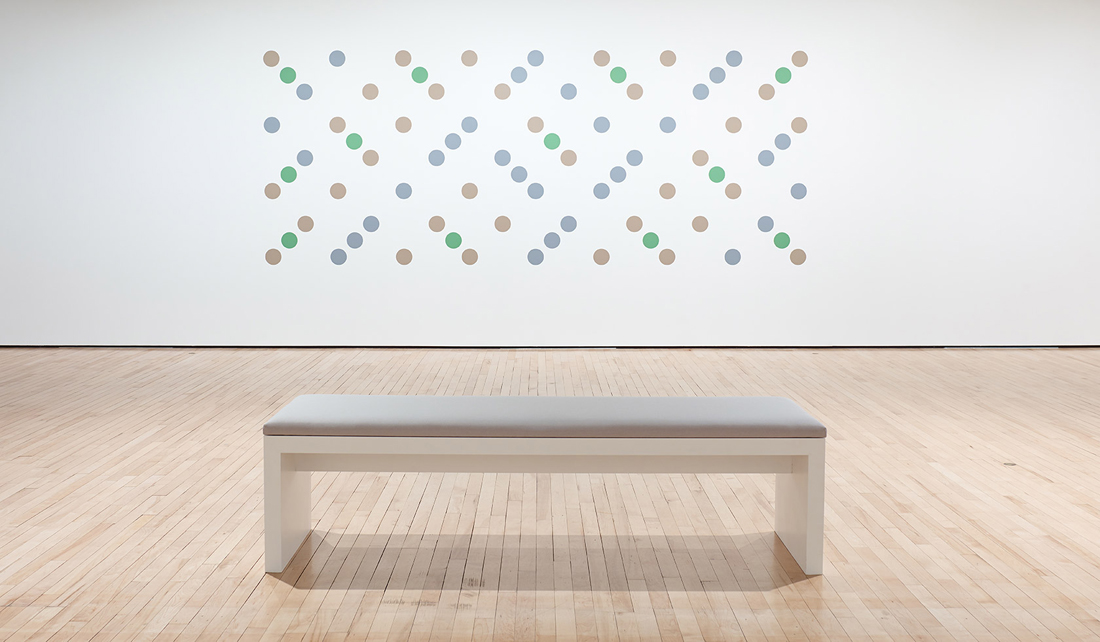
I went to meet Ms Riley when I was a student; this is how it happened.
As a student apart from the excellent teaching staff there were other artists I longed to meet; I foolishly dreamt I might one day soon join 'the well known'. Among 'the names' emerging in the 1960s was Bridgit Riley, I wrote to her and asked if she'd let a few of us Students from Camberwell visit her studio in West London, she kindly agreed. What a great experience it was. I can remember her new table she was greatly pleased with that had an adjustable height. On this she had the way she worked laid out for us; there were both drawings and diagrams all routes towards her paintings. It was a gripping experience; she was open and spoke freely about the processes she worked through towards a work worth having painted. Like Donald Judd, another brilliant artist, she worked with visual thoughts in time that could be made outside of it, quite, quite wonderful. How I wish I had understood it a little better back then.
Now filled with thoughts of 'parergon' from the Mall Gallery while walking across the Thames towards the Haywood Gallery where I am thrilled to see some of Ms Riley's works. In the gallery now I can enter her work, stand and stare, trying to see her working towards this depiction. The whole concept of 'parergon' is here with some stretcher works, others directly painted onto the wall sans edge. There are many art critiques[critics'] writings about these paintings to which I can add very little in what I think of as 'In the Manner'.
I have no idea where one would learn to be an art critic and write articles 'In the Manner' some of which are deeply helpful to 'apprentice lookers'. When I was a student there were a number of watchwords; one of which was decorative, to be avoided at all costs. Some essays though describe what a looker can easily see and I think we need a range of thoughts deeper than decoration when faced with complexity.
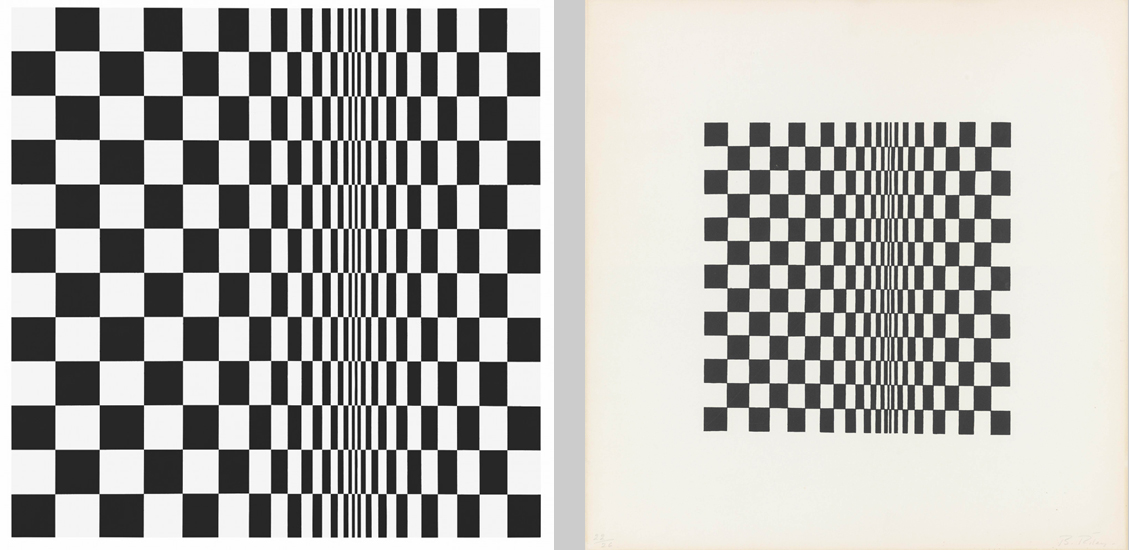
There is a limit to the number of repeats that can be made in patterns and it's interesting to have a look and think about the Penrose Pavement in Oxford. There are so many enjoyed, perhaps loved, works that are decorative. Art though is different and it's all a bit confusing. Brigit Riley knows which are which … tucked away on the top floor there are some works from her past revealing her first steps towards her humanity loving work. On 'the student visit' she took out from her rack a response to a work by Seurat I remember she passed it to me to lay on the table … now I'm in front of it hanging in the Haywood …
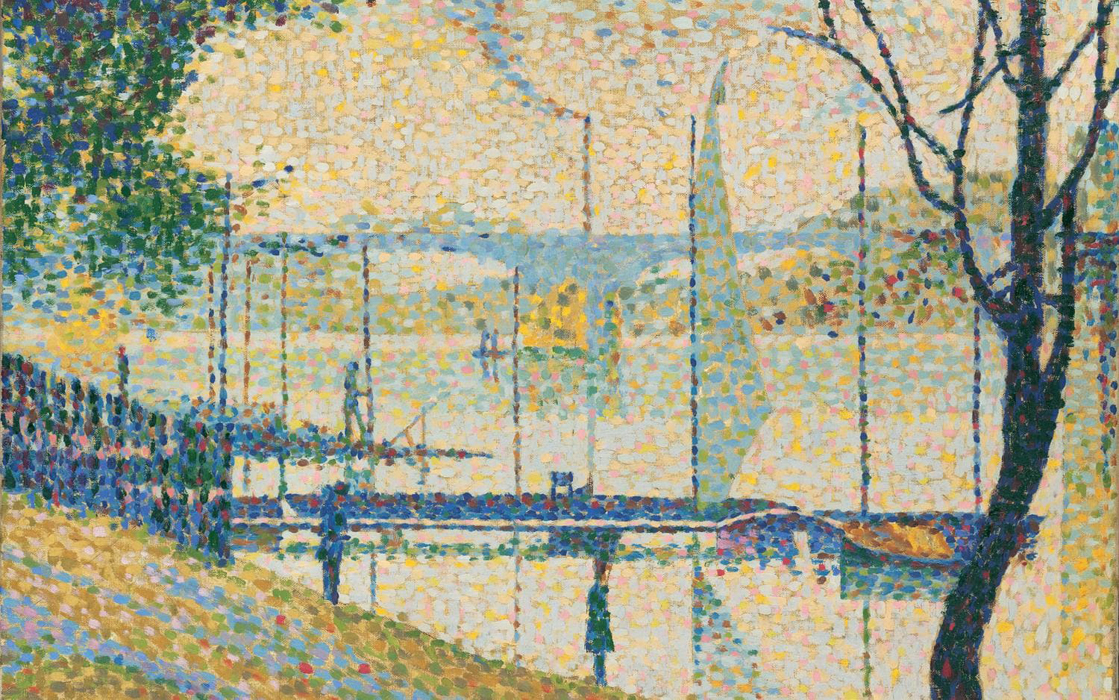
what a day, what a day. She looks with us
students at her 'Seurat' "I think I got the size of his/my units
wrong".
I wonder what memory really is as I stare with real joy at her
paintings …
I'd had a second brush with Ms Riley, I expect she knows nothing of it but Peter Sedgley might, he dealt with me quite often. In the 1960s they opened St Catharine's Docks by Tower Bridge to artists and both had studios there. Having been an electrical engineer I got a free studio in return for getting the wiring sorted out for the artists. Hanging florescent lights in her workroom I saw again her drawings and diagrams but this time I wasn't a student and we didn't speak.
As a student, and hopefully as a teacher, finding
the 'activated space' begins before you start to draw with your
pencil or paint with your brush. Sculptures and murals differ
because their edge is even more amorphous; after being a student I
encountered an installation and thought about 'the edge' but
there's so much one'll just never fathom.
What I feel most sure of is that the 'wow' we feel is not the
image alone but the context, composition, edge, parergen perhaps.
One day in the Italian city Padua I came up against 'a wow'
without an edge, part of the mural in the Ducal Palace's bridal
chamber painted by Andrea Mantegna; even so I hang onto the need
to feel the composition as well as work it out traditionally
… learning to be content without knowing what's ideal possibly
comes with ageing.
On my journey home I mused over my life spent looking, how lucky I
have been to have seen things. John Foker took me way back to the
few years I taught art students and hope I did manage to nudge
some of us/them into a world filled with trying to discover what
the world looks like. What a wonderful day I had.
[N.B. Parergon
I only came across this word via reading and listening to talks
about the controversial Jacques Derrida. I couldn't find the word
in the Oxford Shorter Dictionary but it is described on the
Internet:
Parergon
noun
1. FORMAL
a piece of work that is supplementary to or a by-product of a
larger work.
"the second sonata is a parergon to the opera"
o ARCHAIC
work that is subsidiary to one's ordinary employment.
"he pursued astronomy as a parergon" ]
Prints on fire
Among some photographs discovered 'in my loft' were these two.
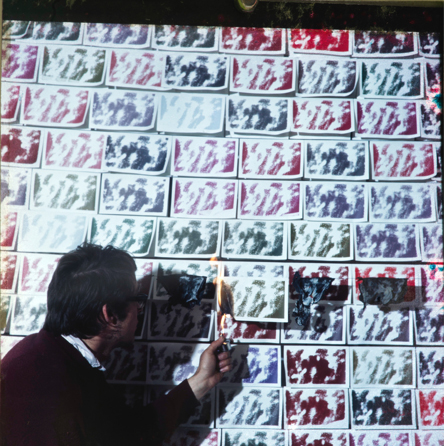
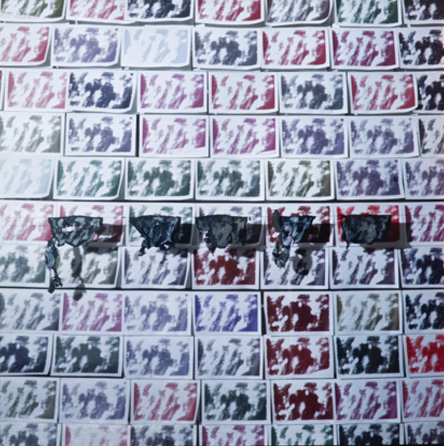
… probably taken in the late sixties when I lived in Camberwell and rented a flat in 'The Grove'; what ever was going on back then will always remain a bit of a mystery. I was heading towards what I might as well refer to as my gap years, not that I stopped working but rather that a form of vagueness descended upon me. Like many others at one time or another in our lives we face a nebulas selection from the world around us. Looking back I am so grateful that though more than a little wobbly I was able to keep some of my attention on an endless attempt to discover art. From that time there are works on plastic, a few drawings, some stacks of prints and other stuff, all-pretty much of the time.
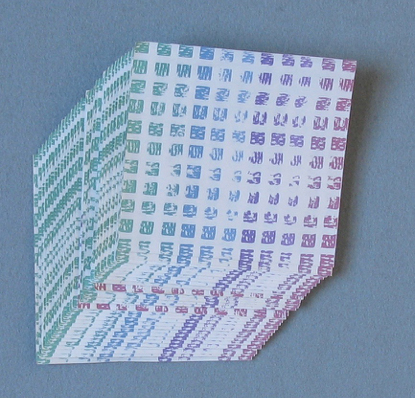
![]()
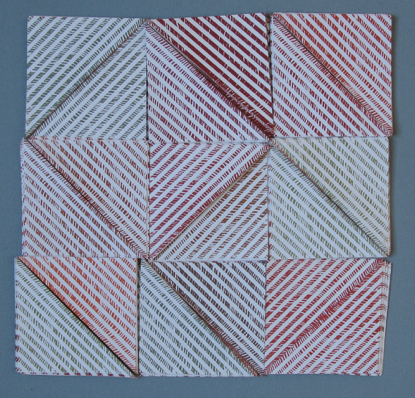
When these print stacks resurfaced I was baffled; what ever was I up to back then? Lots of the work was easy to see as 'fashion imitation' but these … umm. I remember I had shown some in a gallery near Earlham Street but it's all very vague.
A while ago I had the prints but not the 'Loft snaps' from my time at 171A, Camberwell Grove. Many years later, now in Dorset, I hung up a couple of selections and eventually this, which I think is interesting as a work in its own right.
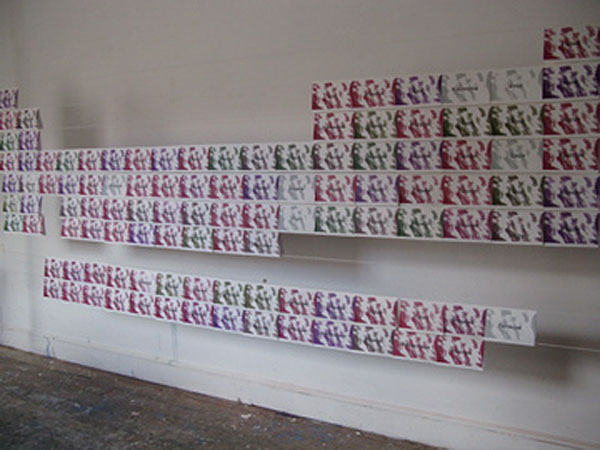
Burning the Periodic Table …
https://www.youtube.com/watch?v=HKDfEGkwT_E
… was a special event for me and even though hardly anyone has
seen the video it's not that bad a work; certainly there is the
potential there for a better one. What it needs is a rethink, a
re-film and a better ending. My plan was to put the ashes from the
burning into a cube I had sunk into the ground; the sides were
lined with mirrors and should have given the appearance of the ash
spreading out under the Earth's surface but, alas, another
failure.
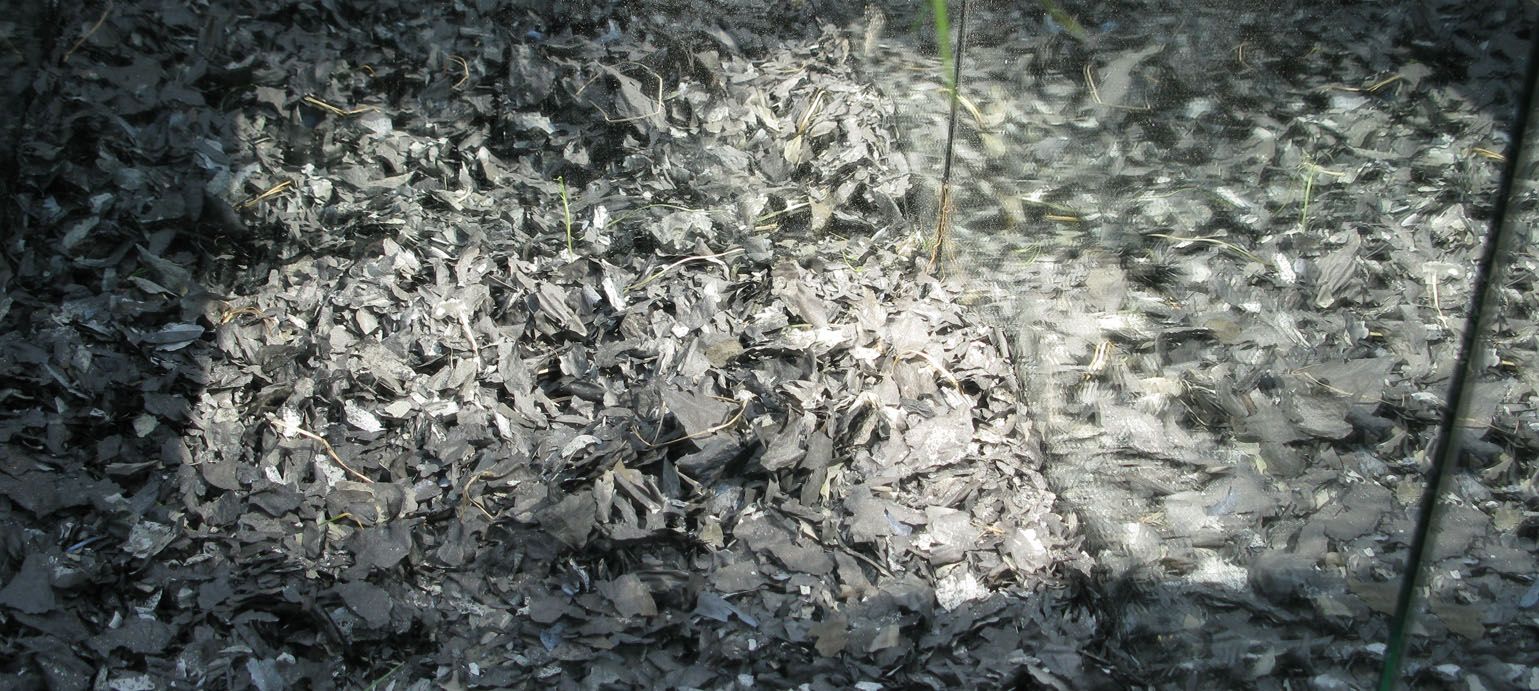
---------------------------umm
The changes in what we see presented by artists has had many twists and turns since I kicked off a life spent looking. Possibly the most fundamental change is that from figurative painting and drawing through to the idea of what looking might be ('funny stuff'). This might have, no almost certainly has, led to my being somewhat discursive; not so much from subject to subject but more doubt to doubt. Things are better these days because my nervousness of getting a work visually correct doesn't have an effect on anyone but me, well none that I know of. What I have never shaken off entirely as the years roll past is my vanity, how I wish I had.
In 'A la recherché du temps perdu' Vinteuil puts
out a score he has written for visitors to notice but then
declares, "I don't know who could have put that there". Vanity
might well lead to many of us indulging in similar acts; I'm vain
in so many ways. One of the vanities of the rich promotes a
temptation of wealth among many artists. It may well be
irresistible to accept large sums of money for your work but it
also bears the burden of making obscure work for a tiny number of
people. This could boomerang to accessible works but I doubt it,
more likely to copycat works that, ideas based, are imitation
rather than the thing in itself.
Among all the current trends there are works that are difficult to
relate to because art isn't only there to comfort. As ever I am
uncertain and stuck somewhere between works that promote our
deepest thinking and the lingering memories of what I was first
taught in art school. 'Good' artists desire wholesome sharing and
our brains have to grow with newly introduced visual work as they
do with music; think of 'The Rite Of Spring' now much loved but
originally booed.
We all have responsibilities, artists have a
responsibility to balance the things around us; to help us all try
at the very least to give up the things that bring torment. Even
though it may lift our spirits for a while it's not just there to
entertain; one aim might well be for us to see a route towards an
understanding of oppositions. This seems to me to be excellent for
not just current but rather all times; it's all too easy to stamp
your foot with personal desire. I do not mean this as literal
truth, that when you look at a work you should leave with a
sentence in your mind but rather an image of things incomplete
rather than unfinished.
It's no wonder that art is difficult with so many things to dwell
upon. All those years ago as I learned to draw reality was
altered; I began a tentative understanding of the culture. Though
not educated academically enough to fully engage or understand
that culture, I cared with my desire for 'a good drawing'. This
may seem limp or simplistic but my exit from an electrical
apprenticeship towards a kind of life I had never encountered had
taken a heavy toll from which I reeled for many years.
Being as arrogant as I was back then it didn't matter to me that I was wobbly; I wanted to make work that others would notice. My current visual responses to events around us have to face 'the blank canvas' with endless practice, my often-inadequate skill, visual intelligence and any gains from talent I might be lucky to have. I crave, along with many others, a unique presentation that I can wrap up and leave behind when I finally leave. When you die you may well leave things unfinished but you are complete; almost an opposite of my personal life desire. All this dissipation is my attempt to give an answer to the few people who have seen my 'Prints On Fire' and asked "Why?"
When, in my very first art school lecture, Michael Podro talked about the Parthenon my memories of 'Hero's Stories', told me by a primary school teacher Mr Williams, emerged. These were the tales that led me to the love of myths and the goddess Athena. Michael waved his arm before the screen depiction of the Marbles "Virgin, nymph and crone", he declared and his words still linger, what they mean now is different from what they meant then.
When we are engulfed with emotion and fuse it with an intellectual response we not only feel alive but also know we are. When I responded with three pictures to the Doge of Venice painted by Bellini I felt just a little closer to the wonder of art but when I burned my prints I felt a different kind of thrill.
These thoughts are certainly not content I do not fully understand them myself but I am so very glad they are there; for me to say to my self over and over "What do we mean?" is one of the wonders I have been introduced to. When I gave up one kind of life and tried out another I kept my sense of being overwhelmed hidden, at least I think that's what I was trying to do. When I set fire to my prints and watched as they burned I felt the presence of art even if I didn't really know what it was … well worth living for.
So here they are… click here for Prints on Fire: -
The Virgin print
The burning Nymph
The Crone as ash.
Teaching Art ?
In a recent edition of the R.A. magazine there are a number of interesting articles about the practice of teaching art yet not one of them says exactly what art is or even might be. This could of course be that it is too difficult or that saying what it might be merely a route towards disagreement. In the Academy's Gallery recently I overheard, "This isn't here to cheer us up." We were with the work of the artist Bill Viola, mostly projected images on video. One of his works, a triptych, shows a birth, a man afloat and a death, this was the work that prompted the remark; another work has a number of translucent screens being projected into and onto making a space to look inside as well as at. Reacting to his works varies as I wander from room to room, I walk back more than once to the 'rotating mirror room', here Mr Viola has a video presented onto a rotating screen with the mirror on the reverse side, it allows the opportunity to lean against a wall and watch as every now and then we viewers all see each other and ourselves reflected. The notion of its being easier to look at others in reflection rather than directly leads me to thoughts of us all being both together and apart. I am not content and wonder if that was Mr Viola's intention, well one of them, there are always layers of meanings to things well made.
There are also videos that freeze moments even though there is still a kind of movement or better said perhaps, an attempted 'Flow'. What I mean by 'Flow' is that wonderful connection you sometimes receive when looking deeply at visual art.
Remembering the other person's remark I too am not at all sure that these works cheer me but that doesn't mean I am not captivated by some of the thoughts shown to us. I am though somewhat confused by the inclusion in the show of drawings by Michelangelo. Apparently he saw the drawings and was moved by them then read some late texts written by the 'renaissance man'; these drawings and texts are on show alongside the video projections … umm … I think the relationship could have been better presented.
Showing a birth near a death video seems not entirely unlike an advertisement shown, also on video, at Waterloo station a few years ago. The advert's film left no doubt that "Life is Short" showing its momentary duration ending in a coffin. Of course they are very different in aim but in memory at least the sentiment that 'life is short' pokes out for us to register. Mr Viola's works are superbly filmed and keep bringing flashes from other works of art like the magic that Jean Cockteau or Robert Lepage both managed with works of film and stage both using water to transport us.
The techniques are splendid but they would not have the same memorable aspects without that seductive technology. Earth, fire, air and water are well known as the four elements of times past and Mr Viola uses them in another work that he showed in Saint Paul's Cathedral where two screen images seem to me to have worked better than the others.
Back with the thought that although we have 'Art Schools' we don't seem able to agree on what art might be. It didn't seem to matter to my generation when we were students because we mostly did painting and drawing; for many years that's what artists did but now the lure of a different kind is upon us all and I begin to feel once more like an old man lamenting.
A popular celebrity artist, I think in his Reith Lecture, paused dramatically and somewhat dismissively at the thought of Video art.
When I attempted one, a video notion of the periodic table, I also tried to link Water, Air, Fire and Earth far less dramatically than Mr Viola; I failed, mostly with the Earth part. In my notion the Table had to re-enter the Earth having been taken from Water into Air and burned. I'd dug a cube into the lawn where I was filming and lined the sides with mirror, my notion being that the ashes from 'the table' would be placed in the earth and appear to spread out beneath its surface but it didn't work at all well. Another one of my failures … but if I had enough cash I'd love to have another chance to approach correctness. As to the aspect of its 'videoness', well …umm … I think deep down I have a preference for stillness. With all the movements we now see in galleries I hang onto visual art being still; even though I am at times seduced by moving images, try them out even but … it is definitely stillness that turns my key.
Being taught to draw, taught to paint and introduced to thinking visually does not lead directly or automatically to understanding what art is or indeed the form it best dwells within. We all have to face our mistakes, to feel the joy of others' success and attempt to put the jealousy it often brings to one side; luckily self-promotion eases as the years pass.
Among all the planet dangers and fears of loss around us currently I lament our better days of visual perception and feel a different education away from academia would change many things. 'Drawing's about looking' was a chant I used when teaching small children and looking was, I hope, what we steered ourselves towards. Visual (Art) education begins with very young children and they can, if guided, begin to become visually curious; alas these days easy reproduction has brought a mist before our looking.
Dennis Healy was the only politician I know who had visual curiosity; at least I imagine so because after he died I managed to purchase a couple of his books many of which were about visual art. Mind you I don't know very much about his political views and how seeing altered his thinking but I think it must have because I am a believer in the chemical changes in our brains being as important emotionally as intellectually. Perhaps had he had more to do with education our children might rate the arts more highly and our art schools still teach students to draw.
There is a lot of confusion about looking; our head of department when I joined in the teaching of small children thought his rooms and corridors were 'highly visual'; how wrong he was! Overcrowded and en mass virtually nothing had an edge; in both senses of the word. The act of making things rather than showing them off afterwards maybe threw down an anchor for some children but I am as ever uncertain as to how much visual thinking they absorbed.
Alongside the Academy's Bill Viola show is/are, at the Hayward gallery, two artists showing their work, both are fascinating. Kader Attia's 'museum' from times past uses renewal and repair alongside views of a city in constant flux. I have been twice to see this show, his thoughts and parts of his exhibition are for me difficult to fathom even though I let everything go in order to just look. Repair is a brilliant thought I connect with; juxtaposing it alongside collected objects is, to my mind, quite brilliant. Making and repairing what's made relates here in ways that draw attention via our bodies as well as via objects. I am grateful that, in what may seem an irrelevance, my dad taught me to darn my socks; mend shoes; turn shirt collars and the wonder of soldering, all helped shape a deeper way of thinking, lucky me.
A notion of time itself seems to me to be
included in the works of Kader Attia and that brings thoughts of
two scientific models that are currently around about what time
might actually be.
Theory one is that time is a block or as I prefer it complete,
that for us change is an illusion. The other view is that time is
actually passing even if we know very little about it. There is an
interesting lecture presented by Prof Fay Dowker who knows more
than I ever shall about these two sets of thinking. My thoughts on
listening to her and trying to relate to the notions are that both
may well be true at least for a while and that we need to repair
our thinking rather than argue and disagree. It may seem like a
strange thought to relate a lecture on time and the work of Kadar
Attia but art gives access to un-academic thinking and I can't
deny my way of it being sideways as it were allowing me to play
with my thoughts.
Back in the gallery space I see within his exhibited work a stuffed cheetah not unlike the stuffed animals I saw in The Hornimans Museum when I was a child. As a child in that museum the animals were for me dead and alive at the same time; without me knowing it as a version of Schrodinger's cat, so another thought comes as I gaze at this fascinating work.
In' time' I am alive now and will be dead, when I am dead 'now' will I be alive in 'completeness'? If thoughts can be added like numbers, I add my understanding of Professor Dowker's lecture to my childish fantasy; the running Cheetah is here now and was then in the block rather with thoughts in developing sequence.
How lovely to drift in thought … a shame begun by
another artist I'll never meet to thank.
Upstairs in the Hayward Diane Arbus has her
photographs shown on pillars rather than walls visually linking
the two artists' works in different parts of the gallery.
In her space each Diane Arbus photograph has a title displayed beneath, somehow or other these titles seem as haunting as the images themselves but really it is the combination that seems to me to make art a possibility. The only way to experience this combination is in front of the picture with the title beneath, reading these …
Puerto Rican Woman with a Beauty Mark
Veteran with a flag Woman with eyeliner
Two ladies at the automat
Husband and wife in a nudist colony
Two girls on the beach Coney Island
Woman with a locket in Washington Square
… is not enough to bring an image to mind. Her photographs, looked at on line, don't seem to have their titles with them, it is very different, different as if something is missing, they have lost the possible connection that art brings between looking, thinking and being still. Visual Art in this instance as with others I have experienced seems to happen when the words fuse rather than describe. Perhaps this is one of the things 'video art' strives for ... an easier 'event horizon' that happens when one is lucky enough to… what? I can only think to describe as 'entering the work'… once there we undergo a change. Dare I say that photographs, videos and perhaps film relate to words differently from most painted works in that they have a different relation to time. If we encounter art while looking at a work it can be difficult to bear, bringing out emotional responses to life, into a fusion with our intellectual responses; our brains chemical exchanges attempt to tell us who we are.
There are plenty of works around that use image and text, plenty to my mind that miss the point, perhaps confusing fashion with fusion. I know that students tend towards an 'a la mode' moment, I certainly did and it took so very long to restart once I'd fallen over the cliff of despair when a Chicago Gallery owner put it to me "I like them Andrew, I really like them but I don't like them enough". Many give up but I didn't and realising that my work is for me to find out about art and not 'the thing in itself' has been a joy of life.
I know this is difficult terrain; the pursuit of
art is different from what art is. Looking at the photographs and
text titles of Diane Arbus as one I encountered the art
connection, so lucky me. It was not the overwhelming gush I have
felt with other art forms, there were no tears or gulps for
breath, no sentence I can cough up to describe. Perhaps Bill Viola
videos advertise that 'Life is Short' whether one is in a railway
station or a gallery and we 'lookers' feel the benefit when great
art enfolds us
At the beginning of our short lives some children like to make
things many of which are short term, daisy chains, sandcastles,
camps, even those ghastly images that hang limply on refrigerators
and what are they all for? Their splendour is not in what they are
then for the child or dotting parent but in what they might
become. We don't really know what happens in that wonderful moment
when pages of print change into stories or information but we soon
learn what the red pen indicates beneath our early attempts to
imitate it. I have not much knowledge of what happens in schools
and colleges these days but I have my suspicions.
The ever-expanding population, the destruction of animal habitat, the failures of our leaders, possibly even the collapse of Notre Dame, like the remark in the Royal Academy aren't here to cheer us up. We need the theatre, film, dance all of the arts to save us and keep us thinking and caring for one another.
We need art schools and children taught well enough to know they are a 'beginning' as well as complete.
Diane Arbus reminds me
As well as the 1970's snaps tucked away in 'Other Works' I have a collection of tape recordings, made around the same time as the 'slides', though for many years I had only a defunct Revox tape machine to play them on. These 'silenced' recordings regurgitated when, quite by chance, I found someone to repair my recorder. As I looked at the work of Diane Arbus some of the memory of that time returned, albeit somewhat vaguely, but certainly in a way that made my journey home edgily thoughtful … what had I been up to all those years ago?
Seeing the Diane Arbus text and photographs made a connection I may have been aiming for; almost certainly not as well as her but the notion of fusion was there at least I think and hope it was.
Still on my train ride back to Dorset other memories emerged … though I never met him, Bill Furlong came up with Audio Arts during the early 1970s and so I was almost certainly just joining in to a trend by wanting to make recordings. Sarah Petrie (a woman with a beautiful voice) and I got as far as meeting Brian Eno at Island Records and recording a quarter disc for Obscure but quite soon after that I was in my 'wobbly badlands' and everything from that time dissolved.
Sarah recorded my lists; two phrases I recall
using for longer works were: "No footprints in the snow, no snow".
and , "The wrong shoe on the wrong foot".
An older me mingled with the things I half did years ago is, I feel, worth at least a trial run and was certainly what I half had in mind with burning the periodic table now on YouTube (REF Andrew Wallace Periodic Table will get you there). The prints I used for that work were from the 1970s all I had to do was overlay the 'Russian elements' onto them prior to burning. So what about adding texts to the 'Tower of London' snaps … like this.
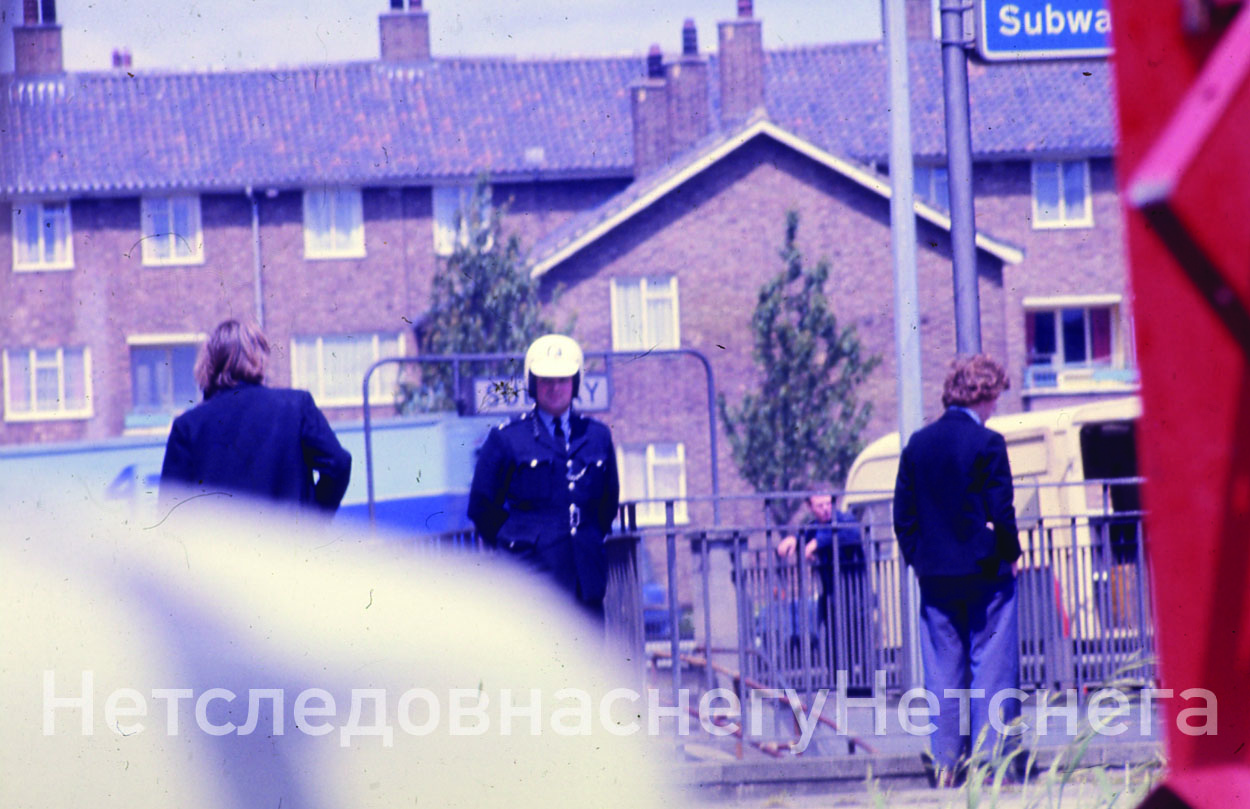
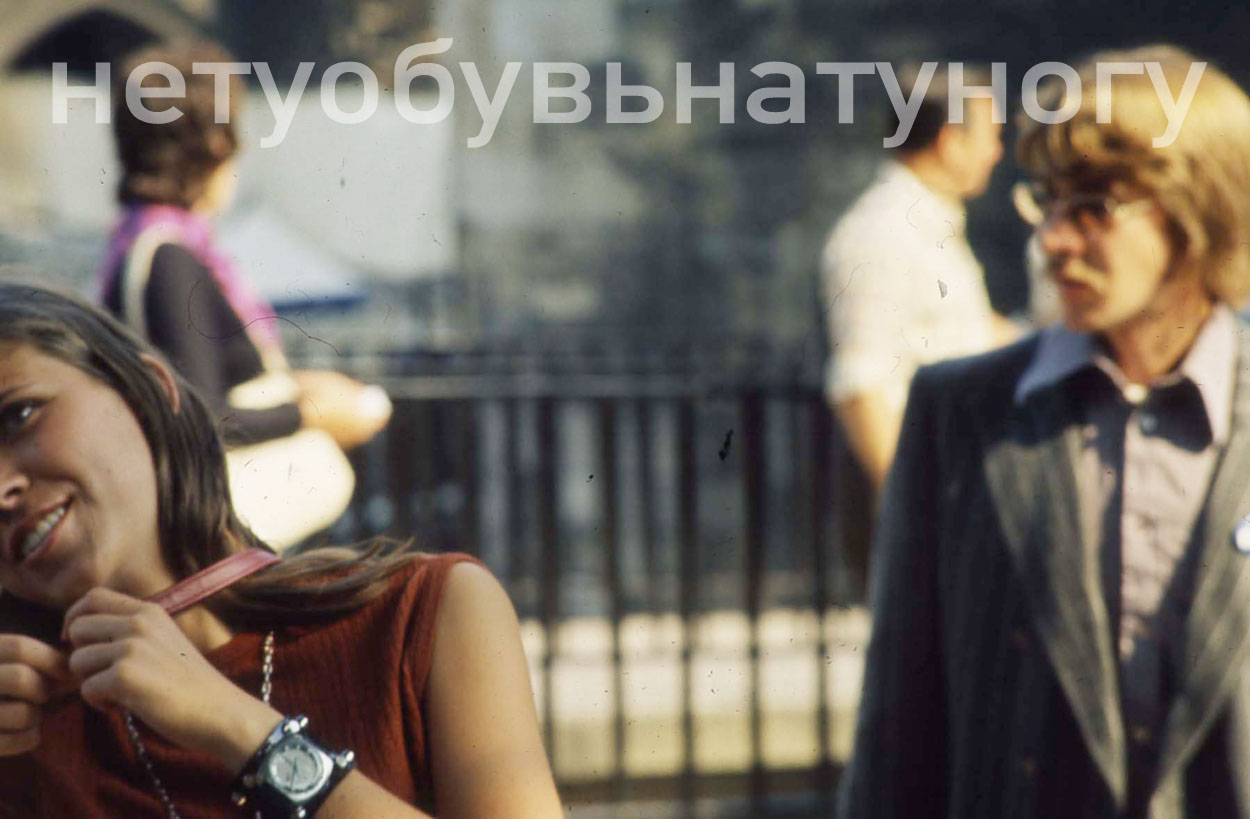

Remembering an interest in static electricity I had in the past I pop up to my loft store and locate two stacks of plastic prints.

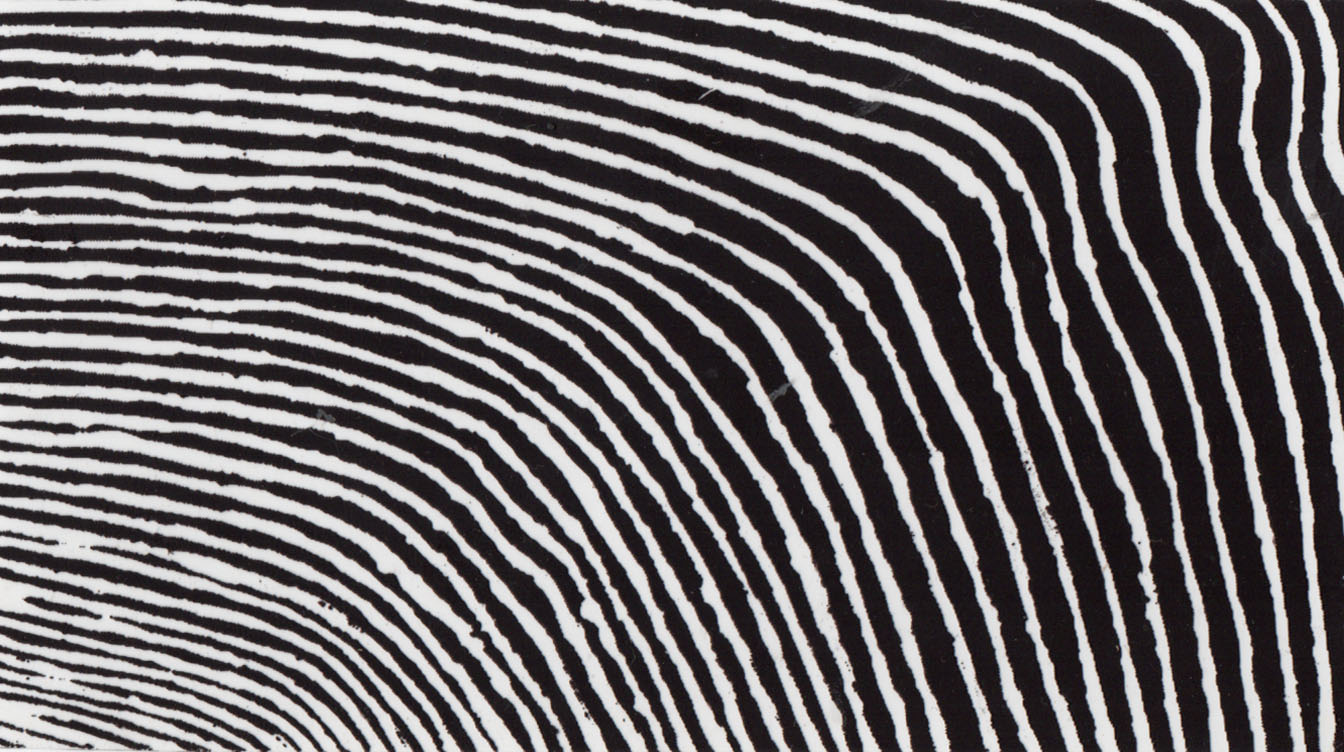
I have somewhere or other a photograph of the long ones of these statically attached to what was then my London studio wall. Playing with these rectangles now presents the notion of time then and time now. What I've wanted when I try to make art has certainly changed over the years along with my sense of self and being just another person among so many.
As I statically/temporarily attach some prints I
admit to an excitement as I wait for them to begin their descent
as the charge weakens. When I first watched this I was in my
thirties and teaching students at Farnham Art School now named
West Surrey College of Art. Working with another teacher and
groups of students we made/arranged what were then called
'performance arts'. We put on a couple of these shows at Oval
House in Kennington … umm … I wonder what kind of a work static
electricity is/was? … perhaps I meant it for a performance
Those younger years might have left better memories but then my view of art would be different. I still love to spend as much time as I can looking.
At the Van Gough show in Tate Britain there are many things to look at and think about; two drawings touched me deeply. One is a woman in despair with her head in her hands; she sits alone, a memory made with charcoal. Many people praise the Vincent emotional appeal and in this drawing its presence is haunting; on the opposite wall the same woman sits in another drawing but this is about looking in a different way, she is no longer alone. This second 'Vincent thought' places the same woman with others, who are all waiting for a pub to open. As I stand with lots of other people looking at a drawing made around a hundred years before my personal despair I try to imagine him with the empty sheet and the completed drawing at the same time. I have my pocket-handkerchief so no one notices a tear or two, then as I turn I see the same predicament; we share many things while looking at good art sometimes without knowing.
Memory of a Square
There has just been a show of some of David
Troostwyk's works at The Camberwell Space Gallery. One of the
exhibits there made me remember at the I.C.A a work he made called
Four Squares. I had talked with Trot about squares on quite a few
occasions and remember one of his destroyed works 'Three
signatures in squares' and a great storey about him getting Ronald
Reagan's signature in Grosvenor Square off Brook Street.
I was also minded that on one occasion after a brief walk around
the National Gallery with him we talked for a while about
Trafalgar Square …
"I don't much care for Trafalgar Square, it's
about the loss of trees and the column being visually incorrect in
height".
"I don't much care for Landseer's Lions or the other plinth works
either, not because of who they are or why they are there"
We mused that as a national square, this one seemed filled with all sorts of things none of which seem to us to relate visually in any way at all.
Like most of us Londoners, when I lived there that is, I have walked 'the square' and once with a friend Peter on our way to see a favoured painting of his, Middelharnis by Meindert Hobberma.
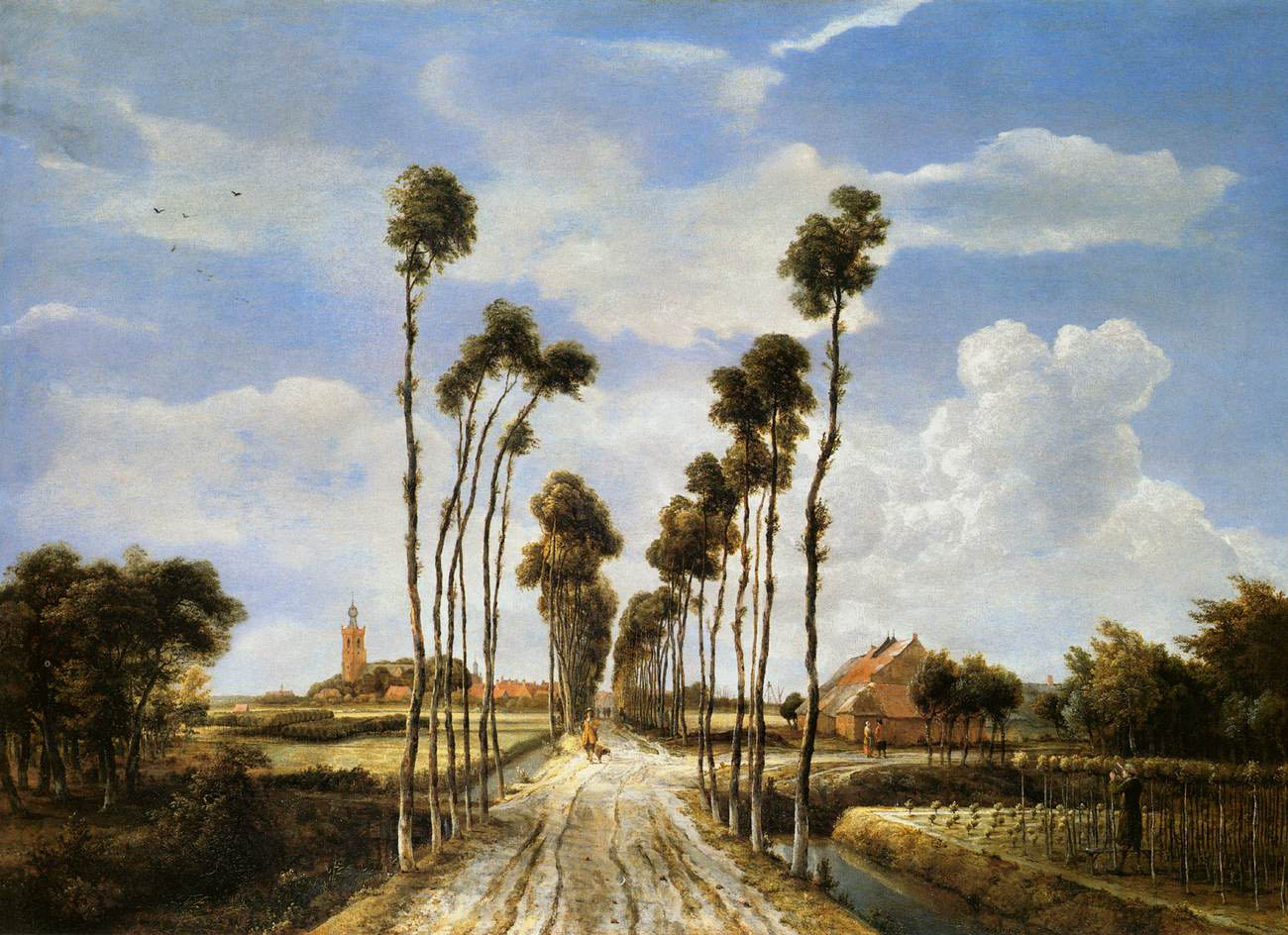
What perhaps I ought to have asked Peter
"Peter is Trafalgar Square a closed or open system?" or
"Peter is the National Gallery one of those open or closed system places?"
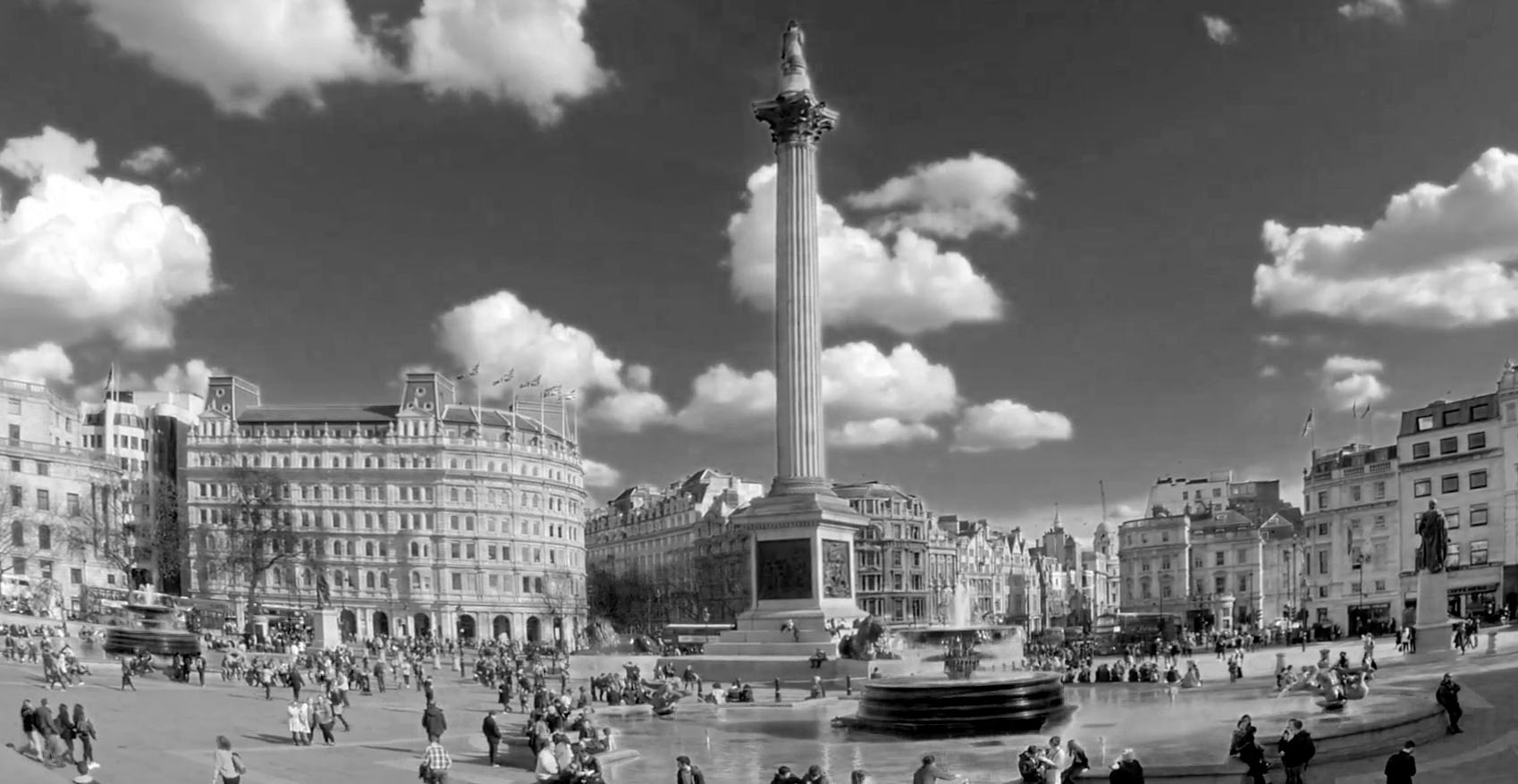
Like me retired, Peter is upside down; many of us live the life inverted though I was lucky in a way because it happened when I was quite young. We used to be hunter-gatherers but then 'work' and incomes came and we began to be upside down. When you get to be old you retire and many don't really know how to live because of the change from earned income to income via pension, this means there is time for real work if you want it, the few lucky ones take it on.
Lots don't know what this means because it's all so complicated and hard to sort out but many can be seen in museums and art galleries that they never had time for when they were completely upside down.
Peter loves chemistry and the laws of thermodynamics; whenever we meet, he lives in Sweden and lectured at Lund University, the conversation concerns itself with scientific matters.
Even with wide ranging and differing views of politicians, scientists and artists, all seem to think they have discovered the best way to live; these groups tend to be less upside down than most but they still are because they tend towards potholing and so are often very tightly squeezed.
Doing a thing that you like is managed by very few people and not always acceptable anyway; there are people who like guns and shooting other creatures, each other even, so, well … umm … finding a way to get along together seems impossible.
Thinking about all this leads me to one of the many reasons I like art and that's because I think that it can address a balance between differences; I like science because it seems to reveal states of affairs for artists to think about as they dream.
Since meeting Peter and other scientists I have become less intimidated by the scientific method and even though there is not even the slightest hope that I would 'understand' science it's great to share some thoughts with others who do. One of the complexities of this has led me to think about 'idea Art' in practice and the point of view when one is a student. I have during some science talks/lectures heard "I don't understand" and wondered what we mean when we say this.
At the start of the art student life many have sat in front of a model with pencil and paper as they learned to draw. What might be a thought here is just how long it takes before 'the skill' becomes accomplished. I suppose there is an equivalent in science lecture halls; by listening to the retelling of experiments past one learns 'a/the method' that one day will be applied by your self.
The brain is in control of learning for both art and science and I wonder if it would be possible to swop. Apparently with experimenting on mayflies you can switch organs somewhere along the mitoses trail until the 'inside out moment' and then you cannot. What this has meant for the may fly is all rather strange and possibly cruel but like security at an airport you usually can't return. As far as I know you can't switch brain cells though who knows what will happen next and like science fiction writers artists dream.
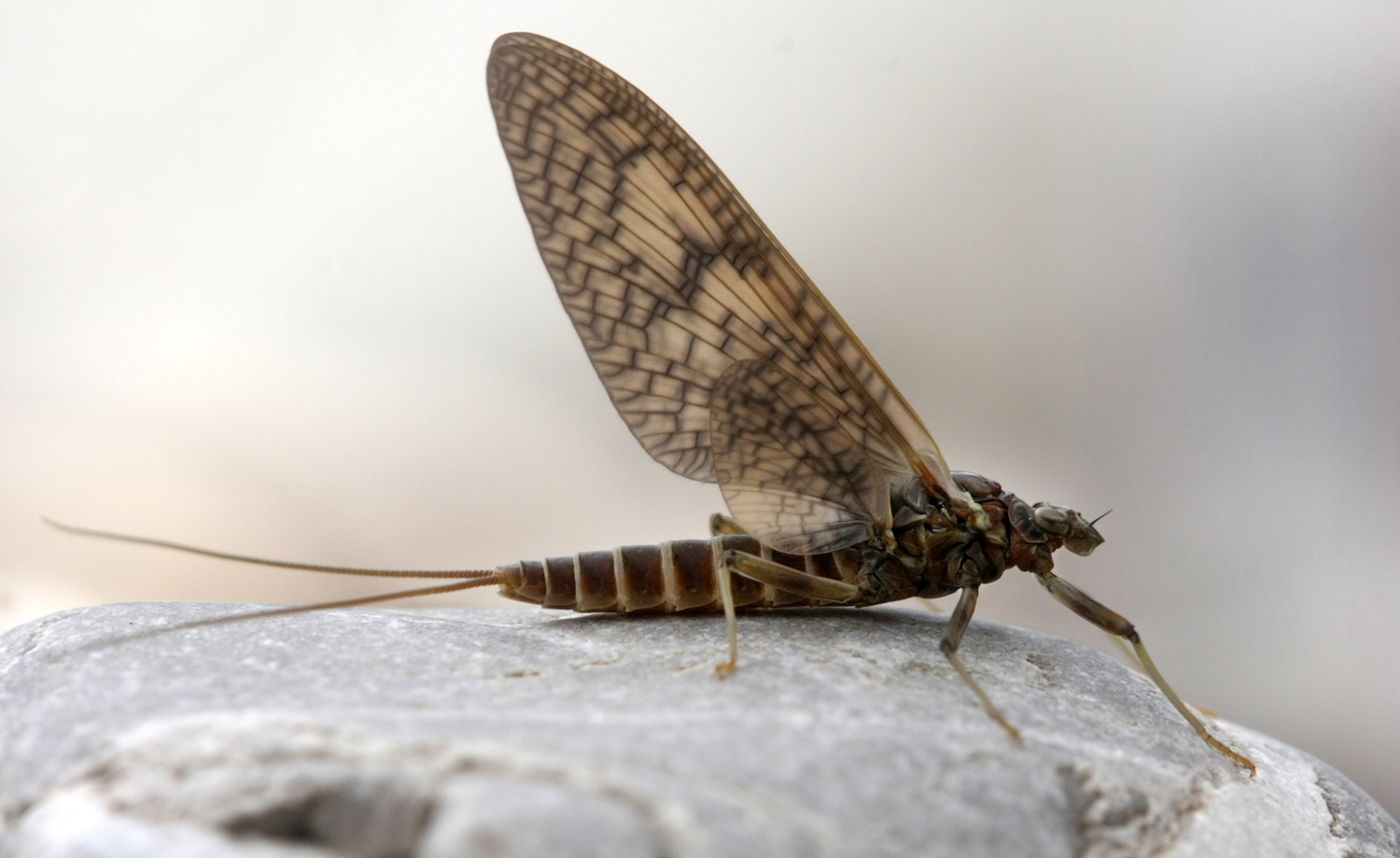
What has happened since Marcel Duchamps is the possibility of an artist working without any of the kind of training that existed in the past though, personally, I hold out a special corner for learning to draw, which seems to me to be an irreplaceable way of entering the dream world of visual art … umm … if ever we changed the narrow approach we now have towards education for children surely learning to draw in 'a good way' would be an absolute essential leading to us seeing the world in a different way from our responses with words … it would certainly be a way of removing dreadful eyesores from refrigerators and, even if parents are deluded into a notion that innocence is pleasant, the scribblings of children on their walls.
Art galleries still are places to go and look at visual art; our very own Tate is there to select for us all to see what is currently the most likely 'stuff' to become, in time, shifted to the National gallery.
In a bimonthly magazine I take an article concerned with looking points out that some conceptual works need not be looked at, as long as you have 'the idea' in your head there's no need to see it. The article by Trevor Pateman makes a case that's sort of against conceptual art; it's interesting and uses an example of 'A line made by walking', a work by Richard Long. I don't agree with Mr Pateman because the different ways that our brains respond seems to me to mean that seeing is very different indeed from being told.
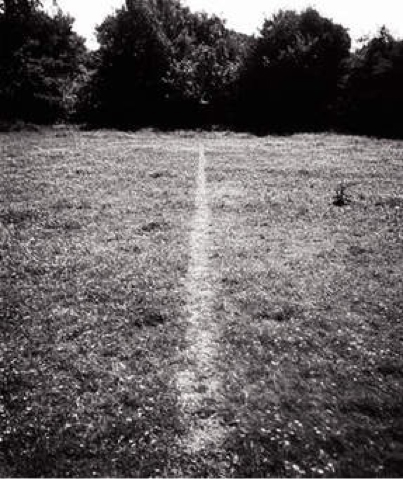
One of the sad things about looking at the moment possibly stems from another of the great Marcel's observations namely that of reproduction and the effects it would have upon the ways that we see the world. Now if you have the time listen to Phillip Glass's Music in Twelve Parts; you might like all the repetitions or like me prefer some to others.
One of my laments is that my drawing all to often needs a kick up the arse whenever I lapse into the tedious side of repetition but that does not mean repition dose not have it's wonders.
There are some who draw with ease in terms of reproduction of objects but that is not the only factor; we would, were we given the chance learn to look at space possibly even time were we taught to look at space rather than the world of objects. Drawing need not necessarily lead to visual art but it certainly would lead us towards thinking about being human in a place that we look at as well as speak about the things around us.
Back with 'The Laws of Thermodynamics' that
lead to open and closed systems; places with lids or closed doors,
trying to grasp the significance of these wonderful laws is often
far away from the way I think within but the effort to see what
others understand has been so good for me I thank all the
scientists who have introduced me to their worlds.
Many years ago half of the now National Gallery was the Royal Academy; I like to imagine these two halves to be separate enclosed systems with a third open one being Trafalgar Square. One can imagine within the world made from atoms and molecules that the movement of people within these systems is subject to the laws of thermodynamics as well as the rules of art.
If I dream of the gallery and the school as two closed systems I can imagine being taught in one how to look ion the other and hanging also in dreamland to Cribbe and Porridge Islands former places of the Trafalgar Square area one can realise change is always a possibility.
If two (the school and the gallery) closed
systems are joined they can exchange energy until they become
equal; Ludwig Boltzmann was mindful of the mathematics of these
exchanges but not believed by others of his time, sadly he
committed suicide leaving many truths to unfold for us all.
The laws of thermodynamics seem to be … no are special and though they have been adjusted over the years remain a scientific benchmark.
The eldest daughter of a friend is a vet on a walk we shared a while ago she stopped me by a field of 'ordinary' Friesian cows "I could stand here and watch them for hours".
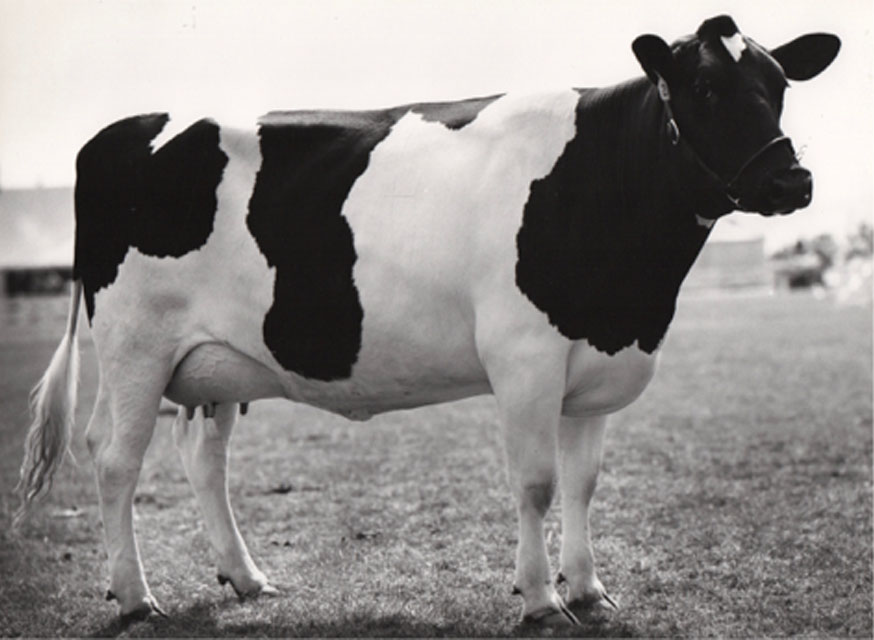
Buttercup, Daisy or …
Sirloin. Rump. Aitchbone. Buttock. Leg. Flank. Thin Flank.
Brisket. Prime Rib. Middle Rib. Chuck and Leg-of-Mutton Piece.
Neck. Head. Clod. Shin.
It was then that I thought I would like to enter for the Turner Prize.
Christopher Pinsent for Ewen
Quite by chance I recently met a cousin of one of my tutors from way back when I was a student. After chatting away for a while it became quite clear he was interested in tales of his cousin's earlier years so I wrote this for him.
Dear Ewen,
Having spent a few evenings a week at the Lucas Tooth Gymnasium
during my late teens I was pleased to discover that I could
replace vaulting et al with drawing classes. I went to Camberwell
School of art on a Monday evening in September 1961 and drew this:
-
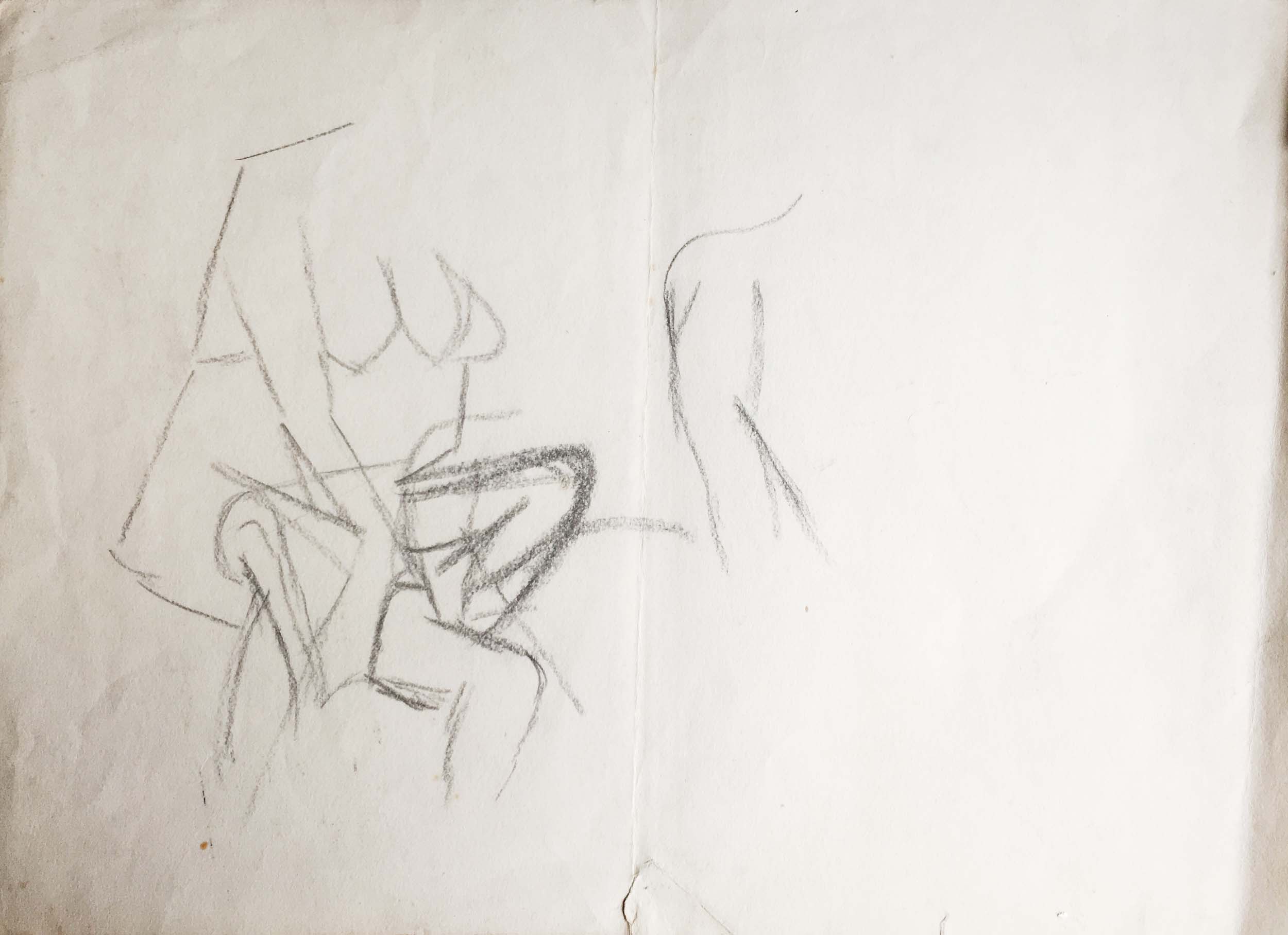
I can even remember the model's name … Bertha. Poor her I hope I did better after a few thoughts from the teachers.
This ramble may not be entirely about your cousin Ewen but I think the context may help you build a picture of his contribution to those times. I attended the college most evenings during the week and all day on Saturday. One of the teachers on Saturdays was Christopher Pemberton, who I later discovered got on well with your cousin making me wonder now if you knew him? I was in Chris Pemberton's class when I did my 'breakthrough drawing'; alas I no longer seem to have that one.
After the 'evening class' time and cutting a long story short, I spent a year doing O levels. Eventually my new life dawned and I became a full time student. I had not long finished being an apprentice as an electrical engineer and the change from 'knife, pliers and screwdriver' to 'Paintbrush and 2B pencil' was, for me, momentous. I cannot describe the contrast but have to say I am so grateful to my evening class teachers who helped me change my life.
Back then Art school began with a foundation year where we learned a variety of disciplines from which we chose our three-year degree course. This used to mean that many students who completed foundation had to compete for a degree place as they were limited. Somewhat unfairly some students, particularly young women, were rejected. It's different today, students have a guaranteed place from foundation right through to degree.
In 1962 Camberwell believed that drawing was the basis of all things visual and there was plenty of time spent in the life room. The atmosphere in those classes was so different from anything I had ever experienced; the quietness signified something very different from the silence of a classroom with a strict teacher. An important thing it seems to me now was that we were attempting to engage with a single aim. One, and only one, of the reasons drawing is fundamental to looking is because it happens in time; students collect information at different rates and edit what they see in different ways. One of the advantages of this meant that we could compare our progress. I think that our being in a group all engaged in the same activity allowed us to realise more quickly that thinking visually changes the way you experience the world. There's more to this than I have time for now Ewen but as I drift through these years of memory I may well hit it again.
At Camberwell we encountered a house style derived from the Euston Road school of thought. We not only received help from teachers but also from each other; a key factor here is the difference between spoken conversation and looking conversation; an easy example of this was when a tutor sat with you and talked but also drew while you watched.
Drawing took longer as the year progressed; in the early days we were often finished in a morning but gradually we became engrossed for whole days. There were many things to think about and the wrapped attention of a life class deepened as our foundation year progressed.

This is a drawing of Mrs Webb who, because I was well taught, revealed a beauty I tried to capture; it is not my best drawing of the year but holds a special place. If you look behind Mrs Webb you can see a cast of Donatello's Saint George. The school had plenty of classical casts that appeared in our work but you can also see from the set up that we were learning about composition, a passion of you cousin.
The teachers, lecturers, call them what you will, were mostly part time, enabling them to engage in their own work. The things they drew to our attention varied, it's tempting to say some were better than others but I think they all helped. What happened after the first year was different because we had opted for one of the disciplines and so the textile students, the pottery students, the printers etc. were en masse. We painters, now grouped, met our tutors in different ways. We spent weeks rather than days with them and they devised things for us to engage with over a longer period.
There was a rich mix of students who hailed from
different backgrounds, one was a young woman called Frania though
I'm not sure of the spelling; I remember her as being terribly
'posh'. Here I have to say Ewen that your cousin seemed to me as
also rather 'posh' and Frania chose him as her mentor. She was
confident enough to say his name across the quietness of the room
but his assistance was as quiet as any conversation between a
tutor and a student. Thinking back now one of the great things
about Camberwell was that class didn't seem to matter. I think my
accent changed at Camberwell from boiler house blue to whatever it
is these days. What a wonderful time I had there, not only
learning about what art might be but also the beginnings of human
exchange.
Although we had blocks rather than days we still had drawing
classes at least one whole day and a couple of our evening classes
per week. As well as looking and drawing we now took on figurative
painting in a more sustained way and here is a still life set up
by Christopher.
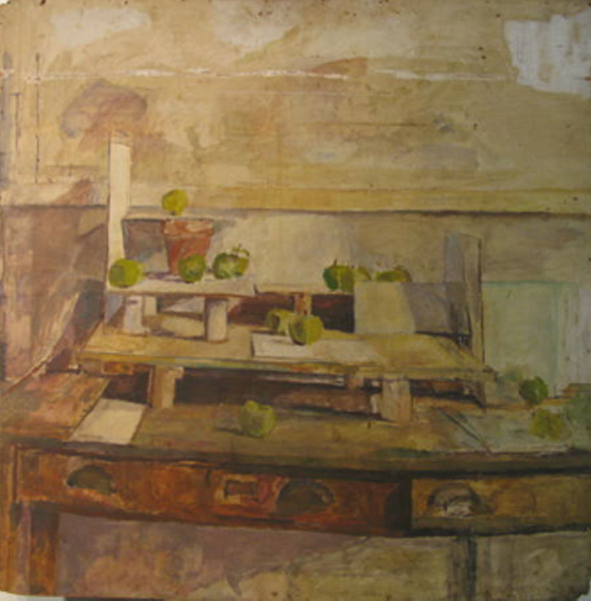
It's not a bad painting for a student but without the help of our tutors it wouldn't exist. This first year of degree course was managed/led by Dick Lee for whom I still have the utmost respect and admiration. He managed not only the students but also his staff and made a wonderful venue where I'm sure all of us enjoyed just being a part of his domain.
As well as figurative painting we also managed works like these

These would have emerged from blocks and herein lies the best 'Christopher' story. Our blocks were varied but one introduced by your cousin was not far short of extraordinary. He began with 'The Ambassadors' by Hans Holbein, a wonderful painting in the National Gallery.
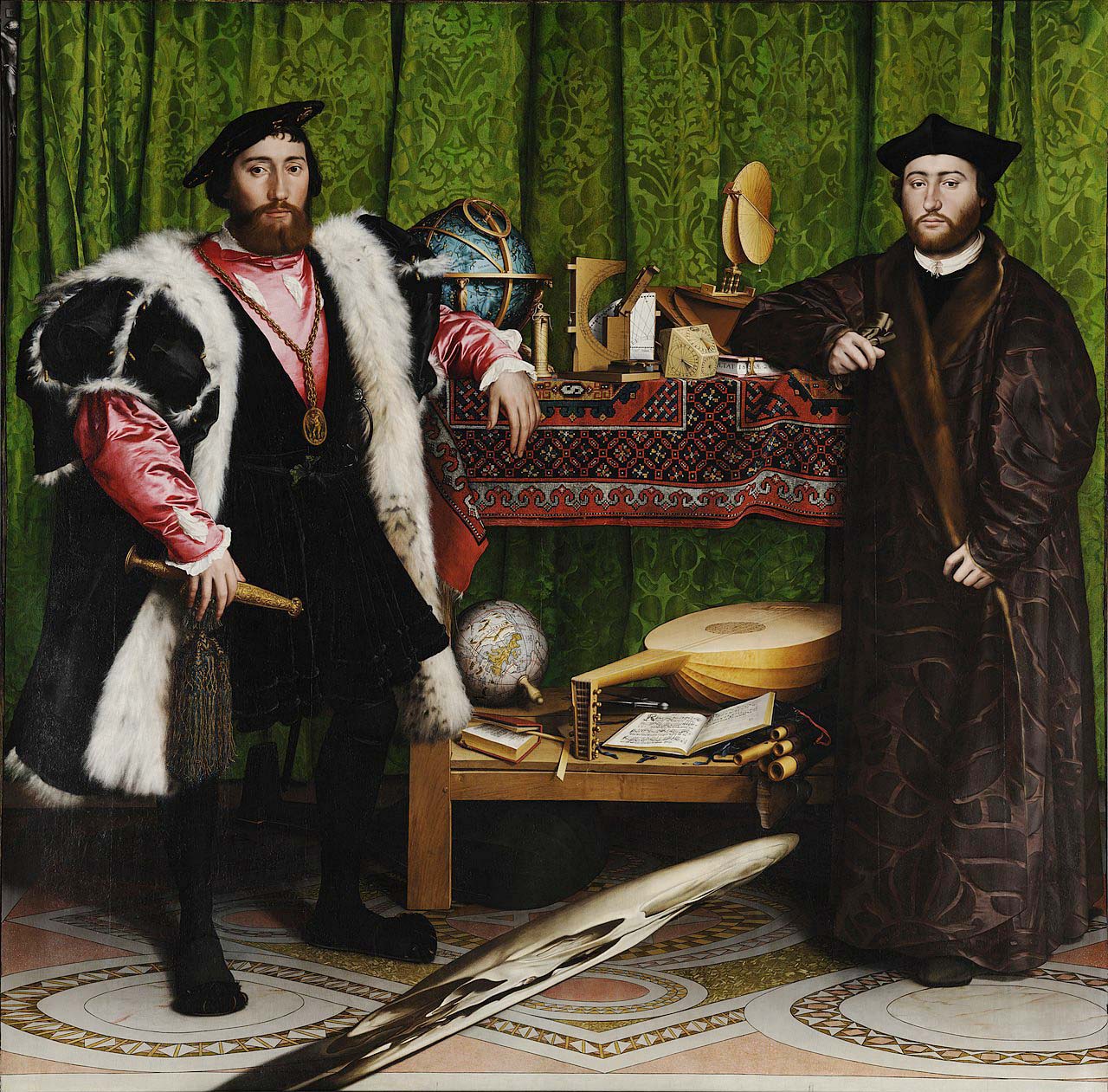
Art historians love this work because there are so many things they can talk about without a mention of art as visual as they hang onto art as linguistic message. It is indeed hard not to refer to many of the painting's wonders as mores of "Georges and Jean's' time. Christopher may well have done so, I really can't remember but I know he talked extensively about the 'skull'. If you draw a line up through the direction of the skull towards the right hand side of Hans's picture, so as to be about half way up the rectangle you can see the scull with ease; then if you flick your eye up through the right hand eye of George you'll see in the top left corner a crucifix.

The distortion is managed like this
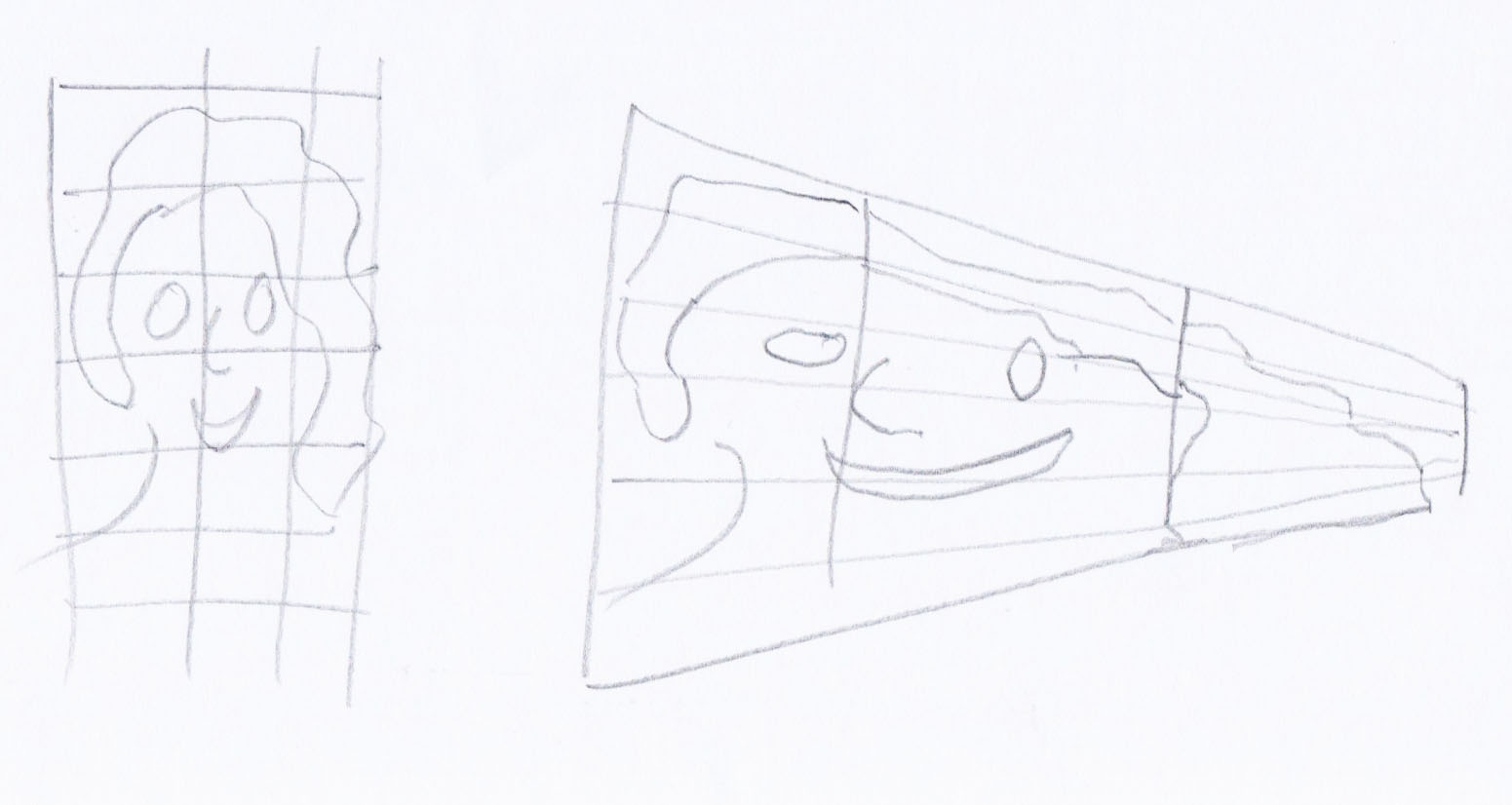
All you have to do is have two grids with the same number of spaces in each; even in my quick scribble you can see how it works. Years later, by the by, when I was teaching students at West Surry school of Art I helped students of one year to manage distortion and they loved it. I began with Rupert Bear images but your cousin stuck to the life model, here's what he introduced us to.
He arrived at the annex one day with a trailer attached to this Armstrong Siddley I seem to remember him owning but I may well be mistaken. Firmly attached to the trailer was a large frame about six feet by eight. Christopher had made the frame then threaded it with wire to make a squared grid. Part one of his scheme was for us to draw the model including the grid from various angles; having learned how to manage these gridded drawings we transferred them onto regular squared gridded paper like the distorted scribble above but the other way round. This practice was fundamental to phase two which took place in the school's playground.
We were in the 'Meeting House Lane Annex' that had been a school building for infants. It was single story, had a hall, three classrooms and a small playground at the rear with a shed for 'rainy playtimes'.
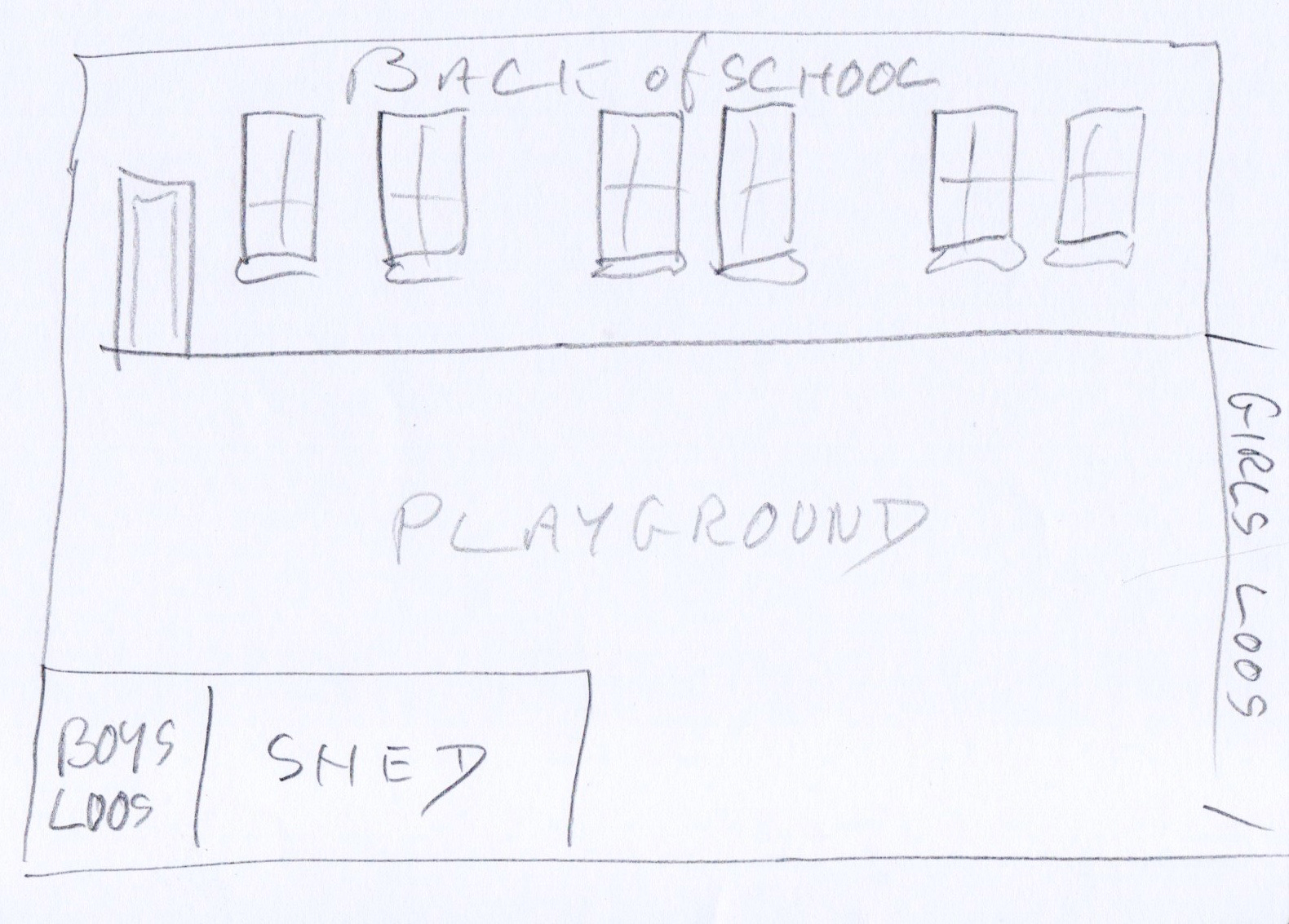
In one of the class rooms Christopher had constructed a table top plan/diorama of the playground that filled half of a classroom. Students in his group sat in the other half while he laid out his plan. Here I might say that we had had a series of lectures from Robert Medley on 'The Golden Section'. Christopher crawled under his model and disappeared until a flap somewhere around the Y or G in the above scribble and declared "I am now on the quad's golden section between the end of the Loggia and the girls' lavatories" … " I have marked the spot outside with a white cross" … "Each of you will be allocated a section of wall to work on …"
His plan was for us to paint distorted images onto the walls that would look 'normal' when standing on the golden section marker. I cannot remember the results Ewen, and in a way they are of little consequence, what I do remember is not just Christopher's enthusiasm but his deep love of art and that was what he gave us.
Once he talked to me of Grand Opera, of the emotion it radiated, then went on to describe the sets and costumes … umm perhaps linking them to grand depictions like 'Rembrandt's Night Watch'. He certainly was unique in his approach to composition stepping outside the Euston Road house style perhaps and introducing the notion of how to approach mythical subjects. There was also his tales of the wartime camouflage squad when he, along with other artists, came up with ideas to disguise various objects. He was proud of his antiglint device for rifles that reflected sunlight giving their position away.
Remembering what he was like he may well have mentioned Norman Wilkinson who came up with the notion of 'Dazzle camouflage' for protection of one set of boats from another and I wonder if he cross referenced it with 'Op Art' prevalent at that time.
|
Norman Wilkinson |
Julio Le Parc |
I made a mistake after I left Camberwell Ewen and walked away from a group of remarkable people. I should have popped back from time to time and said 'hello' and "thank you" foolishly I didn't.
Best regards Andrew
Syd and Roger Barrett
In this photograph I still see the Roger Barrett who was an art student at Camberwell in the 1960s. He stayed less than a year in the Painting department and no one, including himself I suspect, knew he would soon become Syd Barrett. One day he was in a café with my pal Tim and chatted about his idea to name his Pop Group 'Pink Floyd' which seems different from the 'spur of the moment' story but then there are many tales and memories of the elusive Syd; his legacy is possibly documented to the point of fantasy.
I hadn't thought of him a great deal post art school until his character appeared in Tom Stoppard's play 'Rock and Roll'; while watching the performance so lifelike was his youthful appearance that I stirred in my seat. There, on the stage, was not Syd but the Roger I remembered; elegant, handsome and dressed from the sixties, metamorphosing to Rock and Roll legend Syd. In the theatre a new notion of change was brought to mind; a facet of one art revealing another, like the maths mystery A plus B being or not being the same as B plus A … Roger and Syd may or may not be the same as Syd and Roger. All those years ago, had he remained 'the art student Roger', continuing to 'completion with paint', may well have become established in the nation's exclusive 'art club'.
One of the things that seemed to have touched Tom Stoppard was a change of an attractive, beautiful perhaps, young man to an overweight and poorly dressed old one. Certainly Roger's death in July of 2006 is haunting and, along with the shock of his appearance in the Rock and Roll play brought to mind "It is the transience of life that makes it beautiful".

Draped upon a car bonnet we see Syd's white shoes; men rarely wear white shoes but oddly I also had a pair in the 1960s though mine were shiny. Back then a good place to buy shoes was Gohils in Camden town, in operation to this day I believe; I bought a pair of boots there that lasted for years.

These ones though, the only item I've kept from my 1960s wardrobe, are not from Gohils but 'Derba', a long gone Soho shop I can't spell the name of. Thinking about shoes, the 1960s and Roger Barrett leads to Barbara Hulaniki's BiBa …umm it/she almost changed our appearance for the better though sadly shop lifting, along with other things beyond my knowledge, took her out of business. There was a brief shop revival in the early eighties that sadly came to nothing and many of us now look ghastly in shorts and tee shirts.

During Roger's brief stay at Camberwell school of Art Gerry Hunt, one of the lecturers at Camberwell, came up with a notion to introduce us students to current visual thought alongside the traditions of drawing and painting what we see. I seem to remember Gerry had 'Ten Styles' to engage us, derived from individual artists; one of whom was Robert Rauschenberg though looking back Kurt Schwitters may well have been used by Gerry as another inspiration.
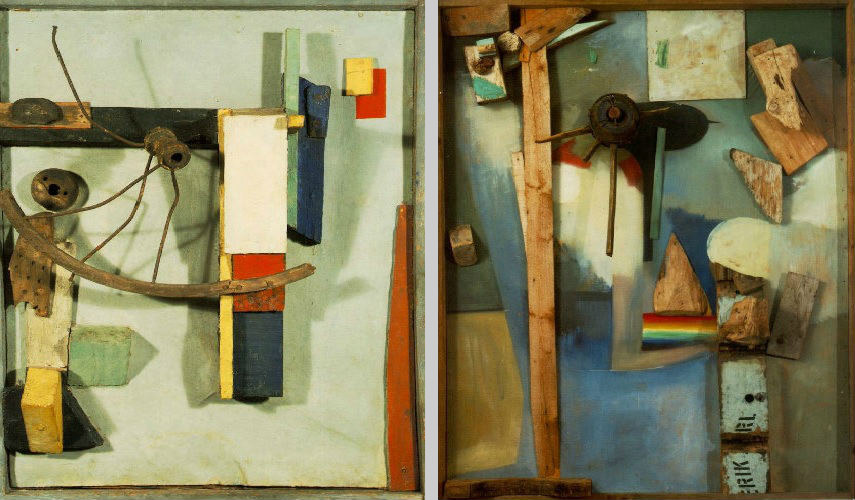
'Junk pictures' was the title we were given along with some thoughts and notions of how to proceed. It was interesting to experiment and we all seemed to be 'into it' so much so that they were hung on the largest wall of our Meeting House Lane annexe. Photography was different in those days and there is no record of any of our responses. What does remain is 'a child's anorak'; this 'memory fragment' is all there is of Roger's work at Camberwell, a while before he became Syd and altered his route towards art.
When the newly appointed head of Painting, Phillip Mathews saw our work the first thing he remarked was 'Whose is the child's anorak?" Roger was clearly 'of note' and yet he was soon asked to leave the college because Mr Mathews thought he spent too much time with his band. Umm or N.B. perhaps … Humphrey Lyttelton went to Camberwell School of art.
Had Mr Mathews not been a new broom perhaps Roger may have stayed a little longer, Camberwell being what art schools once were, oases for oddballs to feel comfortable for a while. Engaging with art and the art world are different from one another; I have read that Roger returned to visual art soon after he left the cut and thrust of performance and hope he found himself content.
Chemistry, snails and honeybees
Years ago my then brother in law took me round the Edinburgh University chemistry department where he was a student; I have two memories that remain distinct. As we wondered around the laboratories I was struck by a simple but obvious difference. Some labs revealed lots of equipment arranged in complexity while others revealed little more than a few test tubes on their benches. The real 'jolt' though happened after lunch; one of his lecturers who sat and chatted with us as we munched turned to me and asked if I minded … "We'd like to talk chemistry for a while"; I didn't mind and their exchange was indeed incomprehensible, I was transfixed.
A few years after my 'chemistry trip', at the Royal Collage of Art in London end of year show, I encountered a work of art that I am more than glad to have seen. After many years the memory might be incomplete but I recall it still as a relation between honeybees, snails and the incomprehension of 'chemistry speak'.
The artist was a might twitchy allowing but a few visitors in at a time; once in his room with 'the work' I was entranced having seen nothing like it before, or since for that matter. Imagine a household funnel but made from clear glass, greatly enlarged, inverted … umm … perhaps about six feet high; half way up the tube that at usual size might be in a bottleneck was a joint at right angles to the vertical. This tube was connected to a window giving access to the world outside; in and out flew bees fetching and carrying to their honeycombs at the top of the inverted cone part of the container. On the circular base just above floor level snails roamed free to munch on green leaves; the artist explained that somehow or other, (forgotten by me), the honey fed the snails and received a little something in return. In other circumstances one might well describe the work as an eco system but in a prestigious art school this was a work of art.
How or why I link these two quite different experiences into an almost single memory I do not know but if I think about one the other comes to mind.

In the National Gallery next to the Johannes Vermeer 'Woman playing the virginal' is the Pieter de Hooch 'The courtyard of a house in Delft'. In these pictures you can play with your inclusion within the painting space in different ways. In the Vermeer there's you then the pianist then the child as a painting in a painting making me wonder about flatness and that the way in is horizontal. In the de Hooch the brickwork make the space a different kind of wonder and the inclusion of us in front of his work a more vertical world.
Finding new ways to look is exciting; as I enter the gallery on the walk towards the first choice do I pause and allow a distraction or hold the focus. Today I remain cynosure, the two paintings are being looked at, I wait; I have the snail in a box carried all the way from my garden in Camberwell. I take out the box and open it in front of the paintings fairly sure this is the only snail to be in the gallery and perhaps the first snail to see them side-by-side. Afterwards I take the snail back to Grove Lane and release it onto a peach tree; I wish I could do the same with a bee but somehow it seems cruel.
This remembered trip I took was in the 1970s when
I was searching for a cure, a beginning perhaps; over the years
I've worked away at seeing these two superb paintings and wish I
could see them more deeply than I do; like one of the people in
Plato's cave there's more you don't know than you do.
Back with 'The chemistry conversation' that I found
incomprehensible it seems to me that I was lucky to have stumbled
upon a key to a way of thinking about understanding. Though in was
in English their exchange was of a different world from mine; like
the chemistry joke "What's H2O? (water) … What's NaC1 (salt)? …
What's H2So4 (Sulphuric acid) … What's C0 C0 A …umm … (cocoa)" HO
HO HO … you have to be lured into the frame of reference. At the
time I looked at the Bees and Snail work I had no notion of a
meaning and still don't, perhaps there are many, one of which may
be as simple as a way of looking. Remove the food chain link
thought then the juxtaposition of two apparently entirely
unrelated species and a beautiful mystery remain to be understood
differently.
Looking at a group of Andy Warhol's Marilyns …
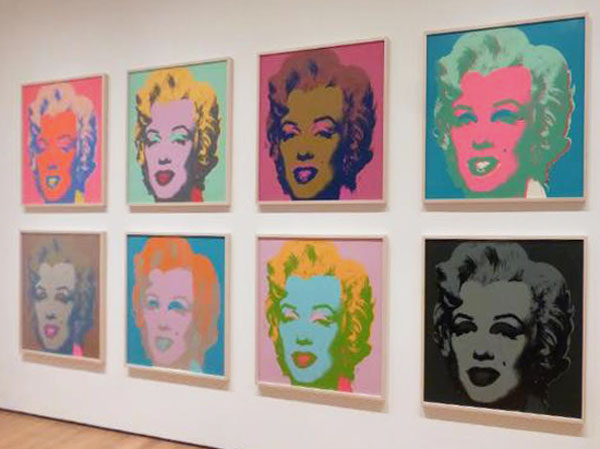
may or may not be easier than Carl Andre's Equivalent Eight
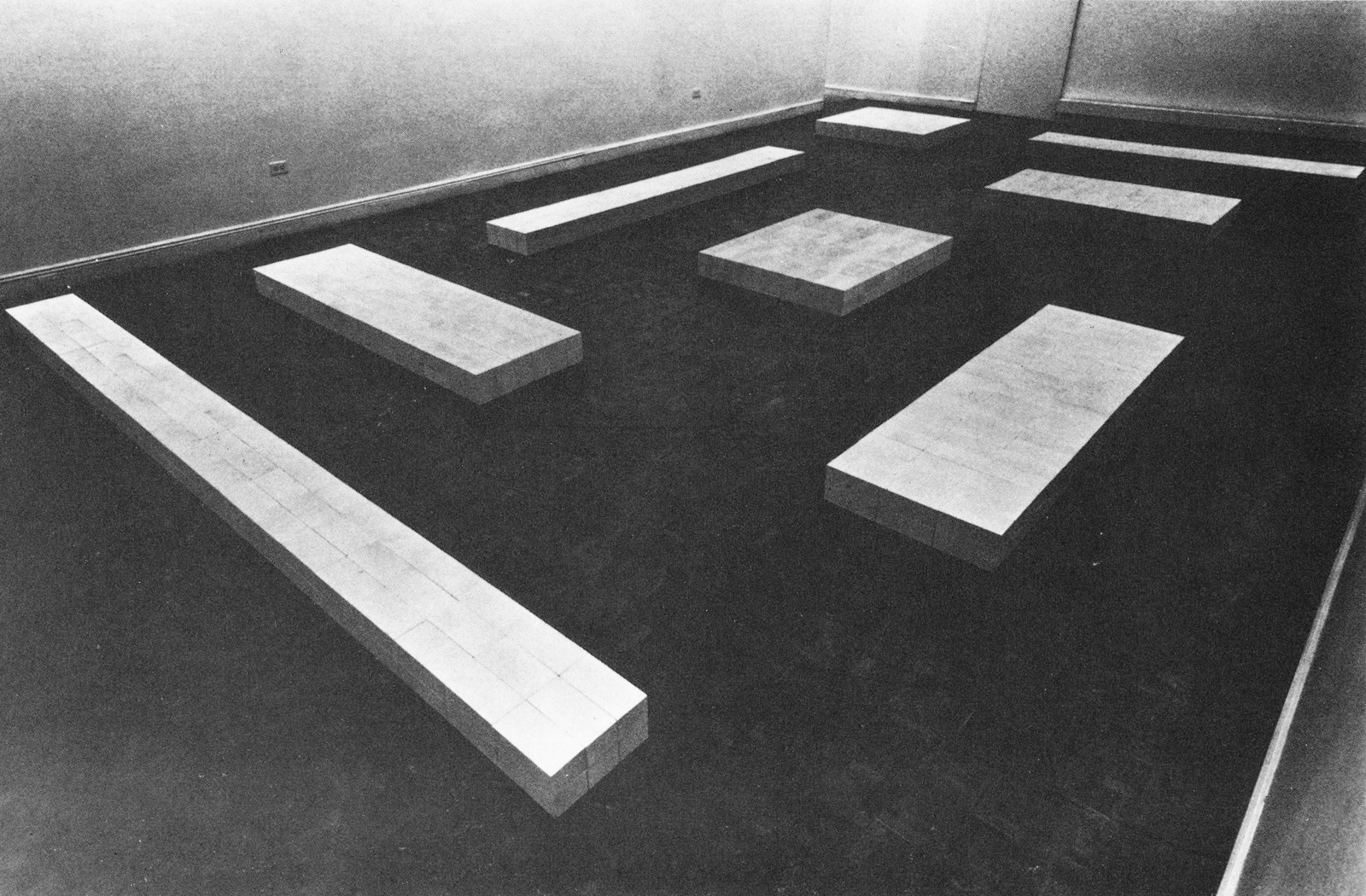
which strangely the Tate gallery bought just one eighth of but then again there are many more 'Marilyn's; does it matter, really ever matter how the thoughts come and go through our minds. Well of course it does but not always.
All Too Human
A recent mail popped into my inbox…
Hi Andrew,
Do you have an opinion on what the main 'movements' of art today
are?
A puzzle I can't solve.
Roger
When I/we were students the A. History department
brought Fauvism, Cubism, Futurism, Surrealism, De Stijl, to a
limited extent Dada into our thoughts.
Back in our seminar groups 'Mondrian's progress' was held up as
'this leads to that' progress; Monet to Pollock was another
version and it's easy to see why a desire for
procession/progression is popular though in my opinion rarely the
case
Manifestos for groups of artists were popular in the art history department and I can still recall the seminar when we discussed Marinetti's cookbook though not much of the detail.

Art History revealed the power of trends and schools from The Florentine v the Venetian to Abstract Expression v Field painting in American. On a simpler level at the art school, the feeling of being with others kept us going; though different we talked and reacted with one another. After leaving however our haven of painters became dissipated and only a few continued. The transition from being a student to becoming a member of the art world is tricky; those who make it are lucky or determined, pushy perhaps and of course talented as are many others who get left behind. It doesn't really matter for humanity who gets 'chosen' as long as there is greatness in there. We are not that far away from the conflict of prowess, strength or dance seen in animal behaviour. A sad thing is though that some things get lost along the way; I expect we have all known people who have been pushed aside; ask anyone to name the impressionists and few would include Berthe Morisot or any other women from that genre.

In the late sixties Op art began as well as Minimalism, conceptualism, performance and others. Then along came Post Modernism and in England The Saatchi Gallery seemed as powerful as the Tate in selection of the art of the day. The current gods of wealth, like the Medici in their day, bought the best works of art though I think that they seemed to seek uniqueness rather than works they loved. I could of course be wrong but Gallery art and celebrity artists flattened the old pyramid structures. What would help and still might would be a revival of movements and better connections among/with 'lesser' artists.
The Art group situation may have changed when wealth became possible for individual artists. Earning a living has always been an issue and wealth a common desire. Jeff Koons seems to be the epitome of the current vogue for wealthy 'celebrity artists'.
If we pop back to the De Stijl group there was a leader who's name I've forgotten and it's said that the group fell apart when he died. It may well have done so but he still needed the others to be a leader of and they were not just employees as with Mr Koons or those in the Andy Warhol factory. I have the feeling that Mr Warhol's factory had employees rather than 'assistants' as was the renaissance case. Our love of 'names' and the appeal they have leads to blockbuster and current celebrity art. This doesn't mean that Celebrity artists aren't any good but that the pyramid structure of art in particular groups has shifted.
In England we have 'National Treasures', people loved by us all; it may affect our understanding of art that we want to clap and cheer to feel good rather than think and consider. Celebrity Artists may well be tempted to reproduce saleable works; for example there are about a thousand 'Spot' works by Damian Hirst. Are these paintings good for us to learn how to see the world or just good for bank balances?
There's a current show at Tate Britain called 'All too human' and it perhaps wants us to see that while all the 'isums' were out and about some artists still looked and recorded what they saw rather than what they thought. As I walked around I thought I would have loved to have seen these works share the wall space with non figurative works done at the same time; a Brigit Riley next to a Euan Uglow for example.
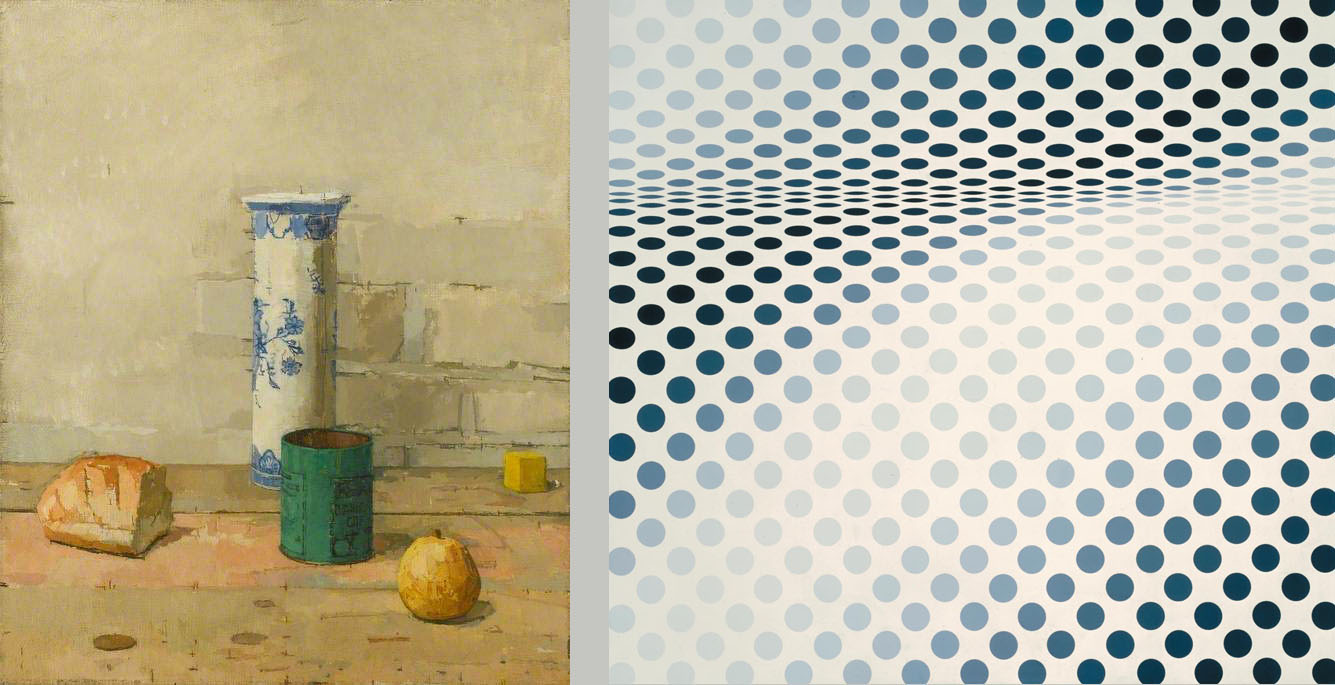
It must be so difficult to manage the current visual art world. I have no idea how like-minded groups begin but would love to see more of a community spirit among artists than elite groups.
Well that is interesting Roger and I've thought about it since you sent your mail; sorry about the delayed response but I gave a little talk to our Sherborne Science Cafe about the 'Harvard Computers' and was a bit nervous as they are a large audience.
When we were students the A. History department taught us Fauvism, Cubism, Futureism, Mondrian's group the Da Stael movement? a few more I can't remember and Abstract Expressionism where they seemed hell bent on linking Monet to Pollock (a form of leap frog) and finally Post Painterly Abstraction ( A Greenburg title). After art school came minimalism, conceptual art and the emergence of installations.
Post art school I became mildly dolally and finally completely bonkers; as I began to 'wake up' Post Modernism was not just in the air but of it. I almost lost art but clinging on was a lifesaver and any notions of what art was on about had to be re thought through. There was a work by Doug Aitken (you'll get a glimpse of it in 'Electric Earth') that helped me to see where art was but though there are many artists working in the 'Western' tradition they seem to be fragmented, so, I suppose I don't really know of any groups or movements since 'Post Modernism ' bit the dust but there is plenty of good stuff along with the less interesting; the trouble is sorting it out. If we who went to art school find it tricky then what can the public do other that have personnel favourites. The current show 'All too Human' is far to small a life boat to hold us all but you can see what they mean. Anyway it's got me thinking about an inclusion in my 'Ancient History' folder and I'll pop it in after completion.
I'm so happy to see you after all these years Roger and I'll
pop in for another cup of tea soon.
Andrew
Painting the Cézanne way
It seems to me that Manet kicked traditional
procedure into the long grass making with Cézanne a tasty pan
bagnat. 'Peinture Claire' and 'Alla Prima' didn't turn backs onto
the past but shifted the route of getting there; 'there' meaning
art via looking. Flatness in paintings is not in competition with
illusions of space; the liquidity of paint responds to push and
pull, wet on wet, being poured or even nudged with a stick.
Manet changed the old approach from 'layering' up with 'the sauce'

… to 'Peinture Claire' applied straight onto the primed canvas

route direct as it were.
A little later on Cézanne took time and trouble, among other things, to investigate flatness in a different way, possibly including in his thoughts what we see and what we know; that we move, that time alters everything and the joy and sorrow of gradual change.
"When learning to draw there is no colour, colour would be a distraction."
Camberwell Teacher who's name I've forgotten
When in 1961 I first went to evening classes at
Camberwell School of Art I was taught to draw for a long time
before it was suggested that I might like to try painting. When I
say 'I was taught to draw' there were half a dozen teachers around
because I chose to attend the college five nights a week and all
day on Saturday; what's also worth a mention is that the amount of
money I paid for these classes was minimal. I was not well off and
the state provided almost free evening education, I think we
should still do so. My having more than one teacher meant I didn't
imitate but learned a house style; they all nudged in different
ways towards a common goal.
There was a Saturday morning when a model (Mrs Webb) over there, my drawing on the paper in front of me here and something in my mind linked together differently from anything I'd known. Like the first time I swam a few strokes without my feet on the pool floor I have no words to describe what was happening or how I felt. Drawing would never be the same again; learning to hold back from completion, to keep the work open and when to stop were among many things of my introduction year but the Mrs Webb moment was my Damascus.
Mostly we go to exhibitions to look at completed works of art; just the thought that the rectangle's space was empty once is a tiny step but a good one I try and remember. Paul Cézanne's portrait paintings in the National Portrait Gallery show I recently attended seem to generate an entirely different feeling I remember from an earlier Cézanne exhibition at the 'old Tate', now Tate Britain, some twenty or thirty years ago. The earlier show had many landscapes that seem, along with the still life works, to be a completion of visual thought that Manet had begun. I wonder as I wonder what this collection of portraits will add.
Both artists loved and respected works from the past but revitalised procedures or methods; I'm loath to include the word technique because that seems to be a fake description of what great artists actually use to get 'there'. I have to say here that the thoughts roaming my head bob about a bit in exhibitions. In this N.P.G. show I am hopeful that Cézanne's Harlequin, favoured by me though perhaps not a portrait will be there in the gallery. Alas it is not. I have to admit to a great disappointment that it's not here because of a memory I have of being an art student way back in 1964/5.
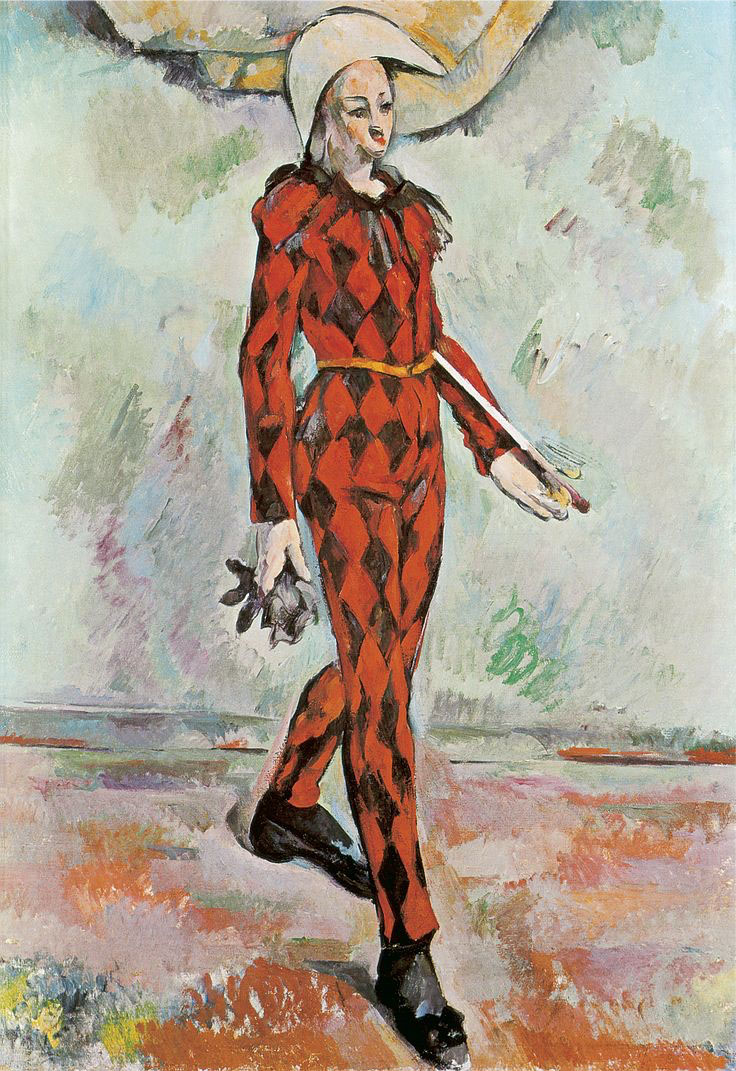
Mr Lee, for me a rather special teacher at
Camberwell School of Art, pointed out that a painter stands on the
same floor as the model. "Andrew it's different from the wall
behind her over there, we can all relate to that; your feet are
here, her feet are over you share the floor, always remember you
share the floor" He gestured a lot as he spoke puffing eagerly at
his pipe. I can't remember what I said if anything " The bottom
edge of your rectangle there (pointing) is important right now" …
"You cannot begin at the bottom edge you have to find it" … "Go
and look at Paul Cézanne's Harlequin, look at the foot pause … if
you connect, you'll move closer to understanding the picture
plane".
Well that may not be exact but it's close and unforgettable for
all of my looking. We were taught that when you draw or paint a
model one of the important things is to choose the size of the
rectangle after you have looked at the subject not before. We
mostly painted onto hardboard and like paper easily cut to size,
sawing bits off was encouraged. Of course things change as you age
and I work differently now from those days but some rules hang on
forever even if you get there via a different route.
There are more than a few things to think about here because not only the cubists followed but also Marcel Duchamp and the surrealists. We would do well to remember that a new age of science and art would bring not only wonder, mystery, stamping of feet at times but more thinking to try and understand.
How we look seems to be fundamental to Cézanne; working alongside photography he must have wondered about looking in time. It's easy to realize that you learn as you look, made clear by impressionists in the contents of the pan bagnat but Cézanne was nothing if not emphatic; a cup has a side and a top but remains a cup to be seen, used, as well as looked at. If you look at what Cézanne recorded/did you might set of in one direction but if you think about what he did you might set off in another. Perhaps art happens during the act of looking and is a fusion of thought and feelings between one person and another.
Were I a great writer like Joyce I'd convey these thoughts in a Bloom like stream because as I wander round galleries looking remembering that this painting may have taken weeks the paint being wet the moment of stopping rethinking starting again endless change relooking … cleaning of the brush is not important in the same way then why … I'm usually in a dream.
Wandering around the portrait gallery show in my dream looking at Cézanne's wonders I settle on three I'll look at for longest, the bowler hat image intrigues me, from beard to hat and back
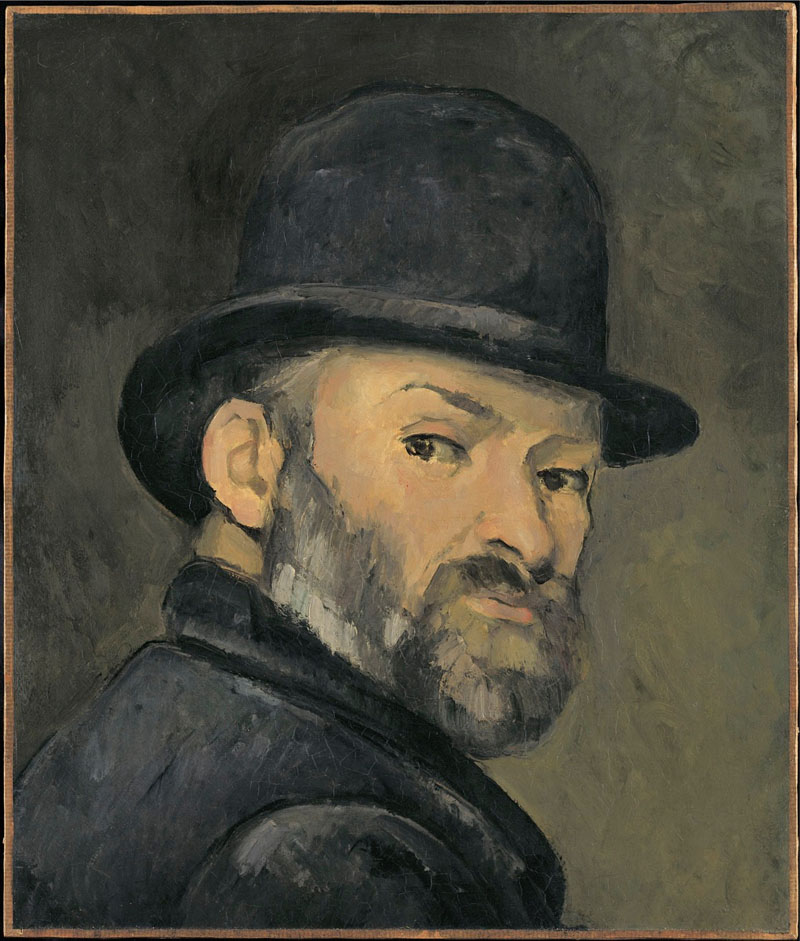
many times. Some of the rectangle is paint, some is hat; when it's both fusion begins and you need to proceed with care like one of those illusions where you know there are two things but can only see one at a time.
 |
a young woman and an old one. |
Back to looking at the bowler … paint then hat, hat then paint; I can see only one at a time. I stare and stare quite transfixed, my back aches, I ignore it and imagine the paint still wet as the brush leaves the surface. What is completion …I remember Mr. Lee again … I can't be sure of the conversation but 'being complete is different from being resolved'. Perhaps the hat is resolved because the beard is incomplete… umm I wonder.
Looking still I try to imagine Johannes Vermeer's 'Woman in a red hat' next to Paul Cézannes 'Me in the bowler' and put her to his right … then the left … Umm
 |
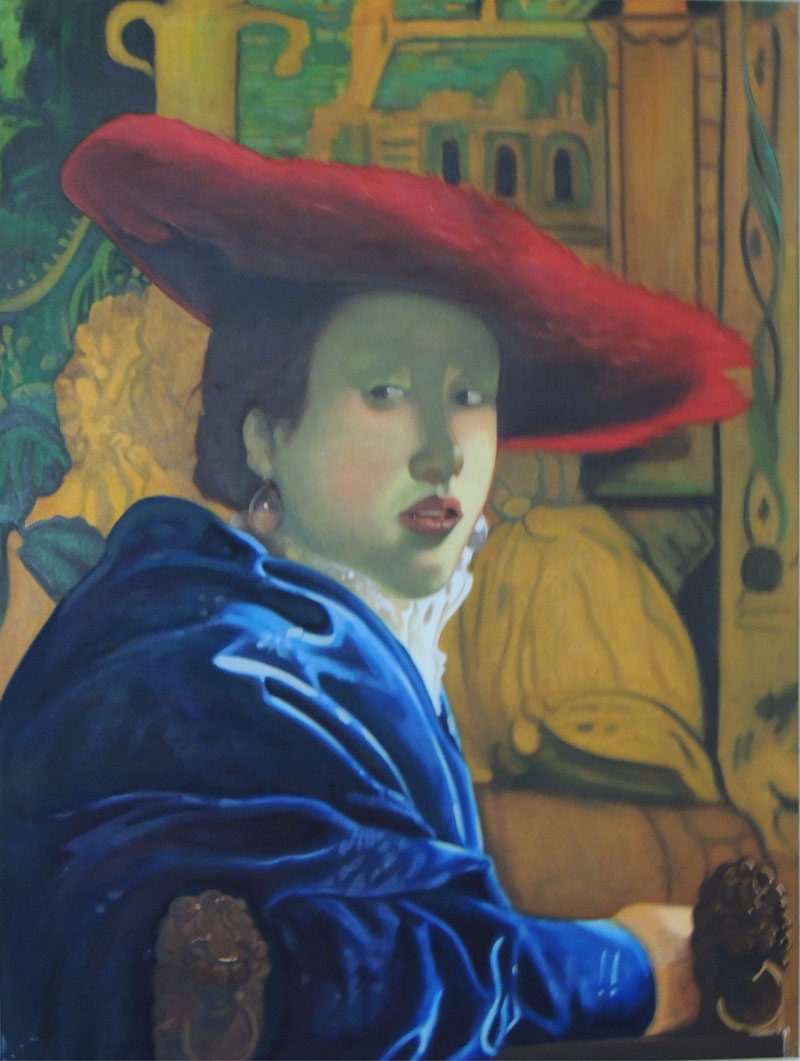 |
 |
 |
then Manet's Berthe Morisot
 |
 |
 |
 |
I cannot say what I'm thinking as one of those glorious moments I long for, 'looking thoughts' occupies me.
Cézanne's beard looks like paint that is about to
become a beard; his bowler is almost but not quite. This seems to
me one of the gifts Cézanne gave us 'The art of knowing when to
stop'; both complete and resolved he allows us to look into his
painting as well as at his painting.
"Cézanne was a palette painter" but what does that mean I wonder "You have to mix two at once" Mr. Lee tells me, "If you mix the colour there to here, paint it directly it'll become local". Local colours are bad because they have no comparative value. As Mr. Lee put it "Nature has a big piano and we have small ones; what we are trying to teach you is to make a harmonic". So as the paint is wet and missed in pairs we are encouraged to think for example to relate the colour on a wall to the colour of the models hair next to it. All the teachers said many things about this pairing approach; one might add "Is it warmer or cooler, lighter or darker?"; another "Find related colour across the rectangle mix them together, as one visual thought; this is to this as that is to that"
Most of the teachers I encountered at Camberwell School of Art favoured variations of the Cézanne method; well perhaps a derivation of it that became known as 'Euston Road', what we called 'The Camberwell House Style' … 'dot and flick', if being derogatory. What ever it was called the approach certainly gave us all a thoughtful route into the beginnings of finding out about the visual arts.
All this time later still looking at Cézanne's work in the N.P.G. I wonder 'what is the relationship of Art and Painting' of all those memories of things said to me over my student years 'what is art?' remains. Not a single teacher gave an answer; they left us all wondering if there is one. Like me now my tutors speculated.
Clement Greenburg in 'Crisis of the oil painting' written in 1948 adds lots to 'the thinking' without a mention of what the 'deep or shallow space' actually do to us. A painting can be sumptuous, saturated, any number of adjectives but now we have the quantum world in can also relate to time as well as space. Art may or may not be present when the work is looked at; looking activates the space the artist has presented.
We also have, as Mr Greenburg alludes, to deal with decoration, much harder for us all since installations drew back their blinds. The unique space in a painting is always ahead of you; in the installation it may also be behind you and you can't see that part as you look at another. The sensations of being inside the work are for me very different from being in front of it (as a side issue I wonder about the inclusion of earphone explanations offered by galleries these days?). Some of the teachers in my art school years criticized a painting if it were deemed to be 'decorative'; What I think they meant was that you the student had stopped adding to the work via looking and responding and were what's best explained as 'tarting the work up'.
What though I wonder are the differences between 'installations' and 'interiors'? … As I mention in another essay on entering the Donald Judd Interior in Marfa I was over come with what I now think of as grief. My knees almost completely gave way … I had no words in my mouth. Why do I remember this as grief; art is often thought to be exhilarating so what were all those aluminium boxes radiating and how did they manage to do it anyway.
There are plenty of well painted pictures that are not art and these days plenty of visual art that's not painted at all, umm. For many years I held onto one of those Camberwell teacher's statements "It's the activation of a space Andrew"; this works well even for installations as well and 'The crisis of the easel painting' where Clement Greenburg also harks back to Manet with possible lament.
"This tendency appears in the all-over, "decentralized," "polyphonic" picture that relies on a surface knit together of identical or closely similar elements which repeat themselves without marked variation from one edge of the picture to the other. It is the kind of picture that dispenses with beginning, middle, end*. Thought the "all-over" picture will, when successful, still hang dramatically on a wall, it comes very close to decoration-to the kind seen in wallpaper patterns that can be repeated indefinitely-insofar as the "all-over" picture remains an easel picture, which somehow it does, it infects the notion of the genre with fatal ambiguity."
Cezanne pushed the process of response and
composition so far along the way that subsequent artists who wish
to 'paint what they see' dwell in a sort of time warp.
I sometimes but not always feel taxed when looking at current art because of the range of responses that artists are making. How helpful would it be if there were a new Cezanne like person whose desire was to make work that resolved rather than promoted. Back in the 1960s we students were battling with desires from teachers who wanted to preserve the figurative model not just as a route in but as the thing itself while others were sharing the influences of galleries filled with Rothko, De Kooning, Tony Smith and many others.
As a student I was falling in love with art but also being tempted with desire to be loved as an artist.
I'm what might well be called an unsuccessful artist, I used to mind but I no longer do; this personnel truth is almost certainly the best feeling I have ever had about my work.
Gold fingers
Hazel Everet is a 'stitcher'. When she arrived at Farnham school of Art in the early 1980s she was as modest an unassuming as she is now. Hazel was in my drawing class and didn't connect with ease to the discipline; she seldom failed to engage however and her breakthrough came after my discovering her passion for stitching, "Why not sew your drawings?"; she seemed much happier. With needles, she chose to use several, and a few differently coloured threads rather than a pencil, she thrived and I began to learn a little about the world of textiles. She stitched the figure above entirely from French knots revealing her patience, skill and commitment.
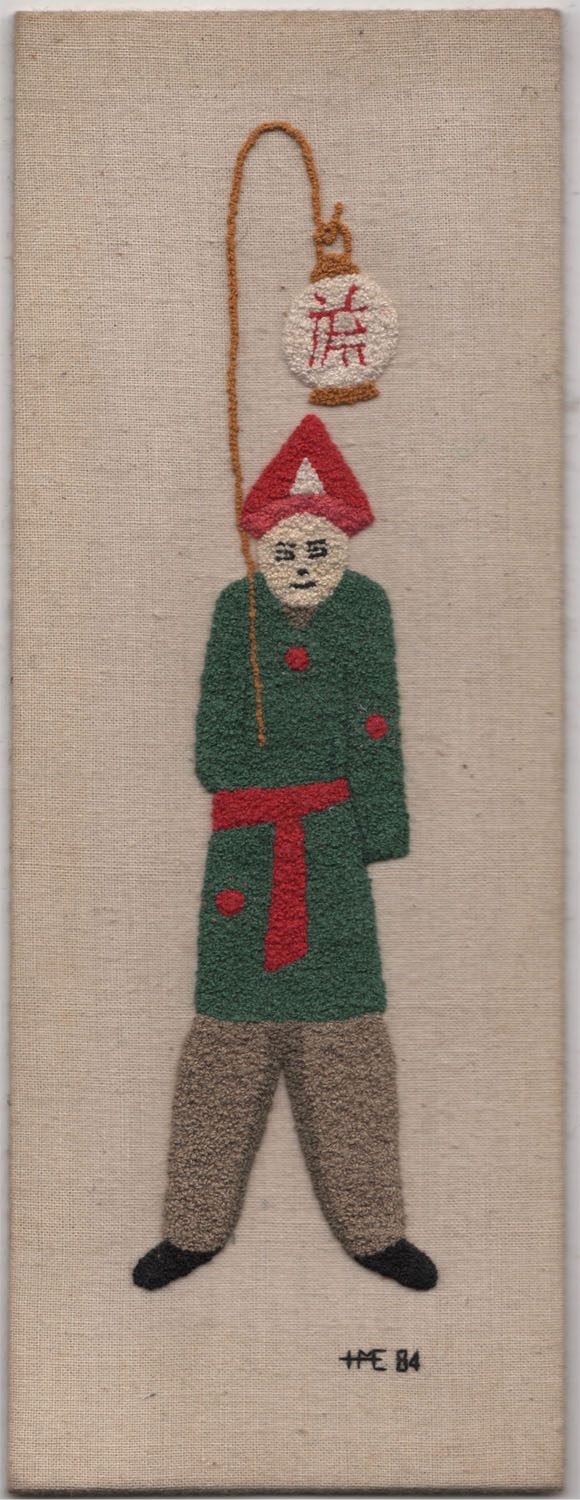
Always interested in part time work so I could have days in my own work room I was cheered when Hazel got in touch near the end of the 1980s and asked if I would like to work at the Royal School; I've mentioned being there when writing about Angela Swann. Drawing for design is so very different from drawing towards art that it took a while for me to get the hang of it; thinking back now I'm not entirely sure that I ever did. The word art has become a blanket term for many activities, its precise meaning perhaps currently adrift.
The course worked through a range of embroidery disciplines with a design needed at the start of each one. Black work, a favourite of mine, is one where the stitches are vertical and horizontal so for me Mondrian and the De Stael movement sprang to mind, well perhaps just Mondrian. Umm, maybe just the Boogie Woogie series where he seems to me to have enjoyed himself the most.
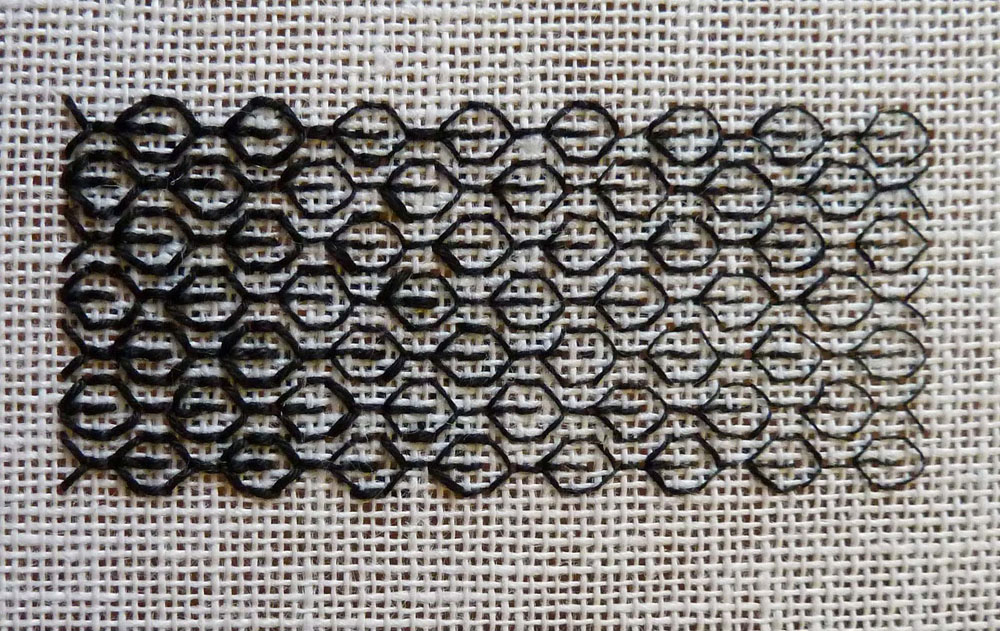 |
 |
Blackwork, originally called Spanishwork arrived in the U.K. with Katharine of Aragon and was used extensively to both toughen and enhance cuffs, collars and, to some extent, hats. My task seemed to be making the students aware of the past without copying old designs; new compositions towards function would, I thought, keep stitchery vibrant.
Hazel explained stitch types and procedures and seemed to have an endless knowledge of techniques to help students who had got into a muddle. The entire world, new to me, seemed a woman's domain; my being there was just lucky. I was not only learning about textiles but also the way that it was often side lined by men.
An easy example of this was in the tomb of King Tutankhamen where almost the entire collection of textiles remained neglected until Dr Gillian Vogelsang-Eastwood revealed their significance for the rest of us.
A recent series of television programmes 'A Stitch in Time' introduced by Amber Butchart analyses clothes worn in well-known paintings. I found the programmes fascinating but imagine that many may well have not watched even though they are interested in the arts. Among the many programme gems was 'the making of Ms Arnolfini's dress'. I wrote my 'essay' on the National Galleries Arnolfini painting for Michael Podroe, head of Art History at Camberwell in the 1960s; back then it hadn't occurred to me that the makers of clothes were fascinating, skilled and experimental.
Making things is drifting away from us; of course there are still plenty of highly skilled women and men who work with their fingers but fewer by the day I imagine. Many, like Hazel, would find their lives more fulfilled were they given the opportunity to discover the joy of making things. I taught small children as well as students over the years and many, but not all, loved making things. It is easy to see as a schoolteacher of crafts that they, crafts, are all too frequently seen as light relief. A child good at the three Rs is 'intelligent' whereas a child who makes a good kite is 'talented'; "You're so lucky you can do that, I can't draw a straight line" almost deserves contempt. In science there are experimenters and theoreticians and yet we do not follow the model of dual response through to school education where the academic dominates.
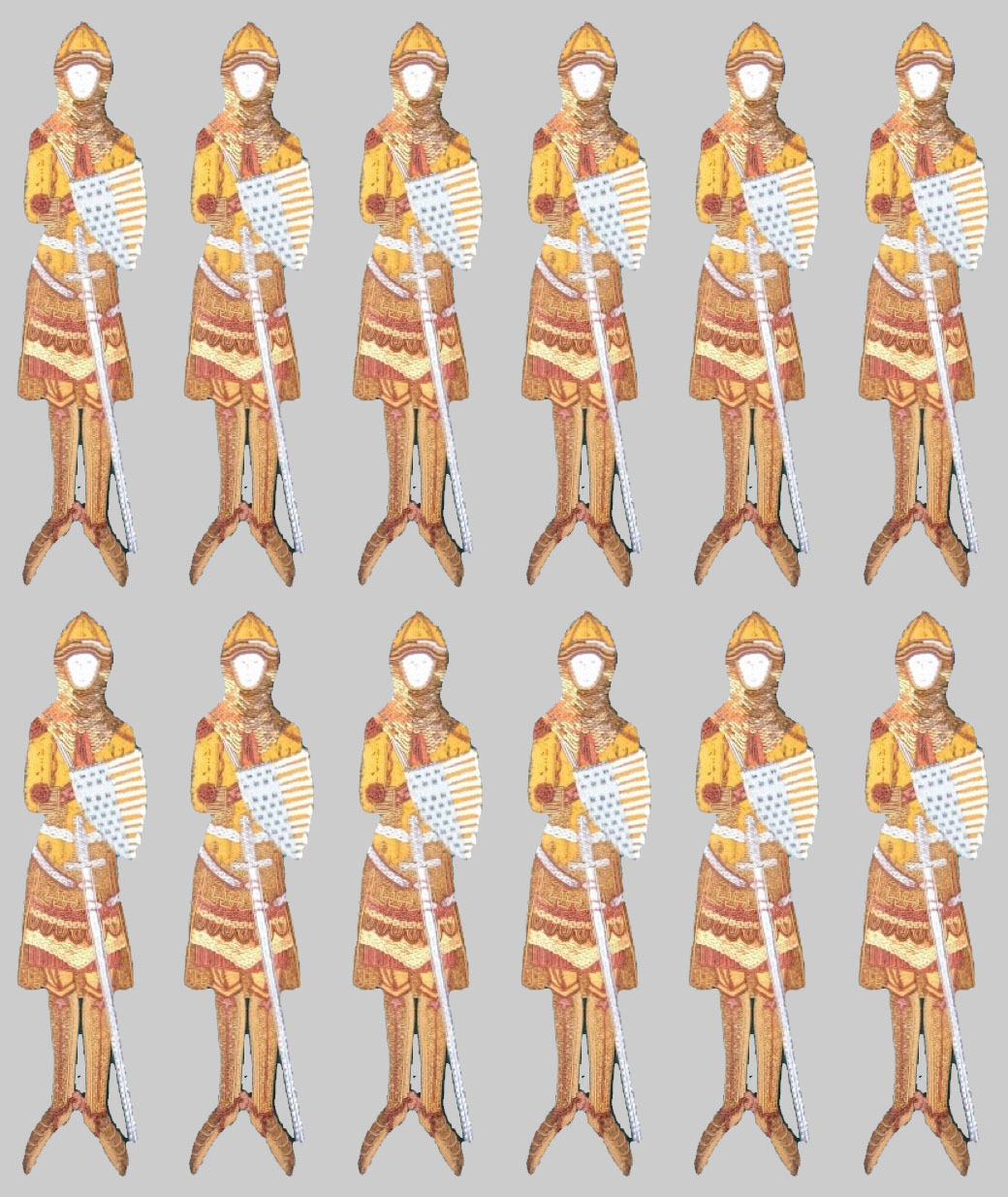
I'm fairly sure Hazel doesn't give a bugger whether her work is art or craft (though she did once tell me her preference for 'artisan'). I've tweaked Hazel's 'Knight' embroidery above. Her actual work is incomplete, was begun many years ago and has been seen by few people. Were the work actually in front of you, as an example of gold work, I can assure you, you wouldn't fail to see Hazel's skill and devotion. Tweaking (there's actually only one knight not twelve) reveals a different kind of focus and lifts a tiny corner of difference between arts and crafts.
Fine art students are oddballs; one of my student contemporaries R A Perry, I wish I'd not lost contact with him, once said to me as he glanced at my current painting over my shoulder, "Art, therapy or money Andrew?"
What you do have to do after any kind of 'art' course is earn a living; Roy went on to work at the Tate Gallery but plenty of us took up part time teaching jobs, which is how of course I met Hazel. One of the dreaded questions we teachers all dodged around was "Are you having a show?" Getting work into a gallery seemed to me, still does, to be like approaching the Terra Cotta Army and asking where The General is. For people like me there never will be an answer; it's a mistake to ask.
Hazel, Steve Barber the lute maker and myself; I've also written about and a few others, are artisans. In my own case for one reason or another I found out to late; this doesn't mean my years of work were wasted or even that I'm a dreadful artist. My paintings of Nefertiti and a few others are perhaps better than many I have seen in art galleries. For the most part though the works are artisan and not fine art; I've managed to remain an oddball, somehow caught between two aspects. Partly this is down to a personal disaster that almost ruined my whole life but, as really good artists are few and far between, it may well have been the case anyway.
When Marcel Duchamp opened a new doorway into looking at the world, skill no longer needed to be the only way of making art. I've been overwhelmed by looking at many 'unskilled' works; I can fall over backwards at a photograph, which might well in certain circles still throw up the question 'Skill or mechanism?' That doesn't mean skill flew down the turnpike and into the past but that we can have both. I know it was well worth my while to travel a good way round the world to Martha and be overwhelmed by rooms of work Donald Judd had other people make for him.
Back at the Terra Cotta Army even the photographs bring tears to my eyes making me realise over and over the immense difficulty of art and artisanship; in trenches the army soldiers are tilted, vertical, alone, united, turned to one side even. Did anybody make just one of them I wonder, was there a standard, were any rejected, do they belong to anyone, are they Chinese. If their mystery isn't as much a human treasure as knowledge of say, Aleph Null, then "I'm Off" as Stephen Dedalus says to Malachi Mulligan after a bad night's sleep in Sandy Cove's Martello Tower.
Broken Objects
When my dad was dying he must have been pretty isolated; at least that's how he seemed to me. Gasping for air in an oxygen tent until they let him out for a wee while each evening. One of the last things he did lead me to was a work of art I have never completed; he gave me an ornament that stood on the mantle above his fireplace "She's the mistress and she's the maid" he'd explained to his young son. At one end of the mantle a figure slipping away her robe; at the other a woman bearing a bowl; a bowl he put three pennies in for his weekly bath.

He told me the 'servant' was mine as he lay dying and the 'mistress 'went to my brother. I once hid his bowl pennies under the ornament as a wee joke leaving the bowl empty; years later the bowl held an object of darker humour.
After my years at art school I married a woman who I remember as breaking my heart in three; she and her lover took a part each, leaving me to sort out unhappiness with what they'd left behind. They walked away and my grief opened the door to the madness I kept hidden. One of the things I remember was putting all of the objects she left in her wake across the floor in a V shape' at the apex of the V was a bowl.
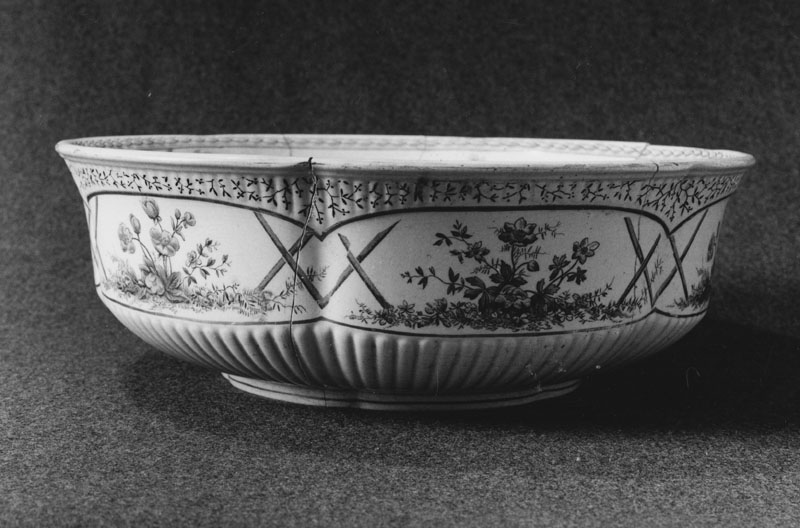
Strangely the bowl developed a crack; as I recollected the events of my life I realized a potential work connecting my dads broken marriage to my own. One of the things neither she or her lover will ever know is that my friend David Troostwyk made a painting of her bowl that hung in the Tate Gallery in 2004.

After David had completed his work, the bowl was returned but sadly the split had become a breakage.
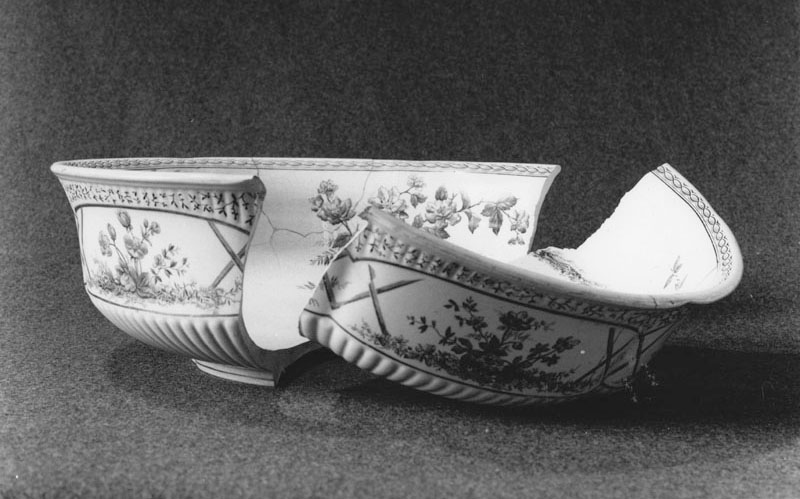
My work, still unfinished, links many things in my life one of which is the book 'The Secret Lives of Objects' by Jane Graves. During one of our conversations Jane and I talked for a long while about the differences between whole and broken objects.
David and Jane feature in a work of mine called 'Six of Six', an attempt to link personnel memories with two friends who understood loss. Neither David nor Jane will ever know what they meant to me or see the completed work 'Six of Six'. They might though both have smiled at what happened to my 'servant'

Thirsty moments.
We all have thirsty moments
My father's came with star shine
Throat dry
Finger gripping something
Then there the first
Tempting the tilt game
As both sides of the bottle became visible
My father slowly disappeared
Then cropped up again in morning exhaustion
He had no marriage bed
Just this empty space for the night
Where the unconscious lies in wait to frighten us
He walked the dockland daily
The banks of Southside Greenwich
With his pencil sharpened for the listing
Copper flour dusted from tugboat barge
He couldn't read my pencil marks
Embarrassed by our loss of trade
He took to his bed
Died with one arm reaching up
Slurred words dribbling through clenched teeth
Much later in a trip I make
Regular past Old Bailey
Through to the place of Wallace ghost
I see again in plaid his
Drooped body walking city pavements
He can see me but has forgotten he is my father
Though strangely he recalls that I am still his son
"Hello Dad… Thirsty moment"?
""Aye son a thirsty moment … Hod on am I ya dad"?
Judgements
As an apprentice electrician I remember being told that a switch drop I had just fixed wasn't vertical; I held a plum bob along side it to reveal that it was in fact vertical. "Still doesn't look right" says Ken Scullard; I have no memory of it being changed.
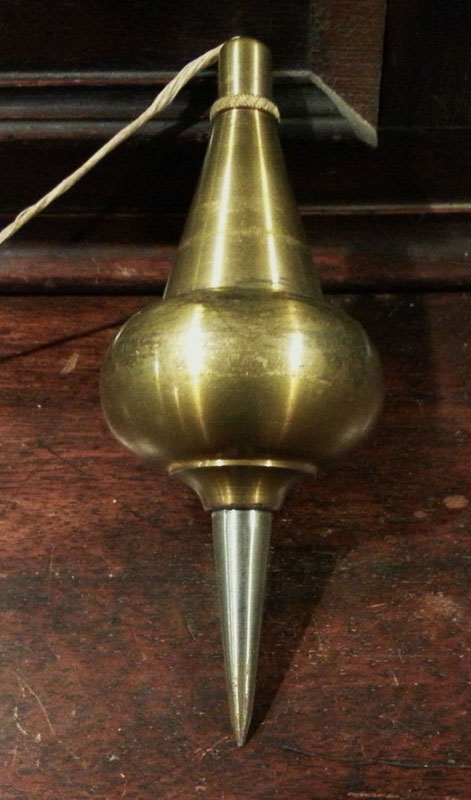 |
 |
Spirit levels and lasers have replaced these tools; one I feel nostalgic for was/is the stonemason's adaptation of his 'plum bob box' made up for erecting the Cenotaph that slopes inwards. One wonders if similar tools were used to keep the slope consistent on ancient Egyptian walls.
This makes me realize a little more clearly the connections between judgments and measurement. When I hang pictures in galleries judgment switches to measurement back and forth until a whole wall looks well; I suppose this is a measured judgment. I'm pretty good at hanging pictures but have more than once faced the height problem, I favour 'low'.
The worst application of a rule when hanging paintings is centre alignment; the impact power on entry into the gallery is lost with this arrangement. My conjecture would be to aim for an aligned top not a bottom alignment I once saw.
Gallery situations for a hang need careful
thought as it's very easy to get things very wrong indeed. The few
times I've been asked to hang pictures in homes I have faced the
situation of people wanting to join in, always tricky. We seem to
think there are no criteria but personal ones for what our homes
look like and it is a complicated issue to sort out but some
things are worth a rethink.
Population growth has lead to a loss of house style in more ways than one, local differences have disappeared and soon we'll be left with what I can only think of as a visual disaster. Out there in the public domain there are many visual situations that make me cringe; here I have to say I have discussed my use of the terms 'visually correct' and 'visually incorrect' and under pressure reluctantly agree with the wrong use of the terms. So what am I to do with the pain in my eyes as I look around me?
 |
 |
Nash Terraces, I would argue, are better looking than The Bishops Avenue but are they more visually correct; oops there I go using incorrect terms, I'll try to explore and find others. Many years ago I often travelled along The Bishops Avenue in North London, much has been said of this strange wonderland, one of my observations was the endless array of skips.
The first home I worked on after leaving Art school was demolished, my William Morris wallpaper in the skip. I wish I'd saved the two rolls of printed-paper for my next home and the next and the next, right up till now so I could still gaze at it in wonder. Much of the work I have created in my homes has ended up in skips. Recently I've seen my 'thoughts' skipped again ready for transport to the dump. I am not a designer nor are most of us who arrange the insides of our homes but I have been to art school and so at least am an educated looker. The people who have bought my homes have ooh'd and ahh'd prior to purchase, one in Camberwell even saying "This is so beautiful …" secretly thinking perhaps 'I can't wait to heave it all into the skip'
When Nash made his terraces the builders measured
and judged all along according to his plans; premade components
were not delivered by the lorry load and assembled on site. The
subtle differences in sizes still delight the eye without most of
us knowing why. In the Bishops Avenue 'rich' people, along with
'designers', replace one skipped horror with another. If it's not
'visually incorrect' it's almost certainly 'an oasis of visual
horror'.
Sadly it seems, almost certainly via television programmes concerned with 'makeovers', many people are wrecking the exterior of their homes by squeezing interior walls outwards.
In particular at the backs of terraced houses the
enlargement of kitchens and loft extensions has ruined the beauty
of the repetitious line. These terraces, if they need adjustment,
should surely be managed with agreements rather than personal
preference.
Dare I proceed to the insides? I dread to think what one might see in alteration if one popped into all the homes around Regents Park almost certainly a 'revamped' world plucked from magazines like 'Interior Design'.
 |
HELP! |
There's no blame here; I'm not looking to vent anger or join in the endless and ridiculous television presentation of winners and losers as I'm not able to put my finger on a solution but we could perhaps begin to think of better visual education. The leadership of the whole world is pretty dreadful at the moment; our leaders dress dreadfully as well as not being inspirational.

There seems to have been a visual decline in England blamed on economics, on illiteracy, on anything but what we look like and look at but in the words of Arthur Schopenhauer,"Nothing would exist had the first eye never opened". We can't all live in homes like this one and it's pretty fruitless to dream of doing so.
|
|
|
This is Frank Lloyd Wright by the by; we can use some of his thoughts, like using local materials and following good visual leadership; think of it, he made the home in the waterfall not nearby looking at it.
Near and Far
 |
Sam my adopted son brought 'Far and Near' to my
attention many years ago in relation to a flirtation, at least I
think that was in his mind at the time. Recently between homes and
without a place to paint I managed the written part of a work
called Ruthie. Tucked away in there are references to 'Far and
Near'; as flirtation in 'Plymouth' when Ruth and Ado pretend and
play they are both distant and together. In Dover during her dance
of self-delight Ruth who was dead before I was born falls in love
with herself while looking into a mirror. At this time Ruth is in
two places 'Far and Near', both behind and in front of the mirror.
I've always thought mirrors a necessity in flirtation and love
scenes.
There are other senses of 'Far and Near' tucked away in Ruthie; my dad's thinking of me as, "Wobbly son, just like your mother" was because my mother spent some years in mental institutions. So, as a child, I was a bit 'wobbly' too and often 'over there' as I found out when I was much older. 'Over there' because that's how it began to feel, part of me was somewhere else, another person perhaps who I didn't like very much and the worry was that he would always remain one of the unloved ones.
None of this ever stopped me being myself; being unhappy was because I thought I was incomplete. I spent some time trying to explain incompleteness and uncertainty to DelMarie a psychiatrist who helped me a great deal but Gödel and Heisenberg helped too allowing me to transfer disciplines of science and mathematics towards a better self. 'Incompleteness' and 'uncertainty' are to my mind a constant visitor to visual art; trying to explain this is like holding a magnet near to metal and wondering exactly what's really going on in that moment when you feel something about to happen … then a jump; it's left you and joined something else. Wolfgang Pauli's exclusion principle deals with this issue, it's complicated but finding out how science and mathematics work is an inspiration for all our lives.
Art has kept me afloat all through my tricky times and although I do not understand much science knowing that others do has helped me get to know that the person I thought of as 'Far' can begin to be 'Near'. Science, mathematics and art may share beauty and eventually we may see more connections than we currently do. They may be 'Far' now but when or if they get to be near we might learn to measure beauty
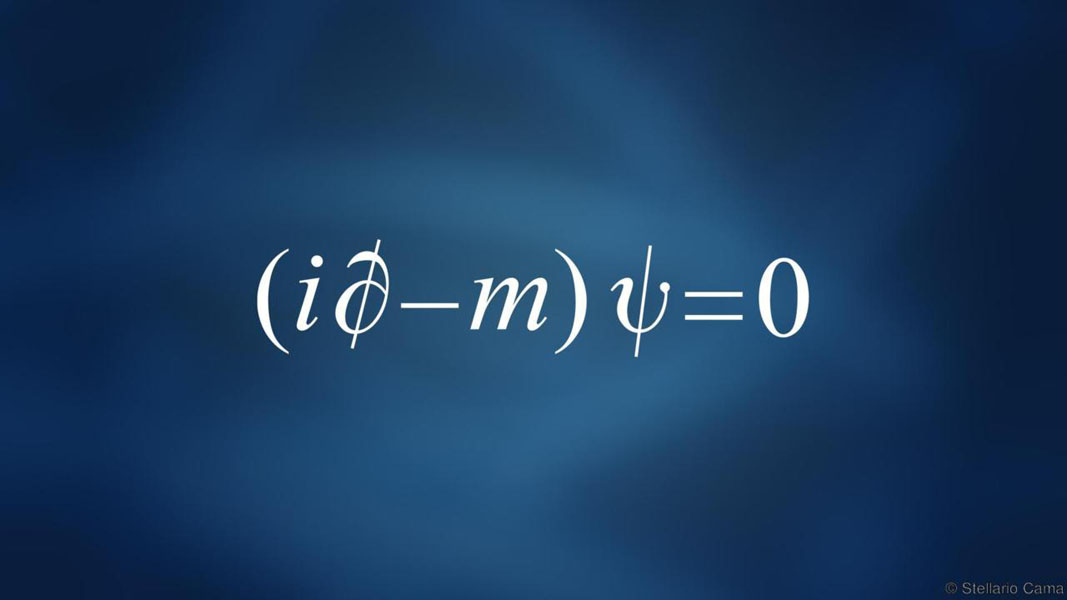 |
In Westminster Abbey Paul Dirac's equation is beautiful, not to look at but because of what it looks towards, 'Quantum Mechanics' is beautiful perhaps because it works like great art. Trying to explain the speed of light is not the same as explaining Mondrian's Boogie Woogie pictures but it might be; the link for me is held inside 'perhaps'.
My mental illness meant I could not love the part of myself that was 'Far, it didn't mean I was unable to function; you can use a mobile phone without knowing how it works. Quantum ways has given me my deepest look into where art might be helping my 'wobbliness' to weaken. Without my knowing, for years my struggle was having no 'perhaps'
When I began to see art it was just a glimmer and as Ruth finds out when the ball passes through the window it is then that you first meet yourself as a friend who, if you are lucky enough, you begin to like.
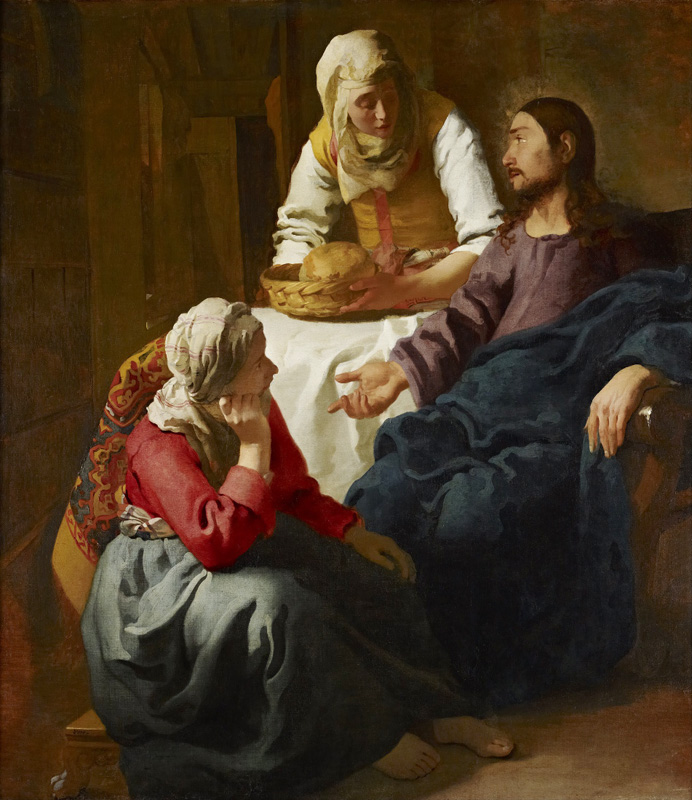 |
When recently looking at Christ in the house of Martha, painted by Vermeer, Martha is the most beautiful and in the simplest of terms 'Far' i.e the furthest away and yet she is 'Near' because she is the most beautifully painted. All this has to be thought through with your eyes and finding out how to look at a picture is like the action of throwing. The ancient Greek philosopher Empedocles had many beautiful thoughts, one I love is that light streams from our eyes. We now know that light travels into our eyes but perhaps the wonderful Empedocles was on track, that art is our reflection, it bounces back from our looking.
Had Robert Hooke in Micrographia looked with an electron microscope rather than through the one of his time he would have photographed rather than drawn his illustrations.
 |
 |
 |
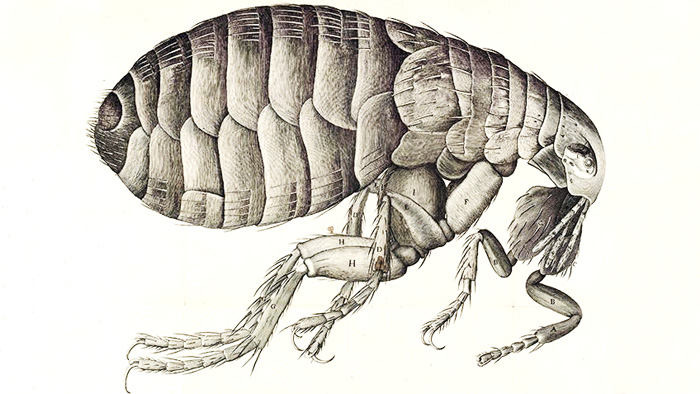 |
Vermeer in painting and Beckett in language balance time in their work. 'What just happened' and 'What happens next' are not questions like 'What does a flea look like?' After the great fire of London Hooke perhaps thought, "What'll happen next when I look through my Zenith telescope?"
Gaelic song for my dad
A few people have asked about the Gaelic at the start of Ruthie
'S bochd an naidheachd a fhuair sinn
'S a ghluais mi gu dàn
M 'athair, mo thruaighe
Thugadh bhuainn e le bàsz
Cò aige bha dùil ris
'S tu cho sùnndach 's cho slàn
Cha robh sinn a' smaointinn
Gum biodh do shaoghal cho gear
My father was secretive, telling me little about his early life and almost nothing of his first marriage or the death of his wife and daughter Ruth. I wonder now in my late life what his was like; not just as my dad but also as a person I might meet by chance and how would I think about him if that had happened.
Like many of his time he got up early and went to
work making a routine of duty and repetition
When I began my electrical engineering apprenticeship in 1955 he
was delighted; at last, away from all that academic rubbish. I
wonder if he would have liked me to be like him; not too curious,
respectful of authority and one who knew his place. In the early
1960s I gave up 'electricity' and went to Art school, oh how he
hated that remarking, "Pull yer self-together lad, you've a trade,
away wi yer hoity toity nonsense", all in a strong Glaswegian
accent.
Going to art school certainly thwarted my dad's dream of what life ought to be; at least I imagine that to be the case. What he might have been happy about is that I have remained part of 'the crowd' all the way through; along with many others I am completely outside the art world. When I hear well-known people lamenting their parents never knowing of their success I think the opposite would be true for my dad. He once, I swear this is true, wailed, "A working class lad needs nine hours of the day spent in monotonous toil followed by evenings spent with a woman he gradually grows to dislike" and he wasn't a nasty man as far as I knew, just disappointed. What he didn't know was how long it took me to see the world in a completely different way from his viewpoint. Art saved my life.
I had, as a child, what would have been called today 'mental health issues'. I didn't know that I had them and there's little point even now of making a drama about some of the actions I took; with regard to these issues, like my dad I was secretive. I've always thought that you know plenty of things as a child that you forget as you get older; memory is such a strange thing anyway seeming to be completely outside of time. As the events of our lives recede they get beyond the bubble of short time span we live inside and become our life's filing cabinet. We can get a file out if we can find it, look at it, muddle the contents, maybe even leave it out for reference. We can't always see the truth in there and plenty of us disagree about the line up of events if we cross reference our files, some even lie rather than reveal the muddle of it all.
At art school I met people who I would never have encountered in the world of my dad, unless of course I had been working for them. At the time I ignored what I couldn't really fathom; these polite strangers with different accents (mine was changing rapidly) shared an ignorance of what art was and we ignored our differences.
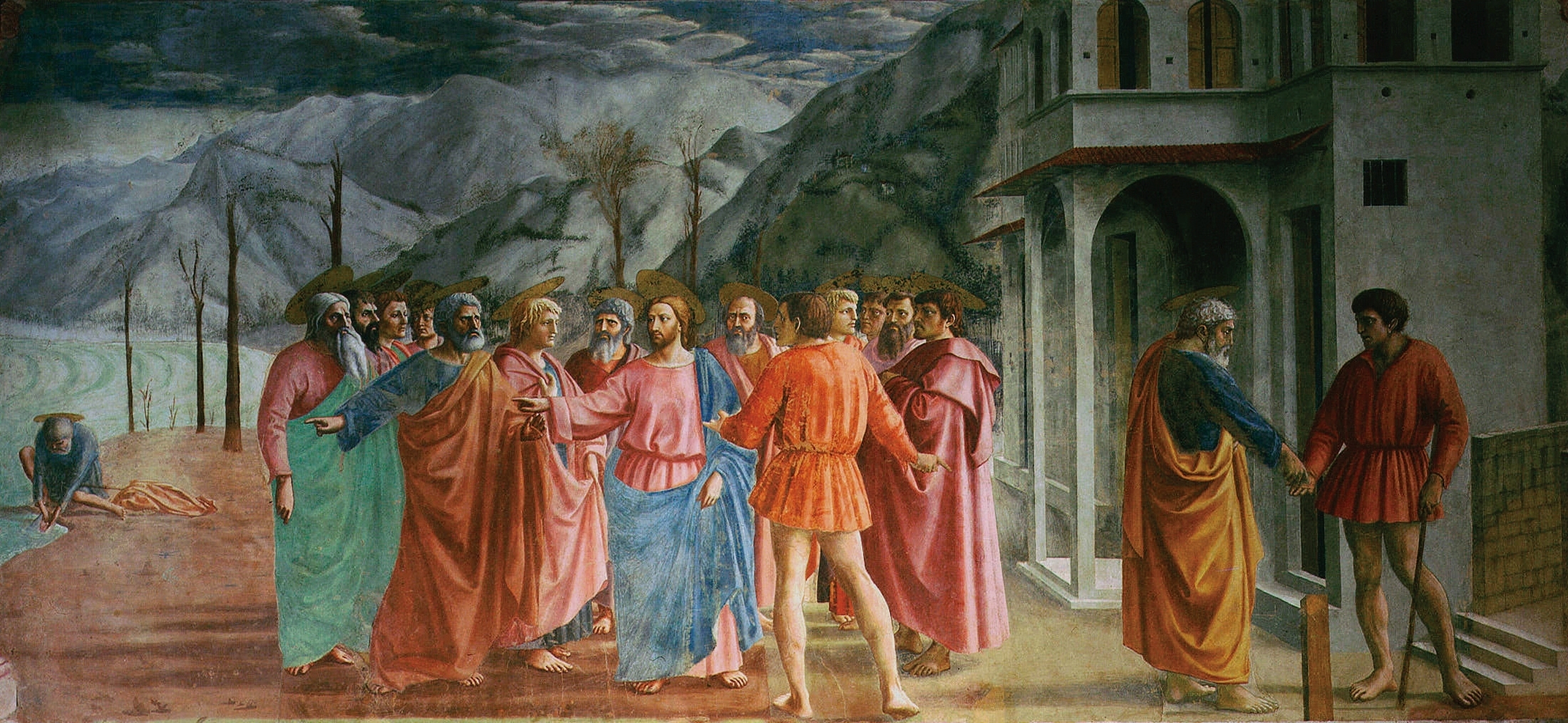
I once asked Michael Podro, our art history lecturer, what class he thought Jesus might like to be a member of. Michael asked why I thought it important and I replied Jesus had done what I had, given up a good solid trade to do something else. In our seminar group we were looking at this painting made by Macassio in the 1420s.
A few things had cropped up in our chatter one was the story depicted The tax man in shorts requests a tax from Jesus in the center who turns to Peter, he, like his master, points with his right arm towards part two. On the left of the depiction is part two where a crouched Peter, with outer garment on land, collects the cash from the mouth of a fish. Part three is on the right with Peter paying the taxman.
Another seminar point was that Masaccio had not been allowed to paint the whole work as he was an apprentice. I was fairly sure that none of the other students had any notion of what it might be like to have been an apprentice, why should they. My 'master', Ken Scullard, gave me, his apprentice, frequent bollockings, lectures on control systems, made me clean and carry his tools as well as join the Electrical Trade Union and Communist Party.
If I think back now, look into my filing cabinet, I cringe at the memory of that seminar; I may know little now but then I was completely uneducated, desperately unhappy outside of the college oasis and probably thought I would become a well-known artist. It has taken me most of my years to begin to see what art might perhaps be and that few people approach a close encounter with the art world.
In my last year at Camberwell School of Art I was
given the opportunity of travelling with my life long friend, then
a fellow student, to Italy where we saw among many others
Masaccio's wonderful painting, quite quite different from looking
at a seminar slide. The complexity of visual art is often hidden;
most of us may well be doomed to failure as we try to unravel or
respond to whatever's concealed in there, we cannot say what we
see. The tax story alone would mean that Macassio's picture is
merely a good illustration because the artist was talented. The
tax story might be there now in a completely different way from
what it was six hundred years ago, more importantly the art may be
different too and only there when you look at it. The Quantum
World we live in now makes things appear very different indeed
from the 1400s in Italy.
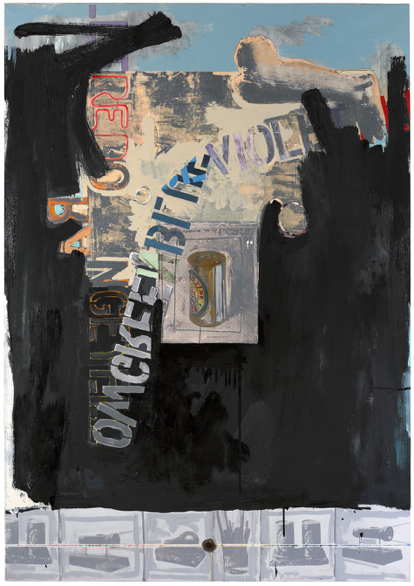
This painting by Jasper Johns requires a good long look too; I was lucky enough to have one just last week. Right now there's a show of Jasper Johns at the London Academy and there's plenty being said about these stunning works. Inside the gallery the works fill the whole gallery space; this enigmatic exhibition's uniqueness brings both thoughts and feelings together. As I have said it's taken me a whole life to begin to learn how to look; time and again artists show us ourselves and Mr. Johns' works do just that.
There are fifty years between my art school years
and now; for many of them a trivial event in my life reopened my
childhood doors of mental torment. I had thought the trivial event
momentous and that had it not happened 'things would have been
very different indeed' but I was wrong. The works made by Jasper
Johns more or less span my life and I will never meet him to try
and express my thanks, just as well I imagine; how long would it
take to get our grids lined up. Instead I'd like to sit in the
gallery with my dad and say so many things; why these works by Mr.
Johns are about seeing all the things we have done … yes dad they
do pass through two slits at the same time; he'd understand now
because his body's dead but he's alive for a little bit longer
here, right inside my filing cabinet.
Dreadful news has moved me
To compose a song
My father my peace
Has been taken from us by death
Who would expect this
With a man so content and healthy
Elizabeth David
I'm not sure where but I once read "... the prime steak is cooked between two lesser ones which are then discarded...) Umm well worth thinking about.
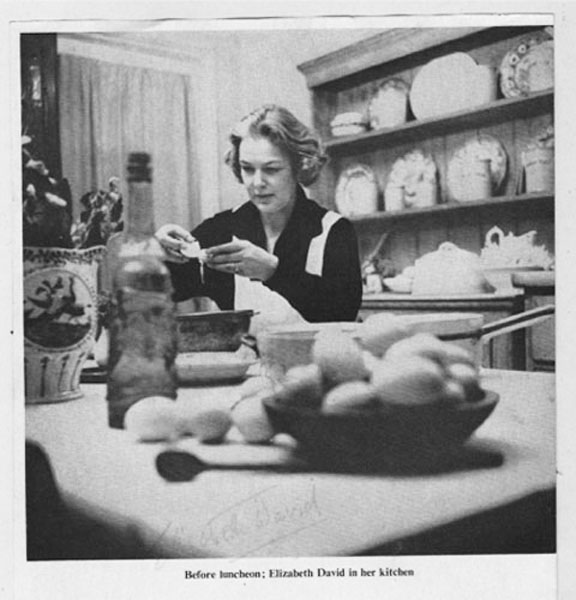
Many years ago I wrote to Elizabeth David asking if she would sign the picture I had cut out from a Vogue magazine. After a while she replied and I have had the picture hanging in my kitchen ever since. If you look very carefully you can still see the faded signature; the letter she wrote is wrapped and attached to the back of the frame.
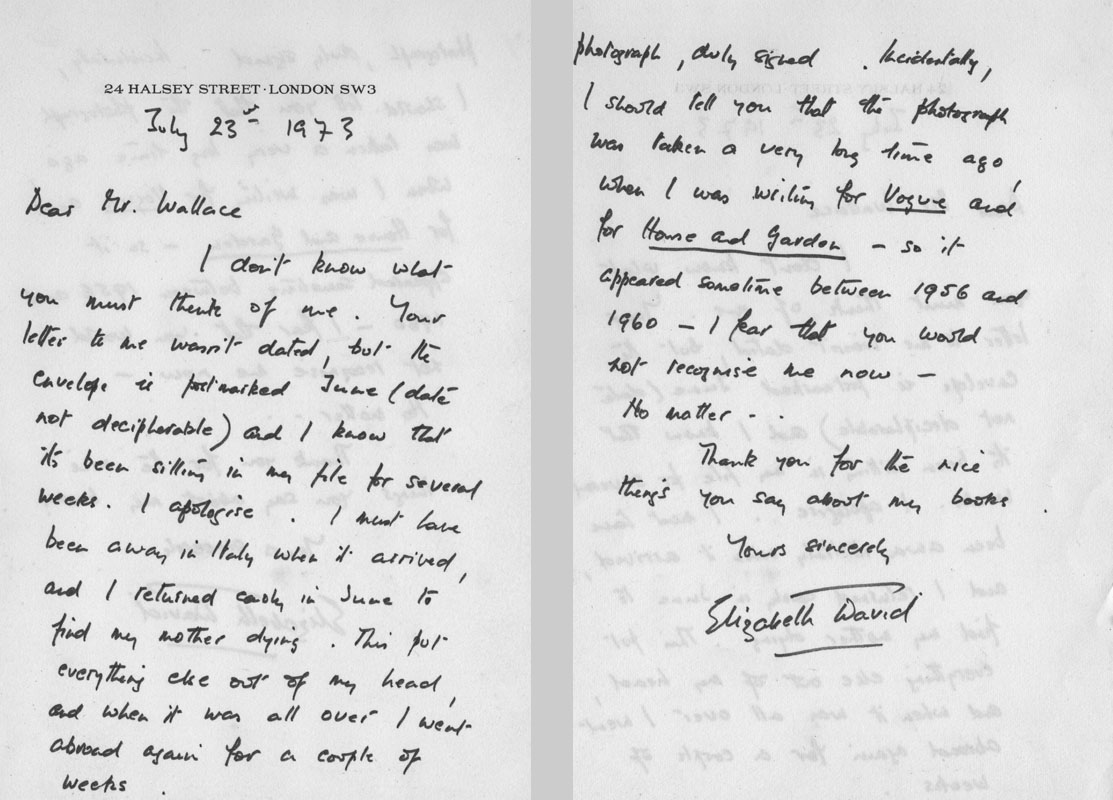
Ms David had been to art school in her early years and if you were not academic they were the places, if you were lucky enough to get into one, where you might discover things about looking that would change your life.
She would have learned that this illustration from one of her books is quite brilliant and that whoever drew it had been taught to look; what it isn't however is a work of art.
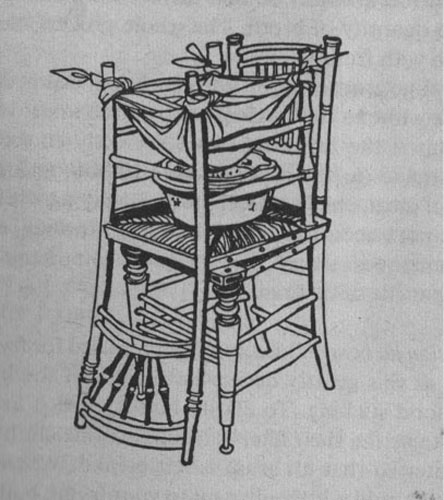
The word artist is sometimes used when we have been thrilled by performance. "The lad's an artist", used to describe a footballer's brilliance is completely understandable but still wrong. As we are confronted with art these days we often embellish our responses with outbursts of rage; I sat on a London bus recently pretending to read but really entranced by the elegance of my co seater's "... yes three blank rectangles with a note saying imagine what you like pictured here...". There were 'Scoffing Queues' at the Tate Gallery to view Carl Andre's "BRICKS' in the 1960s but I don't recall, "He's not an artist" rather "... that's not art". A poor footballer would probably not be called 'a poor artist' but rather "... fucking useless", which balances well with 'The lad's an artist' to express an emotional response.
The best years I had when working in art schools were when I taught drawing and tried to refresh each year's course with differing programmes. As a teacher one has the responsibility of putting students into places where they can discover how to manage what they are looking at; one of those places is, what I may well be wrong in calling, somewhere to find 'a dialectical response'. I am referring to our intellectual and emotional responses, which I feel has to be present in all works of art.
We might well hear 'what we think about a thing' alongside 'what we feel about a thing'; I'd get into a fearful muddle if I tried to present here these different responses in relation to looking but they have to be there, simultaneously and clear in great works of art. I would not have audibly gasped in galleries a few times had I not been introduced by those who taught me to, what my friend Jane Graves once called, "An intellectual debate delivered emotionally". Tricky stuff but none the less important when we try to 'line up our grids' to presentations in art galleries.
When Plato said, "there are two cities in Athens one for the rich and one for the poor" he could have named any city at any time. I'm not entirely sure we should reward artists with wealth any more that I think they ought to be poor or try not to work for one group rather than the other.
Elizabeth David's books are beautifully written and though, from what I have read about her she was not a saint she changed my life along I imagine with many others; it was well worth going to Folkington in Sussex to stand by her grave in the church yard; perhaps to think of art, science, food and that all are needed.

IPATIEV

I have looked after most of this work for close
on thirty years having it all apart from the metal hook. The whole
thing was made for David Troostwyk at Cathedra, a carpentry
workshop in Greenwich. The last time the work was seen in
completeness was the early 1990s in the very sail loft where it
was made. Troto, as I called him, titled his work 'October' and
painted it red and black making it easy to spot the 'revolution'
association: when the robes of one ruler are removed the next one
might well use the same hanger.
As time passes the 'meanings' of a work may change; a beautifully crafted work may become 'a treasure' and be loved because of what it used to be. Some works 'hold on' and continue to relate their mystery over hundreds of years, across cultures even.
There have been since about the 1850s art critics, writers and historians who have approached the complete Linnaeus model but seem to disagree about their categories (Carl Linnaeus is often described as the father of taxonomy). The period, from the 1960s/70s through to 2000 or so, of post modernism seems to have made many critics angry with works that frequently seemed shallow, easily made and were often ugly. There's a fair amount of beauty to see around us; many people in the 'audience' wanted to see more of it, as well as skilful manufacture, in our galleries.
It's all very difficult. When Brunelleschi
impressed the judges with his bronze door panel he still lost to
Ghiberti and, according to Michael Podro my Art history teacher at
Camberwell school of art, became very angry and left Florence for
Rome. Luckily for Florence he came back and spent many years
making the dome for the Cathedral.
Michael Podro told us that in their hey day, back in Florence, the Medici family commissioned the house style of the time to enjoy and exhibit their wealth. Wealth is still very tricky and doesn't help the 'audience' at all; in those days the public had access to religious art in churches giving depictions purpose. These days the rich seek uniqueness and the residue of that form in galleries has scant connection with a majority of public lives; this doesn't mean that it's bad art just inaccessible to many people, consequently hard to judge. We have to trust the educated critics who disagree quite a lot, tending to leave us having to both trust and value their opinions.
On the up side of things 'Street Art' has been popular since the dark days of Post Modernism, though no one really knows what to call it. From the upmarket end we have works like 'Bean' in Chicago or Robert Montgomery texts and a favourite of mine Julie Brook; ordinary people are enjoying what they see in these and other artists seeming to realise who art belongs to. Public Galleries are popular making it hard to understand there are difficulties with say the Turner prize. It's just as much fun to ridicule something as to do the work and get the message.
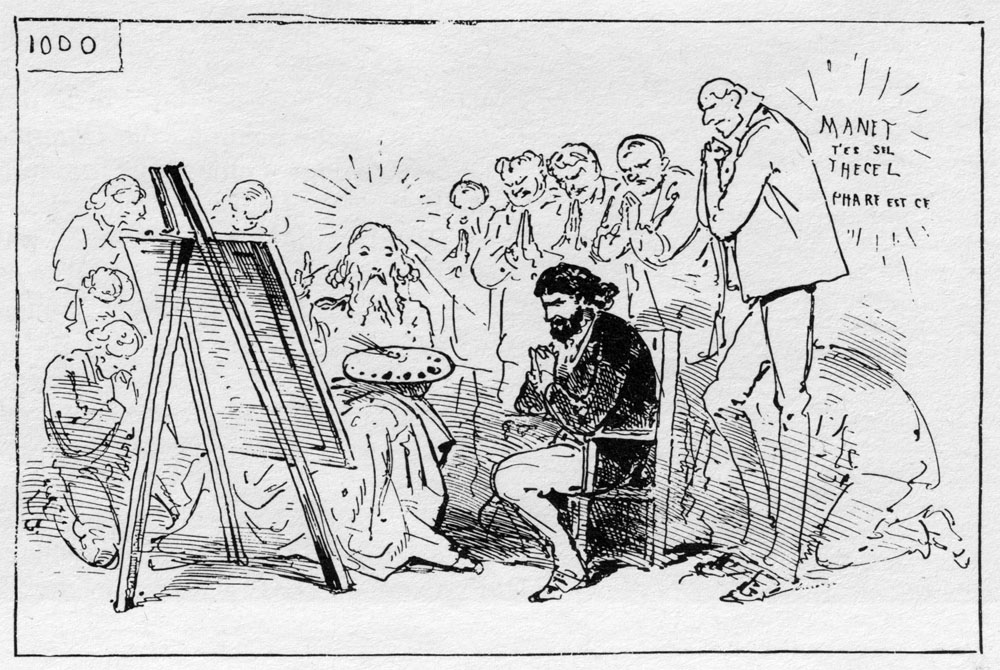
I imagine this caused as much mirth in the late 1800s...

as this from recent years and there's nothing wrong with the fun of art as long as you don't then slobber over much loved work from the past.
My friendship with David Troostwyk meant a great deal to us both. He and I talked through many of these issues as we drank coffee or strolled back and forth in the embankment gardens. David was quite bitter about the art world that kept him on its fringe; one needs strategy to deal with the mafias.
I was lucky to see his late work of pierced negatives but I doubt many others will. There would be little point in a description of these works that won't be seen but I can say that they made the leap from the art world we communicate in to the place where we have to be alone with looking.
Another of David's friends was Euan Uglow; he and David, though very different artists collaborated over a couple of works. One of David's works called 'Diagonal" refers to one by Euan with the same name.

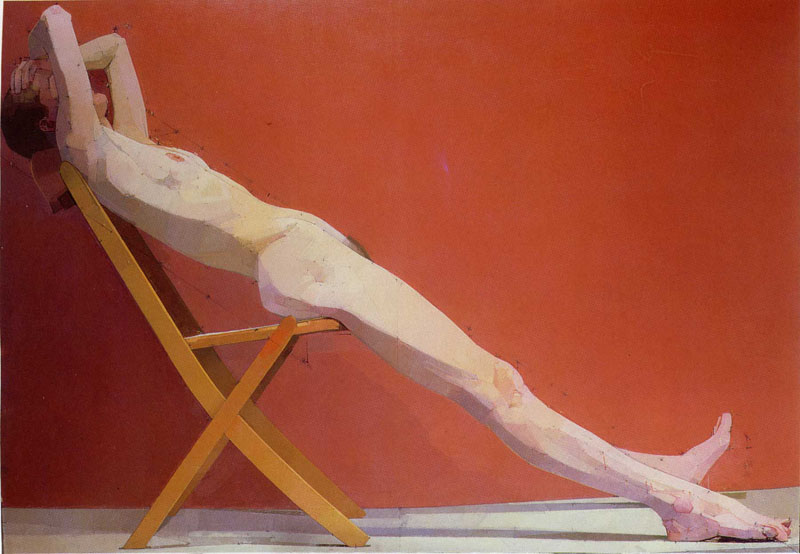
I know they both respected each others work while thinking along very different lines and wonder what they would make of my thoughts about painted art where I often refer to uncertainty as a principal. One of the reasons for this is because of art's relation to time, which we thought was a constant, and yet turns out to be variable. I think this is one of the reasons why art changes its meaning in differing ages. In science I have noticed that we read things about the past masters rather than the work itself whereas we still queue for the Sistine Chappell.
As well as their works on diagonals David and Euan both used toothbrushes for a work; Euan called his 'The Three Graces'; it refers to antiquity and perhaps the Judgement of Paris.
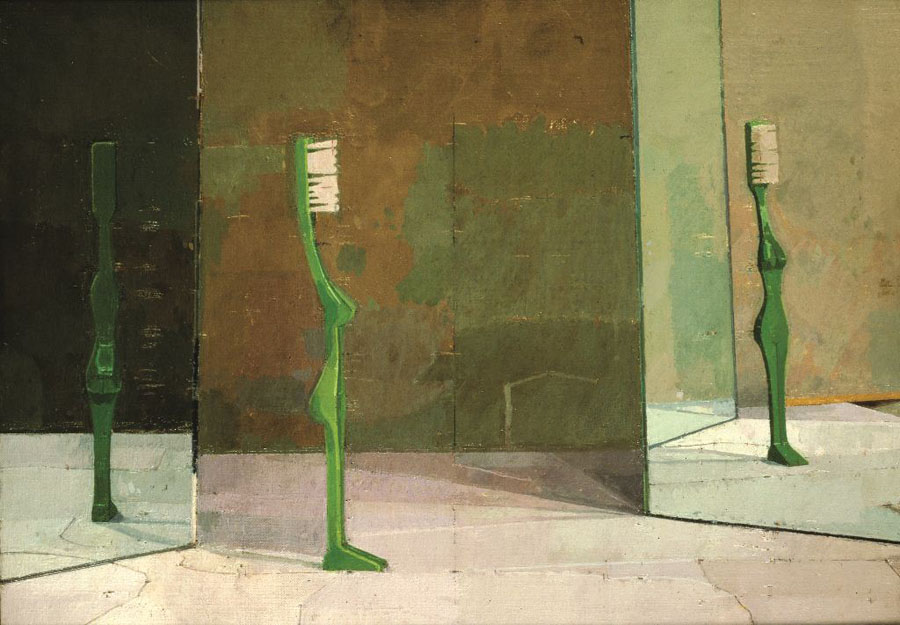

David's toothbrush is an unfinished work of which, like the coat hanger, I own part, mine being at the stage prior to casting. Had their lives continued they might have come across a unified theory of art but I doubt it ... no one else has.
God's Socks
Unable to knit I once had a large pair of socks made for me.
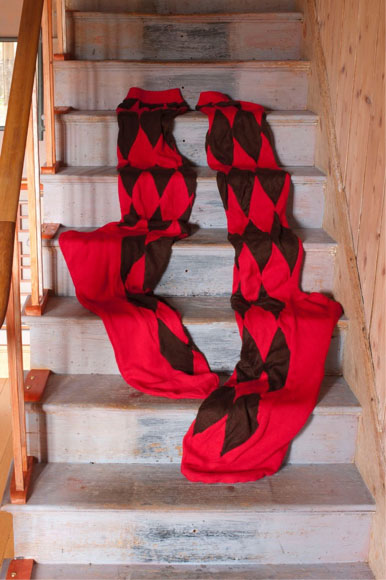
As a child I had imagined God to be really tall and because I had such awful eyesight I would only see his feet end if he let me approach. What I asked the knitter for was a diamond pattern of 'black and red' and a mistake on one leg (up the revolution)
Another memory from those early days was of a tall teacher telling us small children to "Tell the truth and shame the Devil". These and other memories make me think that these days I might have been content in the Epicurus Garden attempting to 'live unseen'. Conscious so many years after Epicurus makes me think he might, these days, have different thoughts about the Gods as though there are still lots of them they and we are squabbling still.
One of the Deities, who may have made the Big Bang, also made the whole of time and must be outside it; this Deity may simultaneously know and not know that we are inside of their Universe at differing times with different things known to us. This time factor seems to me to complicate our belief systems. We are here for but a tiny fragment of 'Now' so might like to have a rethink about what each of our Deities is up to and perhaps rethink how humanity relates to what his/her Universe is made of and from.
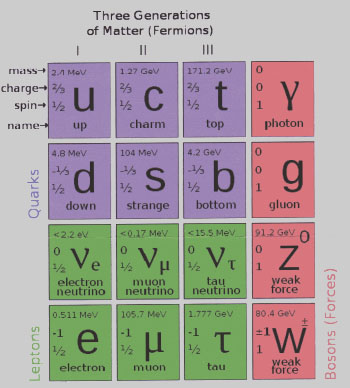
This table is from the physicists, many of whom have no beliefs outside of their quest to find out how things were/are made. Here we have the tiny particles humans have named as the basic ingredients from which the whole universe is made. If you were busy with the functions of these and decisions like whether to make 'space-time continuous or granular and discrete' you might seem not to inhabit the same agenda as most of us but prefer to hop onto the Epicurus bus bound for the place 'where not to attract attention'.
In that Garden of Epicureans, the then Greek gods were far away on Mount Olympus being immortal and had little time for humanity, getting very cross for example with Prometheus for giving us fire. These days I cannot begin to imagine what a deity would be like or whether they would have anything in common with the inside and outside of time. I, of course, may be wrong but can't see how humanity could have an identity outside of time where there is no past or future or space to be in and look at.
In my own childhood as I dreamed of god's socks at the church on the left I had no notion that it would be knocked down and rebuilt.
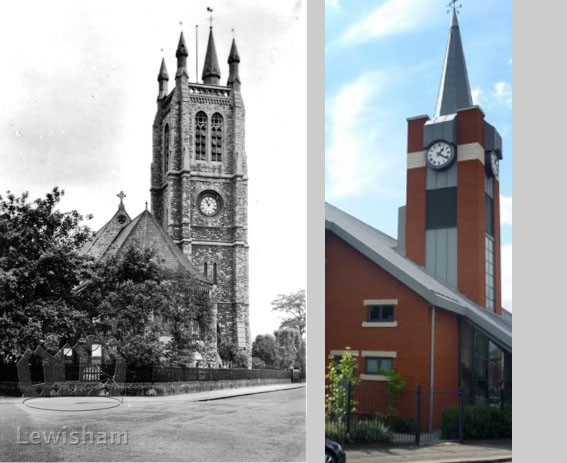
St Georges 1950 (left) and St Georges 2010 (right).
Visual Art along with other things changes rapidly; we would do well to remember it is to be shared as well as owned and made to look at as well as be talked about.
Looking Glass
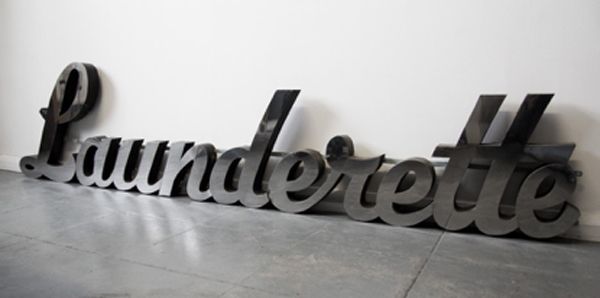
My painting 'Reflection' came about after memory of a moment in a launderette; I was standing in one very soon after I left art school. It was dusk and as well as seeing through the window into the street the reflection of the shop began to appear. My then girl friend, who was walking past, suddenly saw me and stopped inside the reflection of myself; something clicked and I knew I would always remember the moment.
There is plenty to think about in relation to reflections and there are paintings that have used their magical qualities. As a child I wondered if the mirror itself was reflected, if I would be able to see me from that other, reflected side.
In Camden Town, at the library I think, I saw a mirrored box dug in the ground with grass on the bottom; this wonder made another layer of grass beneath the one I was standing on. I was transfixed and tried to use the notion in my periodic table film; here the thought was that after 'the table' had burned the ashes would be collected and put back into the earth to spread out by reflection, alas this part of my work was a technical failure.
Yesterday I went to see the Royal Academy show
called 'Abstract Expressionism' and while there 'reflected' on
where and for how long the paintings have been around. I have to
say that these days I can just about stand for long enough to
begin to engage with a painting and this show's works are special
to the lifetime I have spent looking; these paintings were, still
are, at least half of my 'starting block'. The older I get the
longer it takes to begin looking deeply so I walk round until I
choose the pictures I will try to look at for longer; I can only
manage two or three works for a long look but still love my
initial wander to begin the trance that hopefully will come. This
particular show is going to be difficult, as it so often is with a
'short show, because there are so many wonderful pictures and I
will only be here for two or three hours. I choose and begin my
gaze: "Art is art, everything else is everything else." This Ad
Reinhardt quotation means I have to leave words behind; I try to
but it takes a while because we have allowed them such dominance.
If there is a flow from the work then I shall be away for a while;
the gibberish is a bit like this: -
Belle Époque with due thanks to Alice I'm
late as my mother sang in a better mood but she was mad hatter
and all the time so many blanks fired there's the two slits and
I'm the screen please send me the right drips from my brush and
death is easy for Paddy Dignam or as he himself put it the other
one
"bababadalgharaghtakamminarronnkonnbronntonnerronntuonnthunntrovarrhounawnskawntoohoohoordenenthurnuk!"
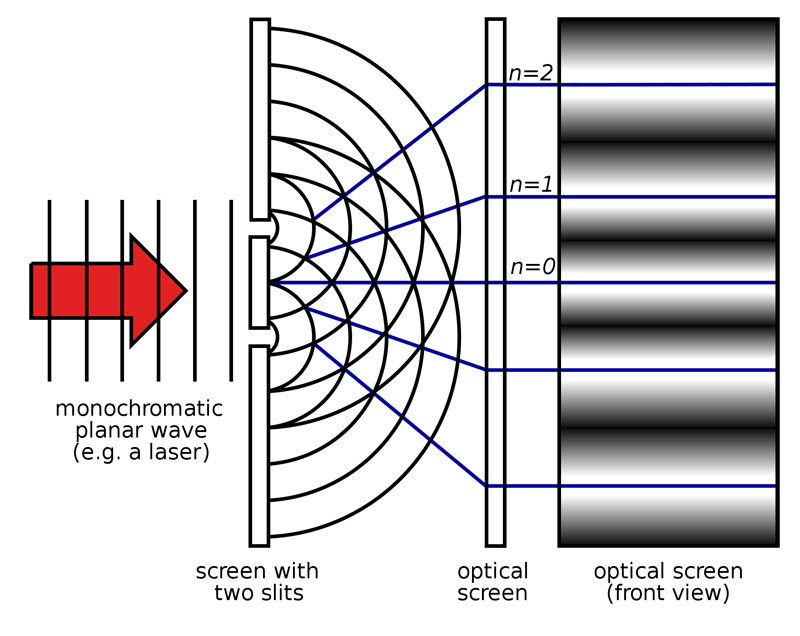

but where we are ultramarine no cobalt mix no oh no Prussian and my mother begins her madness with a claim to rocking chair she saved but blazes did over and over with hand on shears get that out of mind. Stop talking reading and look you fool all that time where have they all been before you were there and walk through into...
While all these musings, 'gibberish' is not anything like what's in my mind, and quotes from Finnegan's Wake flow about, I am in what we call a world of my own and I have no way to convey what these paintings are making me aware of. I adore my time with art and truly think that it is all that might save us, lift us up to where we dream. My brother in law was a scientist who once told me that he thought science would one day explain the arts. I think it might well be their fusion that helps us. Reflecting on the past, wondering where things are in space-time and not really knowing where I was when in front of these abstract expressionist works helps me think of the past and its relation to memory. I feel fairly sure the distance between yesterday and my being in a launderette in 1969 are more or less the same because memory is outside of time.
As I look back now I am so glad that I was introduced to looking and thinking about what I see and am also delighted with the unveiling of a quantum world alongside the vastness of the universe, of the large and small fully amplified. Visual art, more than anything, has fueled my imagination. If I put myself into another sort of trance I can lose objects and begin to glimpse all as atoms in which mine float only separated by density. Well, I say I can but as I'm a member of the ethereal Richard Feynman fan club I hover around and alight on the term he uses ... "screwy".
I know that the things I look at are just
'tweaks' in my brain, a transition around the "screwy", a dream of
large and small, of science imagination not versus art imagination
but hopefully more like an atom. Atoms are, as Richard Feynman
tells us, the best thing we could tell other creatures we have
found out a little about.
I'm up for uncertainty and its reflection.

Museums

There must be many collectors whose objects of desire remain private but Mr. Horniman of tea and teabag fame gave his freely for education and wonder. A long time ago I briefly worked in Horniman's Museum; it was a joy to be there where, as a child, I had pushed my nose against many sheets of glass. I remember asking Elisabeth Goodhew, the then curator, about some of the things I remembered from my childhood especially the 'Spanish Inquisition Chair'. The chair, one of the many objects amassed for collection was removed during a time of doubt but is now on show again with a tweak of explanation.
As children we collected stamps and autographs where quantity at times seemed as valid as quality. My elder brother acquired an Australian stamp put it on a self addressed envelope and sent it with a paper sheet folded into four to 'the great cricketer'. A while later the envelope was returned with four Don Bradman signatures that were cut up to use for 'swaps'; quantity v quality being unrealized but still, at least for a short while, alive as a memory. He had of course kept one in his scrapbook of
|
|
|
 |
 |
signatures and newspaper cut out prints; one for cricketers, one for footballers and one for stars of stage and radio.
Private collections can be surprising; a favourite of mine is/was Robert Opie's that became so interesting that it moved from the private to the public domain. Mr. Opie appears in the 'Cultures of Collecting' a book that wanders through many collections and includes the wonderful Kurt Schwitters.
"I could see no reason why used tram tickets, bits of driftwood, buttons and old junk from attics and rubbish heaps should not serve well as materials for paintings; they suited the purpose just as well as factory-made paints… It is possible to cry out using bits of old rubbish, and that's what I did, gluing and nailing them together."
I don't think of my painting paraphernalia as a collection any more than the torn paper I used to make collages many years ago but Mr. Schwitters and other artists like him collected with passion and an eye that might take us by surprise when reassembled. The image of Robert Rauschenberg's Goat has remained in my memories and hopefully I shall see it again soon for real, rather than pretend I can see it. Here I perhaps ought to say that although images are really useful sometimes unless you are there the photographs in our memories are like shut filing cabinets.
Here for example is an image of a rock I own which is from the Outer Hebrides; this 'free' sample was collected and given to me and may be around three billion years old. When I first held it I trembled a little; it is in my left hand now as I manage my two finger typing and it still gives me something or other.
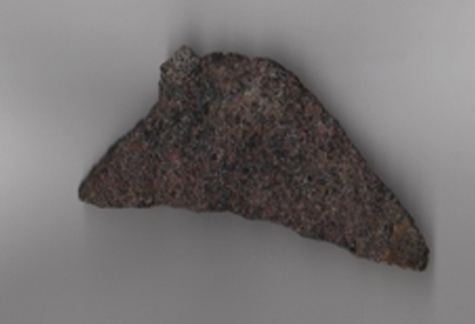
During my mother's final year we made a trip to a museum; I had just given her the lewisian gneiss sample collected from the Isle of Lewis. When I told my mum the age, she held it tightly and immediately, as many others have, demanded, "How do you know"? The conversation went on and I told her there was some Moon rock in The Natural History Museum. A few days later we were in front of the moon rock. Part of the adventure had been a pause to stand on the earthquake simulator where she held on tightly as we shook a little.
My mother often held a hand up to her mouth when deep in thought; she took this stance for some time staring at the tiny fragment from our moon. On the way out from the museum she still seemed deep in thought but even so managed, "Very, very interesting dear but before we go can I have another go on that shaker thing?".
As we wobbled my rambling thoughts took me to Shaker Chairs and the ring of stones on Orkney.

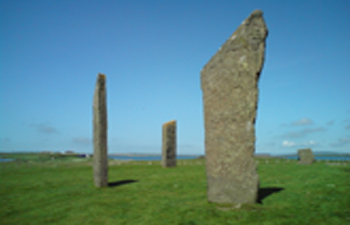
My mother died quite soon after our trip and I remembered the woman who had given me my life in a couple of my paintings this is one .
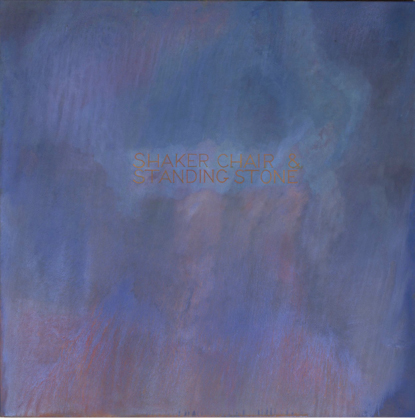
Art Triangles
Many years ago Jasper Johns remarked, "I can imagine a world without art and it's not a bad place"; like Donald Donahue in his 1980s Reith Lecture I too wonder what Mr Johns meant because I think we would be a lot less well off without it as I like to know it is there even when I am not looking. Mr Johns may have meant that as what he and other artists did was so inaccessible for most people it didn't matter much if they saw it or not or we don't need to see the stuff itself to feel the benefit. Donald Donahue talks about this and lots more besides, his lecture is possibly as difficult to understand or follow as what he is describing but as he says himself judgements are tricky.
Post Marcel Duchamp we have had to become thoughtful about how we look at visual art what with reproductions and one thing or another. But long before that there were paintings like this one and I have no idea how they were perceived in depth, perhaps it was the overlap between beautiful depiction and belief in a deity.
 |
|
 |
I remember, when a student, gazing at this and being told, among other things, that this Bellini painting depicted a classic triangle composition and it is easy to see a separation between the Madonna and the background. I can imagine drawings of this work that did not include the background, focusing perhaps on arresting the ideal. In our life drawing classes we students were taught not to do this but to look and record everything in relation to the dynamic of the rectangle.
One of our tutors, Euan Uglow, among many other things emphasised the notion of tension between separate objects. Euan was a hard-nosed teacher who I got to know a little when I visited his studio in South London to do a couple of electrical jobs. More than any of the other teachers he made me see spaces as ambiguous; this is a bit tricky to explain but I'll have a wander and try to. Painting and drawing is a flat process coming from looking at a three dimensional one and very different in procedure post Cézanne; I recall Euan talking about Cézanne a lot, about 'painted space' being a shallow illusion. Euan's paintings seem in one way to be an action in a shallow arena and though not separated like the Bellini separate none the less.
If I focus onto flatness this painting makes another 'model triangle' with the tension between the head and feet as an imagined line.
 |
|
 |
The dignity of this woman rests within art; within art her depiction is made manifest by Euan's striving towards the way we see. What he gives us is a context for seeing things around us when we are thinking rather than functioning; one has to do some work oneself to connect with his thoughts. We can, if we wish to, play with the space by allowing ourselves to 'dream' the event. The 'event horizon' of a black hole is well worth finding out about as are the edges of Euan's rectangle because as with the black hole the rules change inside it. I freely admit we do not have to know how things work in order to use them; we can all enjoy looking at art for different reasons but as Richard Feynman points out in one of his talks we can also enjoy a deeper look.
 |
|
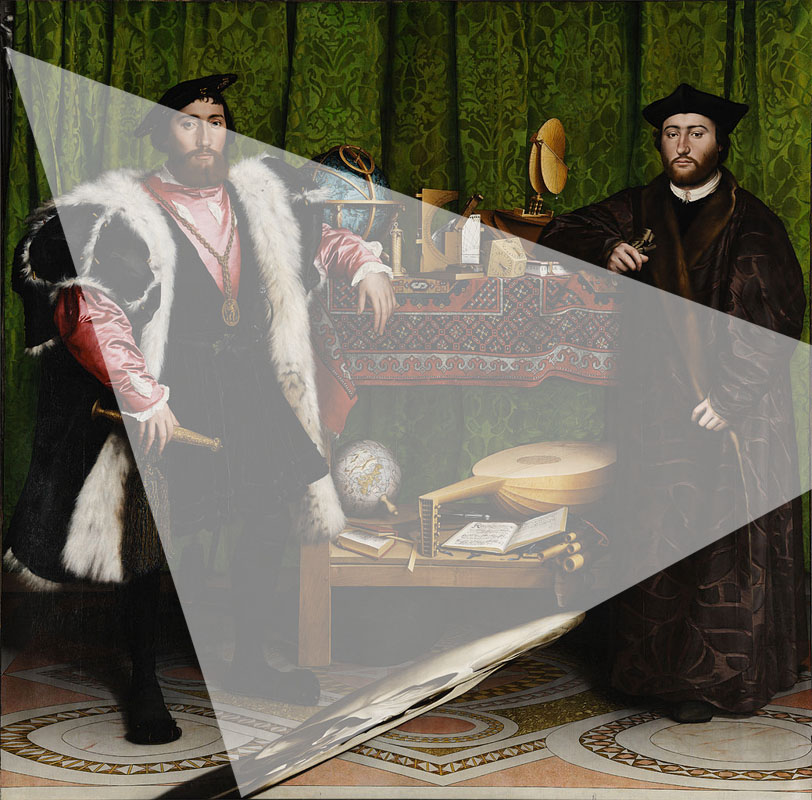 |
This strange work conceals many possible adventures; when I see crouched lookers I know they can see the skull in a different way from me and that this painting perhaps gave me an entrance to the 'art triangle' becoming more abstract; that as they saw their triangle I could begin to see another
Along with many others I share the joy of looking when I'm in front of 'Manet's bar' and in my early looks soon saw the triangle between the three pink bottles.
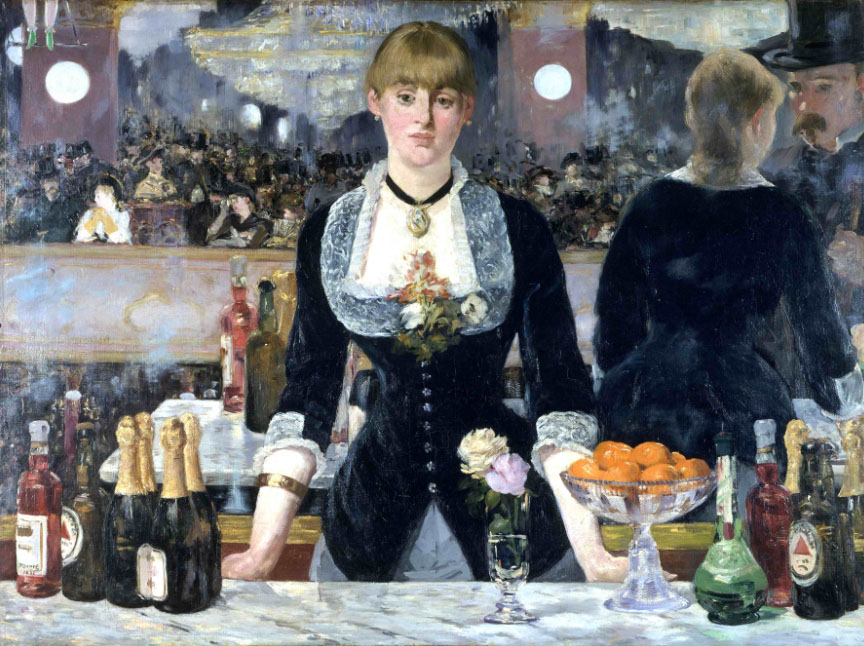 |
|
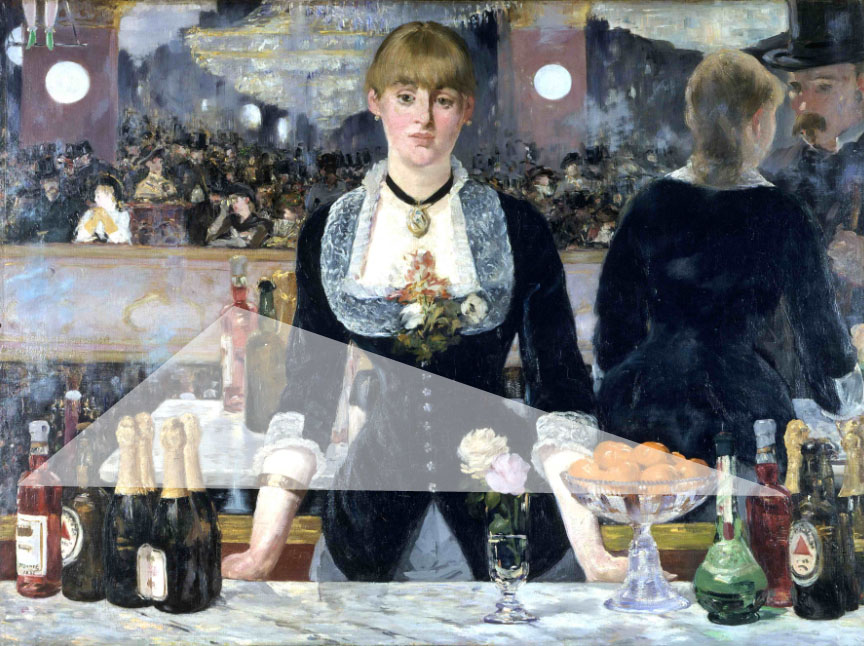 |
There is another triangle to be made between three people, the man with a top hat, the barmaid and oneself but as with the Ambassadors one has to stand in the correct place. I once had a rather tatty collapsible top hat that I took to the gallery to wear for a moment in front of the painting; what a thrill that was. I also began to connect this picture with Vermeer's 'The Music Lesson' where among other things the mirror, like Wallace Stevens's Blue Guitar dose not reveal things as they are or at least appear to be. Mirrors can be a real world of our dreams especially when like Alice we wander through the looking glass.
 |
|
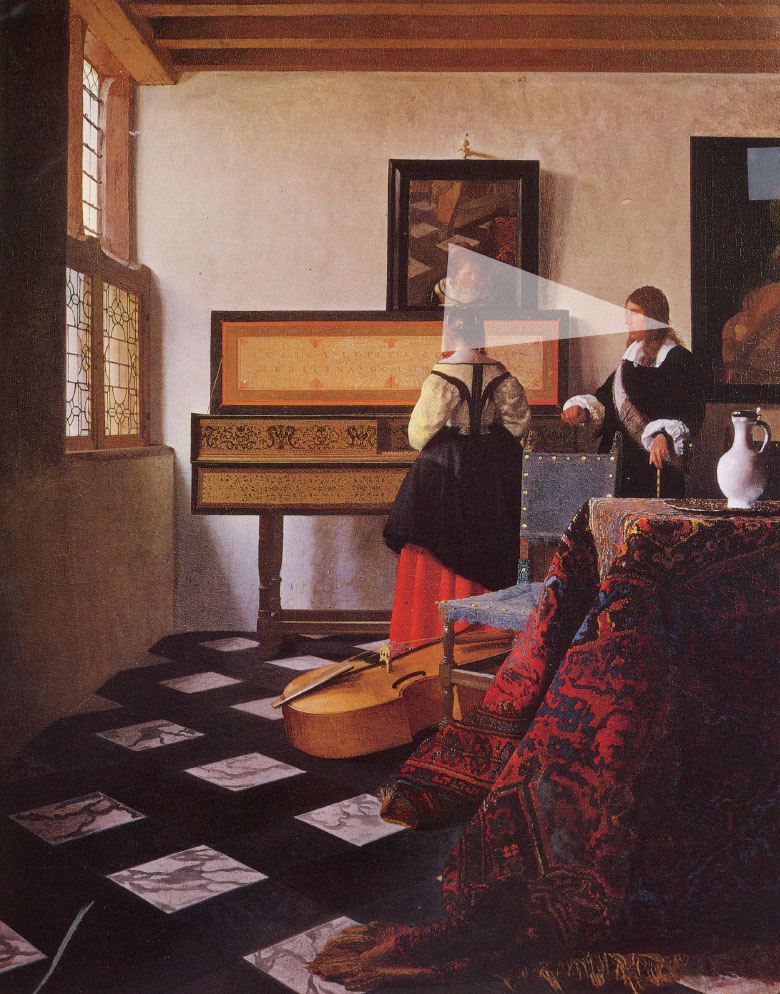 |
In my quest to understand art more deeply I even imagined the triangles Julian Barbour speaks of in his science lectures when he discusses what we see and exist in as being an illusion.
Jasper Johns was around during what I think of as the heyday of Abstract Expression, when the school was split enough to have paintings like this one painted by Jackson Pollock alongside, but very different from, the one painted by Mark Rothco.
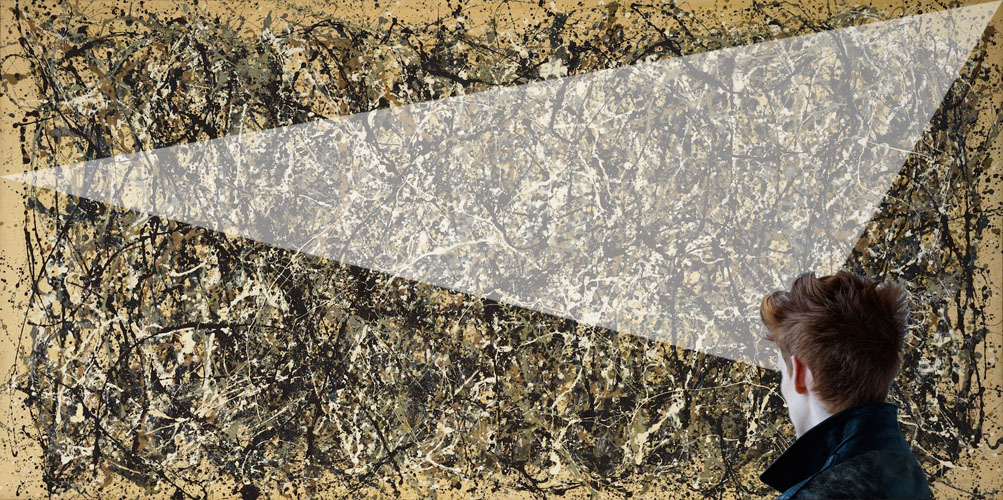
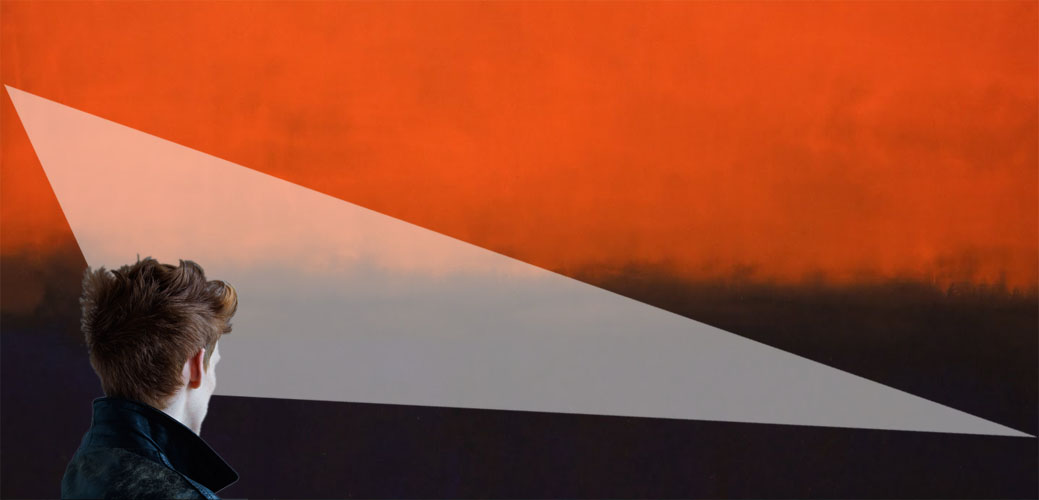
The two New York schools knew each other well but approached work differently and these days I am happy I was at art school during those vibrant years. If you can imagine triangles made between yourself, another person and one of these paintings you can dream yourself into the layers of paint.
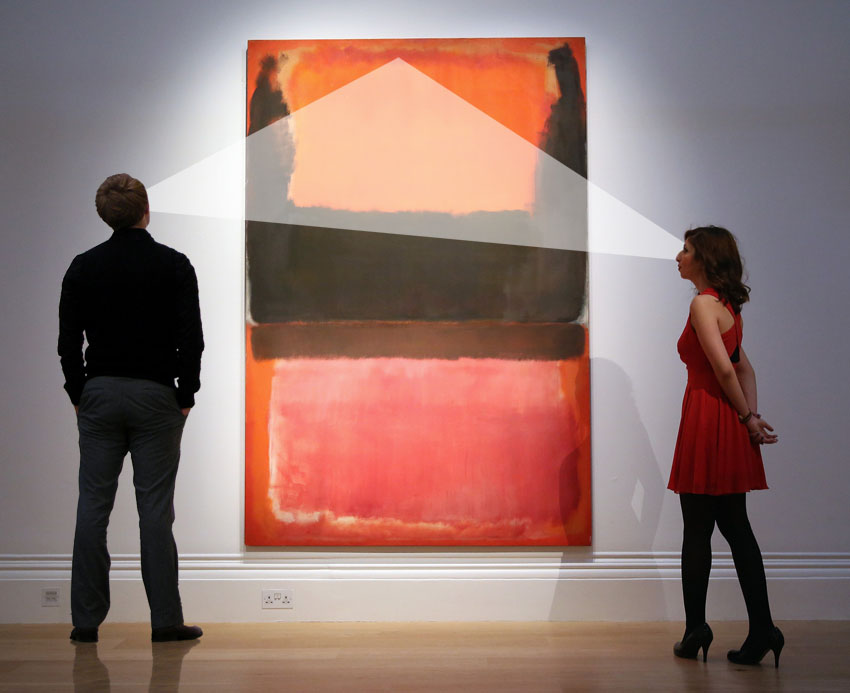
When I was sitting in a Marc Rothco exhibition once I watched as people in different coloured clothes walked between the painting and me. It took a while to tune in to a new way of looking but a crowd is sometimes as good as a look on ones own.
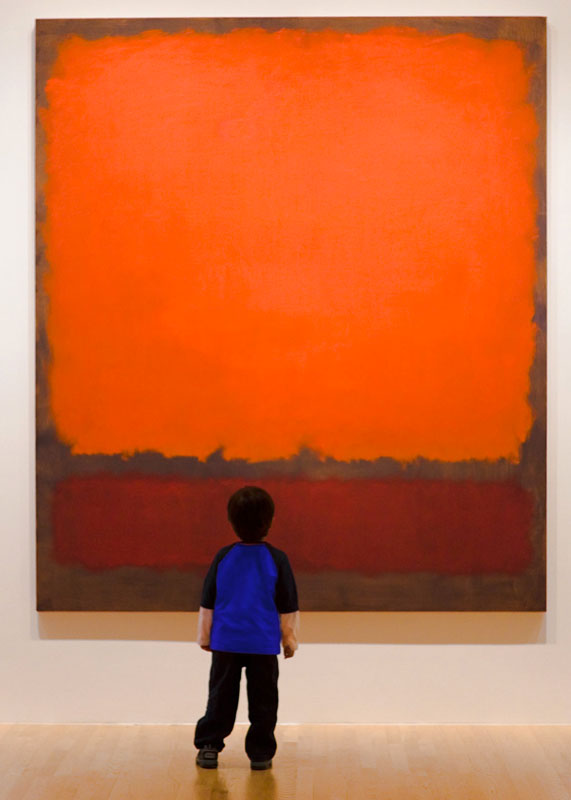 |
|
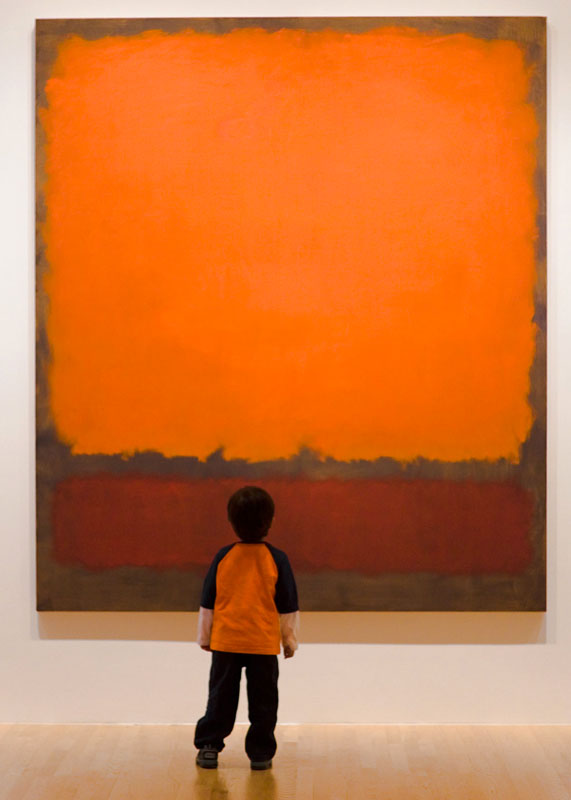 |
Colours change in relation to one another as Joseph Albers points out in one of his books and Art gives meaning to our lives; without it we might as well be asleep without dreams.
Photography and two Marcels
The complex story of his grandma, love and a photographic image is laid bare by Proust in his novel 'A la Recherche du Temps Perdue'.
Here is the only photograph I have that shows an image of my grandmother with me, alongside my mother and my brother. As I look now I suddenly realise this was almost certainly the only time I saw my grandmother's knee. As I write this I see how easily I am diverted from the relation of the door in the background to the shelter entrance and my elder brother's shirt with a reciprocal diagonal of door, chair and trench travelling from left to right.
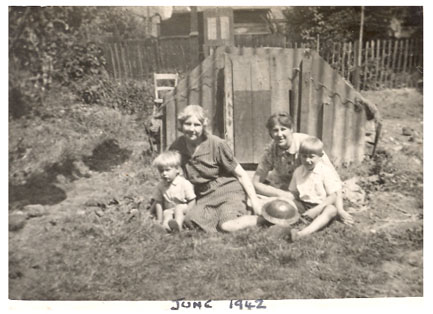
I was taught to look at art school and, consequently, need time to take things in. As well as the process of analyzing picture planes for example there is the quality of an image's surface; whereas daguerreotypes and some silver nitrate reproductions had interesting surfaces many of the images we see today do not. Cropping images as well as streams of reproductions completely changes the way that we see things and even though there was/is a long history of printing it was photography that pioneered new clues to moments past. Images as well as documents of ordinary people could now be seen by their descendents. I suppose that remembering 'the time' of my grandmother and remembering what she looked like are entwined; but memory is tucked away inside our heads in compartments that are not always in agreement.
If I stay with the thoughts of my Grandmother I
can try to picture her though it is not her face that I can
conjure up but more her movements and the things that I recall her
saying. The whole business of looking was, as I often say, altered
for me via the long process of learning figurative drawing and
painting.
The Proust approach is contained in the literature he rated most
highly but this quotation from the other Marcel, that's M.Duchamps
made me react in a quite different way
"In the 'Nude Descending a Staircase,' I wanted to create a static image of movement: movement is an abstraction, a deduction articulated within the painting, without our knowing if a real person is or isn't descending an equally real staircase".
Repetition of an image within the composition of
'Nude descending a staircase' made me want to take a risk too;
this is what I did.
I was living in a house that had three apartments and I was living
in the lowest. I climbed the stairs until I was outside the door
to the uppermost, turned and slowly descended until I was back
inside my bedroom where I got dressed. I made twenty-seven
drawings of a staircase and hung them all the way up or down our
collective stairs without the other residents ever knowing that I
had walked up then slowly down sans clothes.

I chose steps from a spiral staircase and like
the ones shown, looking down; all of the drawings had a letter in
them but nowhere in the work was there anything like a photograph.
This work happened while I was recovering from a shock that
changed the way I thought about what art might be.
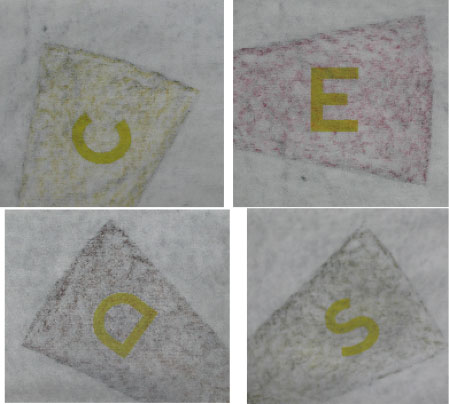
If I return to my own 1942 family snap I can these days copy and crop it without scissors like this; now plenty is lost but ... what I
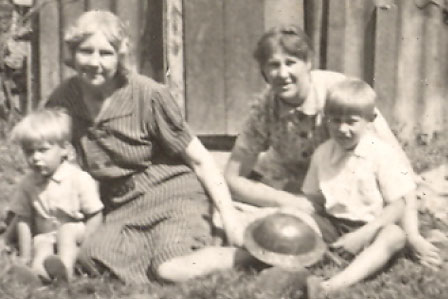
find curious is my interest in the loss of
"June1942" ; I have no idea who wrote it but it evokes plenty of
things within me and causes me to take a new look at the image.
Marcel Duchamp may well have disagreed with his namesake on some
issues but I imagine that with Man Ray there the three would have
had many interesting exchanges. All art needs time to engage; I
was once in too much of a hurry but nowadays find myself
transfixed once connected with a work.
When students leave art school and try to engage with the art
world [human] engagement with so many other things begins. For
those who are sucked into the world of business, with their works
selling for high prices, there is more of a pursuit of uniqueness
than finding where art might be. I know this is difficult
territory but I am grateful rich people haven't yet bought
theatrical performance and so some current thinking is freed from
a desire to possess, to own.
One of my friends, a good deal younger than I am, paints
figurative images that many of us might well and often do take
snaps of. When I sit and look at his paintings I am changed; he
is, [along with a few others I don't know of,] preserving an
aspect of looking and recording it would be sad to lose, perhaps
even a disaster.
Humans always live in dangerous times; we are mostly quite
wonderful but this doesn't allow for or can't prevent even, a few
of us from behaving in ghastly ways to alter our dream of Utopia,
umm ... I often muse as I read 'how good that would be' so I leave
the last words to Marcel Proust who for me invented The Tardis.
"Real life, life which has at last been uncovered and illuminated, the only life in consequence fully lived, is literature. This life in a sense inhabits all people not just artists, at every moment, but they do not see it because they do not attempt to illuminate it, and so their past is littered with innumerable photographs, which are useless to them because their intelligence has not developed them. Our life and also the lives of others, since style for the writer just as colour for the painter is a question not of technique, but of vision. It is the revelation, which would be impossible by direct or conscious means, of the qualitative difference in the way we see the world; a difference which, if art did not exist, would remain each persons internal secret. Only through art are we able to escape from ourselves; to know what another sees of a universe, which is not the same as ours, whose landscape would have remained as unknown to us as those that may exist on the moon"
Thanks to minds like Marcels and his generosity of spirit we are less doomed.
Eleven A, Peacock Yard.
N.B. before you start Pop this into google
https://www.youtube.com/watch?v=ZRltMej-hSQ
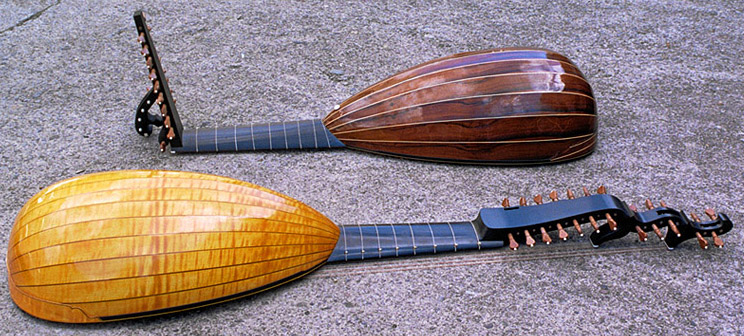
There are still a few workshops around London city where health and safety in the wrong form is kept at bay. Outside this shrunken domain our responses to the world around us are slowly but surely being eroded. My 'adopted' granddaughter rebukes my wailing as 'moaning' but I am shedding tears of sadness that so many of the children I once taught were taken away from the joy they were finding in making things to be put into grown up Legoland. T-mor, my granddaughter tucks her skirt up and climbs a tree in our garden; my urging her to ascend is an aspect of Meccano, were I to request her descent to 'safety' I would be imprisoning her in Legoland.
When I look at some constructs from the wonders of our day there are echoes of Meccano but mostly Lego dominates our thinking. As a child I played with Meccano sets, back then there was no Lego; one difference between these two important toys is to do with space; Meccano made space with ease and so I was lucky.
Part of a lute is about the space where the music is hidden; on completion we see inside this part with difficulty where one of the joys of a beautiful lute is its possibility of holding another. Around the area of the Elephant and Castle in London are many memories from my childhood that are pleasures too deep for me to explain; to pop into Peacock Yard where the artist Frank Bowling has a studio has become one more. I have only looked through his window to see his racked works but maybe one day I'll be lucky and meet him there then jog his memories of Camberwell School of Art where he taught us in the 1960s.
Next door but one to Frank is Eleven A and up a staircase is one of those places 'Health and Safety' would love to close, unless the two who work there gave up Meccano and took to Lego. Inside this workshop Steve Barber and Sandi Harris work long hours and there is a simpatico between them as they change one thing into another.
|
|
|
|---|
Inside their workroom I imagine the Arc de
Triomph from where there are so many roads I might wander or
glance along but always return to the circle from where the
journeys might begin.
One of the meandered trips I imagined, when last in their
workroom, hides in 'jars of memory'. Sandi and Steve have saved,
in jars, many of their wood shavings, which are all different yet
all the same; they are there in stacks for visitors to gaze at and
dream. Wood shavings from a hand held plane are different from
those that are left from a planer thicknesser; they hold the
secret link between a tree and the lutes that travel out from
Peacock Yard and into concert halls up and down the land.

These shavings, collected in jars, are neither a tree nor a lute; they are a bond like the space in the lute's body. In order to hear music we need the past because music relates to time differently from paintings or hand made objects in art. When I asked Steve and Sandi if they were artists they replied as one that they were artisans; I feel a need to get closer to understanding their distinction. This is such a tricky place to think and if they are correct then the relation between beauty and art needs the thoughts of brighter minds than mine. All I have to say is that beauty is in the present and art is in the past; I know it's an incomplete thought but I'm struggling. I cannot make or play a lute and wonder about both the time it takes to make one and the time it takes when played. Language can bring safety to a thought and those of us who struggle with precision often give up. Like my art/craft dilemma of not being able to connect a maker, a player and composer I give up the struggle. I shall just have to live with my frustrations, with my longing to understand in words what it means to make things and how we choose to grade the differences.
Sports, where I am a spectator, means I live in constant fear of a final result, so I confuse memory with outcome. This difference took me a long time to spot and even so I do not know what it means, like my longing to see art completely I wait hopefully until time departs and I am immersed outside of the passing hour.
I held a baroque lute I could neither make nor play but as Steve and Sandi worked I watched feeling closer to humanity than I had for a long time. What they do for us all is like their collected shavings - a link, a bond, between one thing and another; a mystery but beautiful, quite, quite beautiful.
A lion hunt
Along with other visitors I love to sit and gaze in wonder at the 'The Assyrian Lion Hunt'. This British Museum wonder has become for me a kind of time machine. My life changed dramatically in 1961/2 when I worked on the roof of the museum with no knowledge of this treasure beneath.

During the final year of my apprenticeship I was
given small jobs with more responsibility. On one occasion I was
left to finish off a few loose ends before rejoining my engineer
Ken Scullard at our next location. I was given the address,
followed by, "But only when you've finished ...and make sure you
do a good job lad"; along with "... get to the main gate of the
museum and show this chitty, walk towards the main entrance, don't
attempt to go in but turn left at the bottom of the steps. Walk
round the building until you get to an iron ladder attached to the
wall, climb up it till you are on the roof. Follow the footprints
in the snow until you get to a blue door marked 'Duveen', it's
painted on in green; we'll be in there".
A while later I arrived, climbed the cold metal
ladder and there I was on the roof of the British Museum following
footprints in the snow up to 'Duveen'; Ken and Bill Fry from the
office were behind the door pouring over drawings. I joined them
as they discussed the layout and thought to myself it's the same
as the one we had just completed for Coutts Bank in Lombard
Street. Large fans would be intermittently turned off and on to
suck in the London air then passed at pressure through a field of
water jetted sideways across a metal box. On then through a shield
of vertically stretched wires at high but differing voltages, dust
and dirt collected on these in a similar way to the layers on our
radios and television sets; intermittently the current would be
turned off then the wires washed, dried and turned back on.
Heating and ventilation engineers installed this into a walk
through metal duct; our task was to install the control system.
When Mr. Fry left Ken and I began the
installation by laying out all the controls on the floor until Ken
was content with the look. He was what these days might well be
called a fussy bugger but I admired his determination to make our
installations look good, as well as work effectively, even though
they would seldom be seen.
During the installation we walked about the roof space and Ken was mesmerized by a run of ten or so conduits that were beautifully arranged. The concentric bends and curves had been engineered by a master craftsman and praised by Ken with many expletives. At the end of the job I suggested to Ken that we go and have a look around down in the museum. "You can if you like, them posh sods down there won't be up to see our work or that beautiful pipe work so I'll be in the café, don't take long".
All I can recall of my first ever walk through the museum was that I had to ask the way and that when I got to the enormous Duveen Gallery thinking to myself... "Christ they're all broken".

Strangely, a year or two later, when I had become an art student, the first art history lecture was given by Michael Podro , "Here we see the beautiful Birth of Athena from the Parthenon ... left to right virgin, nymph and crone..." It's hard for me to imagine the differences of looking between being an apprentice electrician and an art student but even harder to think that they might ever happen the other way round.
Whenever I go to the Cornelissen art shop I take the opportunity to visit the British Museum nearby, to look and marvel at the Assyrian Lion Hunt. The Duveen Gallery next door has always included my personal encounter with memory; I look up to the glass ceiling and recall the time there before my life changed completely. I wrote to the museum on two occasions to request a visit to the roof where I wondered if our installation was still working or 'Ken's conduits' were still looking beautiful; sadly for me my letters were ignored and there was no reply.
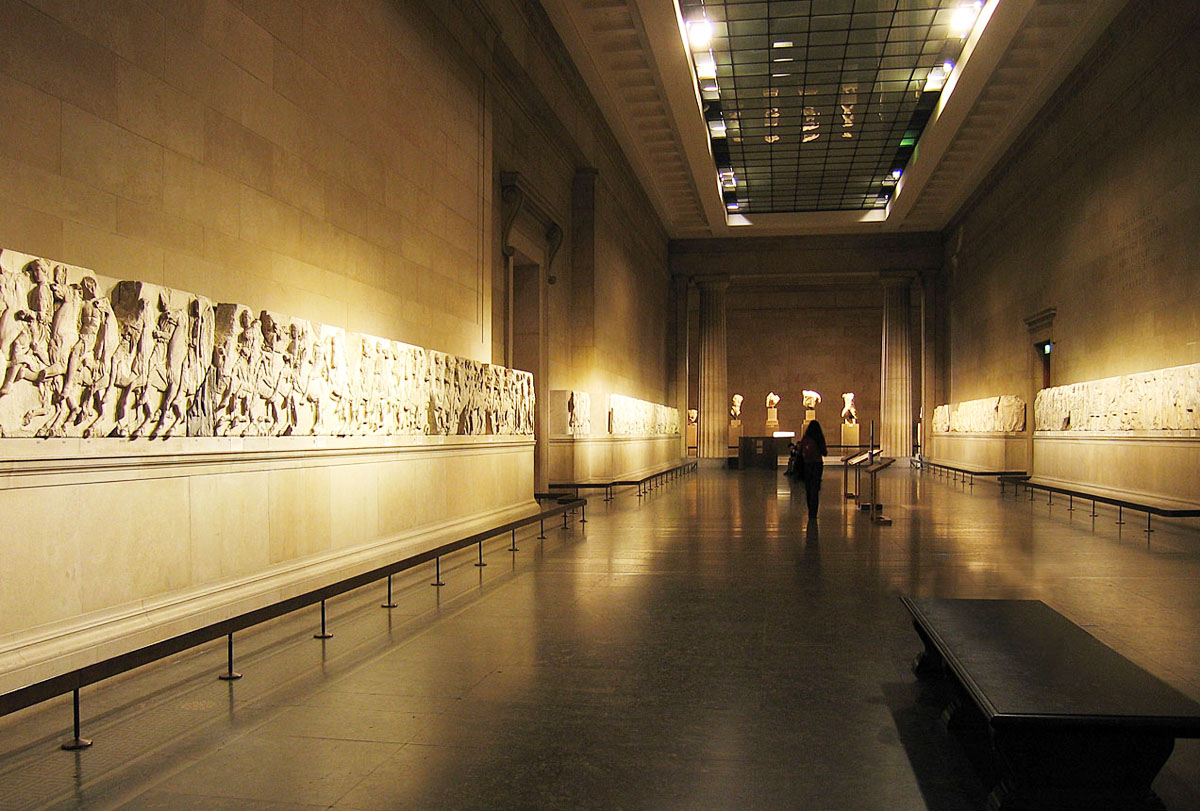
I muse through these memories as I gaze at The Lion Hunt, alabaster reliefs that once adorned a corridor; we are lucky enough to be able to walk along in wonder as a few Assyrians did more than two and a half thousand years ago. What is it about this relief that enthralls me? Well to begin with they are the correct height which may well sound trivial but, if I remember from the history taught to us by Michael Podro, what we see is influenced by how we engage. What he didn't point out was that in a way the 'Duveen arrangement' has turned the Parthenon inside out, whereas the Lion Hunt is as it was, though no longer with their colour.
In my last year at Camberwell Art School Michael bought a house in Chalk Farm and asked me, as other lecturers had, if I would rewire it for him. This was to be a complete rewire rather than tweaking studio lighting so I spent a lot of time there over one of the holidays as well as the odd day off from the college. I was lucky to get this job because it meant spending time with Michael; once or twice we sauntered down to Marine Ices for a cornet and Michael always chose chocolate and strawberry, strange the things we remember.
One knew immediately that Michael was 'learned' and different from other teachers at Camberwell. It's hard to be complete in a description of this difference; both he and they introduced students to visual art being entwined with something that reached outside of a gallery. One always went home from college thinking about what had gone on that day but the thoughts were different after an evening class of Michael's. One might be thinking about depiction for most of the time in and out of the studios and perhaps Michael made me more aware of my vanity than the others; what ever it was he certainly tweaked our thinking.
As students of those times, alongside the strong tradition of drawing and painting from looking at models, still lives and occasional landscapes, we encountered 'American' painting of both 'Field' and 'Abstract Expression'; I felt we were in safe hands as we responded to what we saw on our own with 'Barnet Newman'. Michael, had he had more time with us, would have helped our understanding and desires to be modern but being called 'an art historian' perhaps, meant we students didn't value his head rather than hand contribution; how wrong we were.
Imitation alone sometimes leaves little else but
muddy footprints; the history of painting and the history of art
are very different and Michael was onto this; sadly at that time I
was only kicking off my thinking and was more than a little naive.
As a student beginning to try and fathom things my way of looking at the 'Lion Hunt' hadn't deepened and I knew virtually nothing of the separations between human responses. Michael was one of the academics who bridged across to the visual world and did lots and lots of explaining only, unlike many of the others, he did it with 'would be artists'. Thinking back now, perhaps selfishly, he would have been an asset to art students in Camberwell rather than art history ones in Essex. One of the things I liked about him was his hesitation, as he described great works for us to look at one could imagine his re-seeing the works alongside his notes as he looked again 'with' us, his seminar groups; pitched and joined in our thoughts as well as adding his own which he never presented as highfaluting notions.
I made a mistake with Michael that I still regret; I was so a feared of my status that after leaving art school I stopped going to see him. Years later as I stare at the Lion Hunt and remember I realise that we might both have benefited from a few more visits; I hope that it's not presumptions to think he liked me not as the chap who wired his home in a thoughtful way but one who wanted to find out what art, as well as what a well painted picture, was. We need to know about the works done by others, not just to seek personal position but as contributions to something we are all part of and not separate from; this was something Michael kicked into our student arena.
As I stare at the lion hunt and see the chariot as well as the arrows whizzing past I think of Manet's Railway with Victorine looking out and her younger neighbour looking at other things also whizzing past; these are visual thoughts and I struggle to write about what I can see. Michael seemed to know that painting needed a better language of exchange than the one we often hear elegantly telling us what we can easily see for ourselves. It's taken me years to see the Railway and Victorine; I hope that art schools now have 'Looking at the Past' right alongside the act of painting; Michael in the studio as it were as well as in the library.
Like the semiconscious dreams of early mornings all of this races around as I sit starring at the Lion Hunt then up pops a notion of 'art triangle'. I remember Pyewacket from the film Bewitched and that a witch needs three things to cast a spell. In the chariot is the King, present but unpainted, also the lion (cat), dead and alive at the same time and me only separated by time from when the carvings were being made. It is a time of joy as I sit alone with my thoughts ... "virgin, nymph and crone" ... on the roof above where I once walked in the snow ... of my time spent dreaming ... now reflecting. What a shame we never made it onto the roof, there we could have chatted a while. Either way, 'Thank you Michael Podro, I think you were great.'
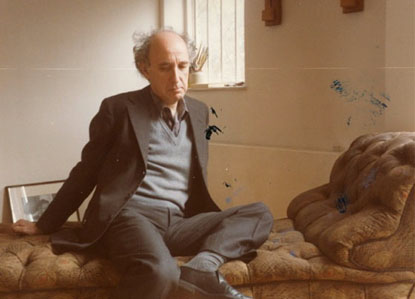
Shakespeare in stacks.
A while ago I made a work with Shakespeare's sonnets that ended up as fourteen stacks. I typed the first word of each of the 154 poems in a grid onto my first page, then the second onto the next page in the same grid formation and so on until I reached the end of the first line. As the lines have a different number of words, gaps appeared as words ran out and that made the first stack.
I continued with 154 words on the first page of the second grid/stack and gaps appeared again as I got towards the last word of the second line. This process gave me the said fourteen stacks. What I didn't do was finish the work because the way I envisaged it would have been expensive and what would I do with it anyway I wondered.
Here is/was the plan; I imagined the pages printed onto see through plastic then layered flat and vertically. They would have to be hung in a large space where they could be walked through or under perhaps and looked at so a viewer could see they were separated sheets and read the words. I might well have inverted them all but again when these sorts of works come into your thoughts limitations also appear. Another work derived from my stacks in 2001; I imagined pages nine and eleven of my work projected into the spaces where the 'twin towers' had been.
Works like this are frustrating because they are hard to realize; there is also the public/private domain to be thought about. ?? The Lion Hunt of Ancient Syria warms me because I love looking at the work and because I do not know the names of the artists who made it. Being anonymous strikes me as a difficulty for so many of us and I have had to learn to be anonymous which I now quite enjoy.
A good thing about my old age is how much I still love making art and knowing that almost no one will see what I do gives me a freedom I relish. I am still tempted by being told how good I am rather than how good the work is and yet there is a glimmer that this will pass as I get to be even older and anything I make will belong to us and not to me.
Not that long ago 'The Madonna of the Pinks' was spotted by Sir Nicholas Penny, then of the National Gallery; painted by John Smith it was nice enough but painted by Raphael it was a masterpiece. There have been a few Rembrandt's that have caused controversy in the art market because the money value changes with verification of authenticity; umm. If one thinks of tax evasion and tax avoidance in the same way as this, or fiddling expenses even, we might shift the art market back into the culture rather than it being the sole domain of the rich.
As art follows the mores of the times it has become difficult to be imitated and though works like those of Doug Aitken for example (View on youtube) are quite, quite wonderful they are far beyond most of our possibilities. Levels of art are tricky but if you are really into it and feel the thrill of making something appear the value belongs to you until work stops then hopefully it's for us all.
Having no notion from where my love of stacks comes makes some of my dreams an entertainment so when I heard details of Brane Theory in science I was attracted even more to the thinking than I was already.
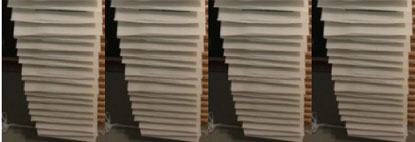
These days, like many aspects of art, science is impossible for most of us to engage with other than through popular books, television documentaries, science cafes or the Internet. I have thought about works related to science and dreamed of Marcel Proust's books arranged in visible stacks of pages. In my dream 'Brane' theory of how a multiverse might be arranged is fused with Proust's pages. Repeated words would light up making strings through the pages then fade and allow others to appear. Were I to become involved with trying to explain this dreamed of and longed for work stack I'd become sad because of my inability to see a future for it. What luck that I have my paintings, they are such a comfort; in the multiverse my imagined works are real, they would not be seen as dreams or random events although they would be that too.
Kirk Douglas in the role of Spartacus declared, "I know nothing, I don't even know how to read." He then goes on to wonder why the moon changes shape. I looked up his speech from the 1960 movie because I remembered only a 'frustrated fragment' from the first time I saw the film. In the art world, an equivalent of this imagined depiction, everyone is Rembrandt and only the audience knows what the truth is.
N.B.
Here is a link that explains Brane Theory
https://en.wikipedia.org/wiki/Brane
Jellyfish Eyeworks
I wonder what a jellyfish or a peahen for that matter actually sees; how different from our own interpretations I wonder.

When we see, there is a moment of change, from what's out there to how our thoughts organize the photons. We tend to accept as truth, science's thoughts and ideas about this process as, to all intents and purposes, these work well.
Richard Gregory, who wrote books about how we see, seems to have been a pleasant and curious scientist interested in optical illusion. 'The rotating mask' illusion was one of his favourites, clearly showing that our brains change what's out there into what we need to see.
The process of how an eye evolved is understood and even though there might be some debate about chance or deity we still share the joys of looking. Whenever I read books or listen to talks about how our eyes and brains work together I am fascinated; the complexity of visual perception and the fact that the illusion works is thought provoking.
I enjoy my time spent with the few scientists I have come across late in my life and though I know very little of the way that they respond to their world I like to think that, at the very least, we share a curiosity. One of the differences in the way scientists and artists relate to the past is their use of history. Scientists tend to adjust past thinking whereas visual artists just add more works for us all to share and look at; so, we all need "The shoulders of giants" but in different ways.
I may well be wrong but I feel Paul Cezanne might never have had the thoughts he left for us had Manet not found a new painting process. I am not entirely sure that all the Impressionists favoured the need to look back as well as forward but believe Manet had realized early on that he was adding and responding to a whole, rather that a current vogue.
I was recently in the wonderful Courtauld Gallery to sit and stare at the bar of the Folies Bergère painting by Manet and remembered The Hoerengracht by Ed and Nancy Kienholz.
 |
 |
|---|
The Hoerengracht installation includes a view that evoked in me a thought not dissimilar to one brought about by the reflection in 'Manet's mirror'; that you are in the same space as the illusion. Sometimes, if I get myself into the right frame of mind for this to happen, as I stand where the artist did, a 'click moment' might happen for me; that's when I lose my sense of time and space and seem at one with art. St Augustine said, "If I ask myself what time is I know but if others ask me I do not"; for me it is the same with art.
When I look at Vermeer's paintings I am sure that both time and art are different from the way I perceive them and that may, in one of my 'click moments', be an arrested memory as Proust describes for us. Time and visual thought unite in Vermeer's depictions in a way that grasps/holds 'now' in a completely different way from a photograph. There are many deep feelings to be shared when looking at paintings but not all of them have the status or grandeur of being still as in a Vermeer. In the Courtauld Gallery hung quite close to Manet's wonderful painting of the Folies Bergère is Paul Cezanne's Card Players. In the gallery I try to see a woman putting on her necklace, painted by Vermeer, between them and on the occasions my mind allows am thrilled to imagine the three united.
 |
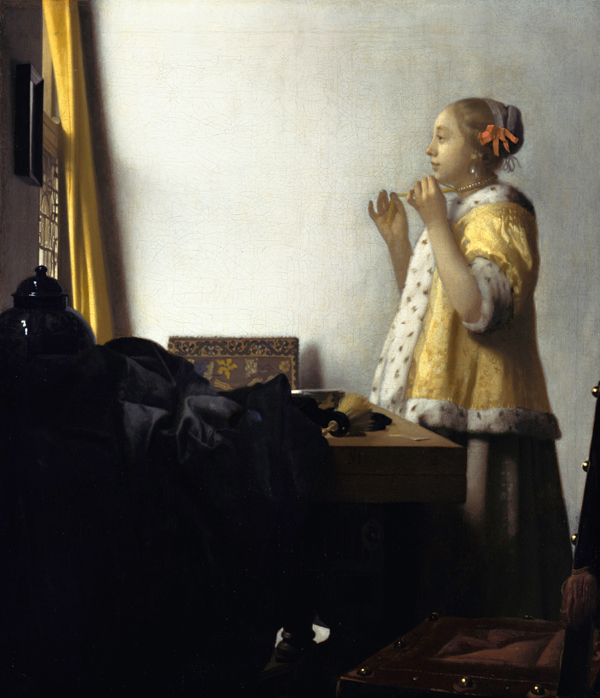 |
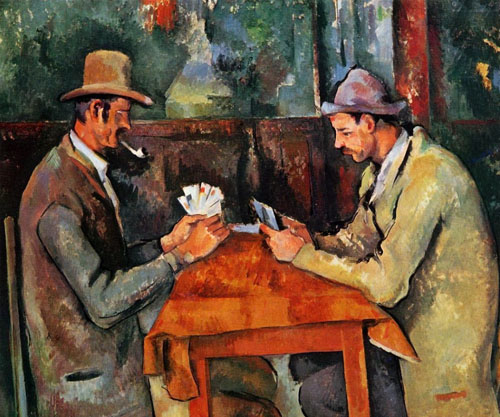 |
|---|
"Imagine Pousssin redone entirely from
nature; that's classicism as I understand it. What I will not
admit is that it is classicism that limits you. I want visiting
a master to take me back to myself; every time that I leave
Poussin, I have a better knowledge of who I am"
Paul Cezanne
I am still learning how to look at paintings and though it's a mundane thing to say I am so grateful for the time artists have taken to think in more ways than one and for the 'illusion' they have left for us all.
Back to titles
Karn Holly
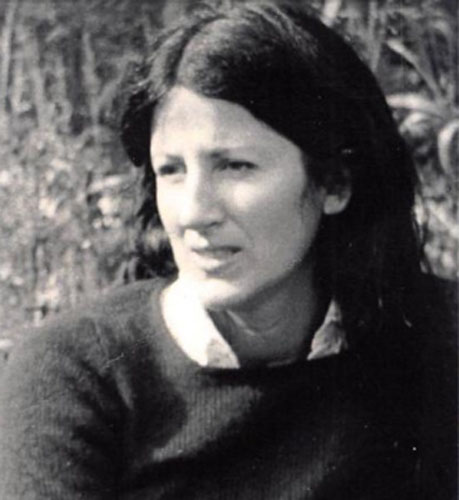
Way back in the 1970s through to the mid 1980s there were some pleasant and interesting days at Farnham art school when on Thursdays the whole foundation department's students shared a drawing day. Some artists traveled down from London and joined others to teach drawing for a day. I'm not sure what happens when teaching drawing but I know you can try to put students into places where they find out how to. There is also the chance to learn, through conversation and explanation, what you the teacher have discovered that may assist students begin the pleasure of becoming utterly absorbed.
Sharing, demonstrating even, the skill and joy of drawing helps many people enrich their lives by the introduction it gives them to seeing the world differently. Among those of us who worked there was Karn Holly who sadly died a year or so ago: I hope that we shared a mutual respect for the way the two of us went about the day's work within the team.
Recording what's flat from what's three-dimensional is hard to unravel and needs time but that's what drawing is so it remains, to my mind, the best way into painting and an understanding of art. Karn knew how to do this and her students seemed content in her classes. I remember seeing, when I had popped into her room one day, a way of seeing far and near that was bold and exciting. How accurate my memory is of this moment is tricky to access but what I think was there were bunches of keys that could be positioned at different distances from the looker. I think that the students were being asked to draw the same thing at different distances onto the same rectangle. This would have been an aspect of the drawing process that focused on seeing the space as something that you are in as well as in front of. There are different ways to bring this to a student's attention but it is one of the fundamental things that needs to be addressed and introduced within the order.
One of the things about drawing in our early years is composition and I knew that Karn engaged with this aspect of the art in a different way from myself because I remember our discussion about it and how best to establish its significance.
I was hopeless at marking and have always struggled with grading others. I remember at the end of the course walking round end of year shows with Karn and trying our utmost to be fair in our assessments. I am still thankful to have done this with her because of my deep respect for her judgement but also because it was a time when we talked about art and I think shared the thought that neither of us had an answer as to what it might be.
When, in the mid 1980s, the college decided it was time for a change of staff many of the then 'teacher group' lost touch. The ways that we bump into contacts and then out again is a complex part of being human and among the year groups I taught at Farnham must be many threads still remaining.

If you pop this (click here) into the Internet you can listen to some reflections from a thoughtful woman.
When I watched as Karn talked about her life in art I wished I had been able to say goodbye
Drawing above all else remains for me the time when there is no sense of it; I find a hint of this in ambient music but I always thought silence was one of the needs when learning to draw; this might have been our only difference,I don't know; what I do know is that her classes would have been times and places where the joy of learning was ever present.
Back to titles
Measurement
Louise, a mathematician pal, popped round to take me through the fractal way of thinking; it was fascinating to see the repetitions change as they grow and grow and yet remain the same. As a child I found mathematics difficult and seem to remember 'BODMAS' being a tipping point. I am uncertain as to why log tables along with those of trigonometry became so very difficult but they did. If I summon up the simple equations we learned I have no memory of ever being told what they were for. These days Lorentz and Maxwell's work, if only I understood it, would give me access to the transition between electricity and magnetism and the beginning of thoughts on time. Now this may seem an unnecessary thing to concern someone who paints pictures but what I learned as an apprentice electrician and later as an art student seem locked together.
I am constantly measuring as I paint; I also make adjustments to the rooms where I live though possibly these measurements are less abstract than the painted ones. I don't think of maths as I work but enjoy reflecting so wonder about the connection between the two different kinds of measurement. A shape of sheet material needed to be cut accurately is easy to understand but needs a degree of skill to carry out; it is equally so with the appearance of coloured shapes on a blank rectangle until we compare thoughts on the outcomes. There are different ways to respond; some people for example analysis Vermeer's painting via the camera obscura. This response seemed more interested in the process of making than the process of looking and there is nothing wrong with that. Other responses seem more interested in the finished work; put together they raise the debate of beauty. The great physicist Richard Feynman debated with a friend about the beauty of a flower; Walt Whitman in his poem 'The Astronomer' aired a preference for 'perfect wonder'. The mathematician Roger Penrose seemed to have come out more evenly with Maurits Escher. We may well know, sometime in the future within the relation of abstractions, what beauty tweaks in our minds, meanwhile speculations abound.
Back with Vermeer after his death another painter
adjusted some of his pictures; I know of an arm that had its edge
hardened and two gold lines that were painted out; these later
alterations have been changed back. What kind of measurement and
skill would be needed to retouch a Vermeer I wonder? A
hint of audacity perhaps? I have no idea if a later mathematician
might feel it necessary to tweak an earlier equation but doubt it
would be done in secret rather than acclaimed as closer to a
truth. Ironically Vermeer's 'Woman with a Balance" was secretly
adjusted almost certainly because of fashion, muted colours being
favoured at the time
I have no doubt that equations are beautiful; Paul Dirac's

when read changes my responses, I remember hearing other equations read when I was making a work that proposed a link between four men from the early part of the 20th century. Trying to link things fascinates me and my elusive understanding of maths has changed because Louise told me it was better to include it rather than try to understand its meaning. I hope I am beginning to include its abstraction.
Back to titles
My student year in the sculpture school at Camberwell (part one)
|
|
My second year as a Camberwell art student was mostly spent in the sculpture school.
This plaster relief was originally white but I quite like the blue. |
|---|
I remember making this with the help of Mr. Oulds
a technician there, who had once worked for Jacob Epstein, and was
a highly skilled caster.
Soon the teachers found that I was a qualified electrician and as
well as learning about art I began to install the lighting in many
of these artist/teachers' studios so took a day or so off during
the week; no one seemed to mind and I got to see inside their
workrooms which was interesting and informative. Making
non-figurative works seemed a lot less 'naughty' (Camberwell
favoured figurative depictions) in three dimensions and that is
mostly what I did while learning about sculpture.
I liked it in the sculpture department and remember eating lots of
toffees.
There was a buzz about contemporary British sculpture back then
(the infamous1960s) with artists like Phillip King, Mark Bolis,
William Tucker and the well known Anthony Caro, who taught with
them at St Martins.
We had Garth Evans teaching at our college and he was one of 'the
group'. A show of their work at the Whitechappel Gallery, called I
seem to remember 'New Generation Artists', featured Phillip King's
'Quarter Past' but I could only find 'Tra la la'; he was close to
Tony Caro the elder statesman of the group.
|
Phillip King's 'Tra la la' |
Garth Evan's 'Frame' |
|---|
Tony Caro was a really nice man who bought me dinner one evening but that's a story for later.
Back to
titles
My student year in the sculpture school at Camberwell (part two)
During the changes from art diploma to degree courses that began in the 1960s the sculpture school at Camberwell failed at the first hurdle. There were some staff changes and Paul de Monchaux took over as leader with the challenge of an upgrade; he borrowed some students from the painting department and off we went and, among other things, I made the above arch. I had a great time. Making three-dimensional work certainly added to the changes in the way I was learning to see the world.

When I began writing this I looked up the spelling of de Monchaux and found out that Paul still lives and works in the home he had back then. I got a bit of a jolt when he replied to my email remembering almost immediately the distinctive sound of his voice even though I couldn't hear it. I recalled the occasion when we students first went into his department and were given a talk about - here I am a little vague but seem to remember the word – 'concept'. What I can remember is that whatever word it was it meant we were free from figuration.
My year in the sculpture school at Camberwell helped me to understand drawing without my doing very much of it on paper. So again 'Marquette is to sculpture' seems not the same as 'drawing is to painting'; drawing for me these days is essential but very different from what it was then. Sculptural drawing seems to me to be more like 'thought experiments' than diagrammatic representation, isometric projections even but certainly not like life drawing and life painting.
Apart from a couple of attempts at figurative clay modeling during my foundation year I have only made abstract sculpture and the few things I made were drawn first as if they were one of these 'thought experiments', dreamed of but not dreamed up. Dreaming is a way to draw in thought that is common to many activities; we accept that Albert Einstein imagined his 'thought experiments', that to my mind could as well be known as his drawings; his more tangible ones were almost certainly his equations. So, without drawing onto paper I dreamed sculptures, the pictures of which were embedded into what I ended up making.
As an electrician I had been trained to bend metal conduit and so, as we often do when offered a choice, came up with something that referred back and used this ability, here it is and if you look carefully you can see the internal conduit frame the first thing I made in his, Paul's new department.
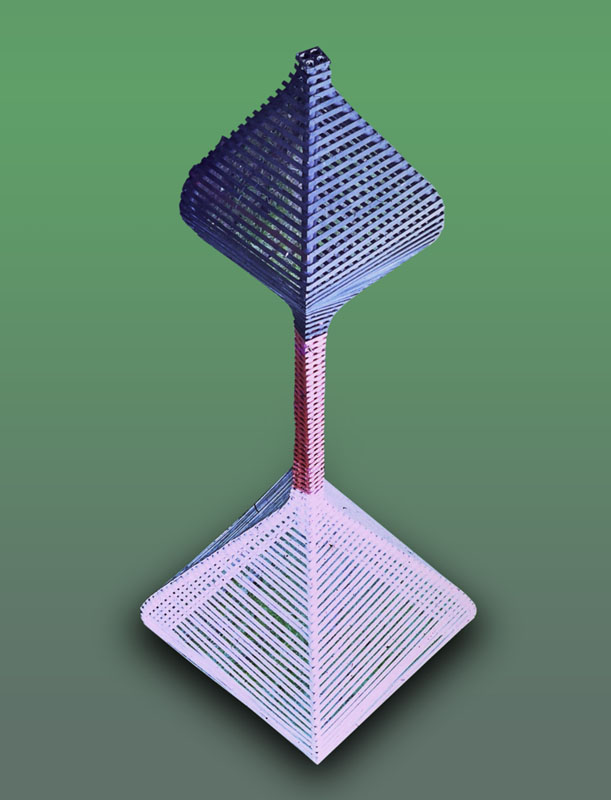
The flat aluminum bars, black, white and orange are pop riveted onto this frame. The arch at the top also used a frame of conduit and wood that had cotton duck stretched over keeping the whole structure light and easy to manoeuver.
We knew Paul would be facing the 'Inquisition Committee' soon and I suppose he spent a lot of time in his office cooking up a document of useless necessity as well as nudging us into places where we might find some art. He kindly sent me a catalogue of a recent show he had had rather late in life and there they were, pictures and images of the things he continues to make. It was wonderful to exchange a few emails and look through the catalogue; reading the notes revealed a truth about teaching and the drain it had been on his work.
When I became a student I had no idea that it would take quite so long to discover a place where I would begin to unveil the wonder of making art. I still think that students need a range of teachers from different age groups and classes, as we were lucky enough to have. Art has a long tradition and students tend to favour the new; better to leave art school knowing there is still lots to learn than thinking your career has begun.
The time just after leaving education is tricky; some turn out to become what we call successful artists, others less so; I'm one of those. It would be very hard to alter the way things work in any category; in the hurry, chance and luck scramble some artists may sadly be lost.
We end up with some excellent artists though who love humanity and make art for us all to enjoy and learn from. There are also a few scallywags but they seem to me to be even bigger losers than those they have hoodwinked. I may well have been vain at the time I left college but am glad to be in the place I am now. I can think of no greater joy of life than the time I spend in my workroom.
Back then one of the things that our degree course managed was a 'Crit'. At the beginning of most terms we were given a title/subject that led to a work done/made at home, these were brought into college and shown collectively; while we sat a teacher would talk about his or her responses to our work and we all, possibly secretly, loved these occasions.
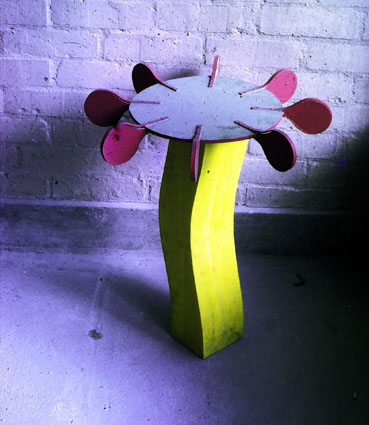
During the sculpture year the topic given for our 'Crit' was 'Syncopation'; I can remember during my 'dream up' thinking of trying to combine two things into one work and came up with this.
Via jazz I thought I knew about syncopation as two things combined to make a whole, the second of which connects but is unexpected to the first. As I liked jazz I thought that if the yellow was the Mississippi then the top could be the paddle of a riverboat. Here I might say that that kind of 'satisfying' explanation is a literary one and nothing at all to do with the truth. I have no recollection of what I was thinking about back then but find it interesting that the explanation works. What it also does is terminate the visual thought; once you know the 'story' you think you have the meaning. This happens with lots of our looking at visual art and I see little solution to the difficulty. We all love stories and if the 'story' helps what can be wrong with that; nothing, but there is more to be thought about.
Soon after the 'Crit' I came into the sculpture school one morning and Mr. De Monchaux told me some students from the printing department of the college had vandalized my work. I seem to remember not being upset but thinking that it was a response of one sort or another.
As I was writing this my beloved adopted daughter looked over my shoulder and I told her about the 'smash' from all those years ago. After out chat she gave me the notion that I could tweak the event into a crime scene.
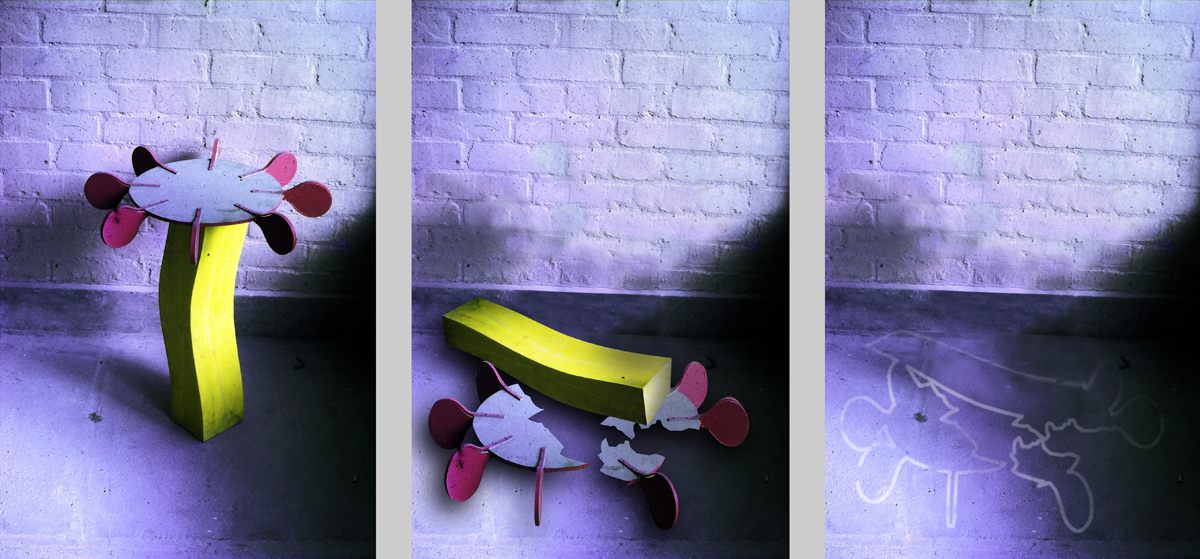
The only way I'll manage this is to call on Richard Photoshp skills, so I shall. Meanwhile I think that I might send this to Paul and hope that he enjoys someone else's memories of his first year at Camberwell.
Back to titles
07/02/2016
The Guildford Forty.
The first year after I left art school I began teaching at Guildford School of Art; I tried to be a reasonable teacher but knew very little about the practice. Teaching is not easy and now I am looking back through the events of my life, like many others I would love to change many things that worry me about the way I ran my classes.
The early events of this first teaching job and my desire to help students learn to draw and make art were soon overtaken by a 'sit in'. The Paris riots of that academic year and other protests across Europe spread and somehow or other, by the chances in life, included a 'sit in' at Guildford. There is no nutshell or nub of the Guildford protest, it jogged along with many facets and now there must be lots of different memories of its 'truths'. I wonder what the outcome would be of a collection of these memories and see there are things afoot on the Internet so wait in anticipation.
I was one of 'The Guildford Forty' but alas there was also a 'Guildford Four' so hope there will be no confusion. Our sacking was in 1968; the 'Bombings' were later in 1974.
I remember getting the letter telling me I had been dismissed after the haze of events that, along with lots of other teachers, I had been through. One of the odd outcomes was an exhibition of teachers' work at 'the something or other Gallery' in London. It was a motley collection of work I seem to remember with my exhibit being described in the Guardian as "The anti perspective sculpture of Andrew Wallace"; umm ... it was a square of twenty five boxes rising from the floor, the tops were cut at an angle of related heights that made a diamond top. The work was coloured and I wish I had taken a photograph of it or even a snap, lots of people tell me "colour is your thing Andrew."
After the 'outcome' was resolved some reinstatements and compensation payments were made; my back of the queue face meant I got virtually no money but was asked, as the least likely to behave badly, to pioneer a return to work. I did so and although the memory is vague seem to recall teaching, even in that climate of tight-lipped encounter, being preferable to the politics of a 'sit in'.
Art school education, like others I imagine, has changed from way back then and now seems more formal, more concerned with commerce. I hope I am wrong; being curious about what we see and how we can make responses to the wonder of looking is a joy of life. Drawing, that strange activity that links looking painting and art, seems to me to be the thing students should learn before all else so I hope they are lucky as we were.
One of the shouted comments I recall from the 1968 kafuffle was, "And don't forget Mr. Brett education is very different from training"; I agree and having been trained as an electrical engineer and educated as an artist know which suited me best but am grateful to have experienced both.
Back to titles
The Lucas Tooth Gymnasium and Adrian Berg
A few years before I went to evening classes at Camberwell School of Art I attended The Lucas Tooth Gymnasium; an old school building just off Tooley Street and a short walk from London Bridge station.
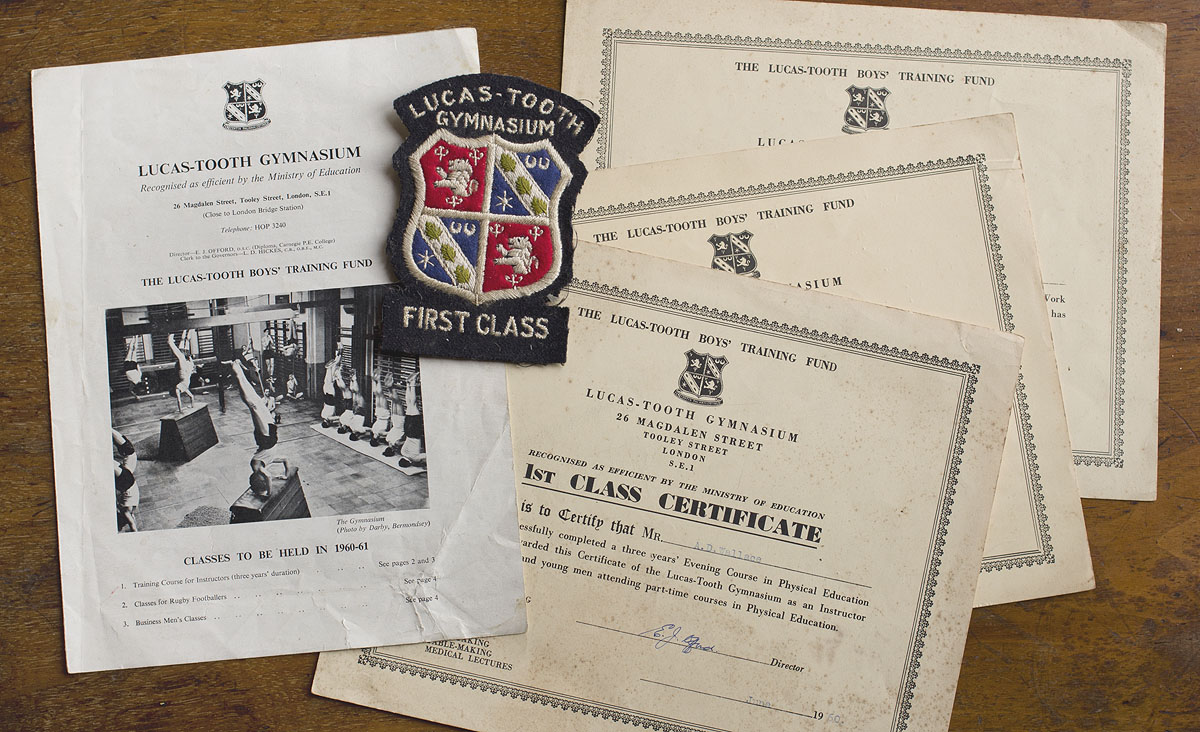
This was way back in the 1950s when Mr. Offard and a few other 'naval chaps' ran a thriving venue on five nights of the week. Young men from various backgrounds met to learn how to keep themselves in 'tip top condition' as one of the instructors was wont to remark. It was a three-year course and in the third year we did some displays when we would turn up in neat attire to vault or do a little of what I seem to remember was called 'floor/mat work?' It was inexpensive hence the motley crowd who turned out for an evening of non-competitive exercise. We were all very keen to look good as we performed and though some were better gymnasts than others I think we were a motivated team. One lad was really able and could turn a 'flip-flap'; many of the things he did looked great but he was not an 'artist'.
As teenagers our small group of friends imagined our future, thought of morality and dreamed of sex, hence the desire to look fit and healthy. Morality was mostly taught to us through 'the church' and the cinema. Church was not just the building at the end of the road but Sunday parades in the Boys Brigade, School assemblies, Sunday school and our parents. The cinema, it being a communal activity, helped us begin to place our thoughts in the society; providing us with a cultural base. These days I think that none of these routes have left a deeper impression on me than the movies from Hollywood; apart of course from my ending up in art school, which was truly a wonder.
I was, despite all of these healthy influences, in something of a mess certainly unhappy then along came my years in art school. Camberwell was a haven where we learned how to draw, paint and respond to the visual world around us. One or two might have been able to turn visual flip flaps as it were but I'm not sure any as yet were artists.
Barnet Newman was insistent that artists need a
subject; then if they find their voice they must find a way to put
it into the air. I am almost certain that an artist needs their
work to be seen in order to complete it; when you stop painting
and look at what you have done in a different way you may
encounter this phenomenon. Chattering at art school laid
foundations of my thinking and was like the Lucas Tooth filled
with a motley crowd of students. The teachers too varied both in
class and attitude; Adrian Berg, for example, introduced us to
Ludwig Wittgenstein's Tractatus Logico-Philosophicus
"The whole world is all that is the case"
"Of that which we cannot speak we must pass over
in silence"
But between these first and last lines remains a mystery few can
comprehend; I'm one of those. Art may be like that; a tasty
sandwich with a mysterious filling the liking and understanding of
which varies from person to person and changes as we age. Adrian
seemed to know about 'the lofty things' and was one of the artists
whose studio lighting got a revamp from me. He lived in the Regent
Park Nash Terraces, which was one of the poshest houses I had ever
been inside. Having worked since school on building sites I had
learned a little of how the places where we live and work were
constructed; as I lifted and refitted Nash floorboards I
discovered at least one detail of what a wonderful building it
was.
As well as his thoughtful reflections on how we students should respond to what we saw Adrian often held forth on other aspects of life. In his kitchen, the like of which I'd never encountered, he declared, "There are three cuisines Andrew, Chinese, French and Portuguese." Living with a view of Regents Park, knowing how to cook, being educated in that Oxbridge way, being thoughtful and kind made him perhaps my first enigma.
As I look at his pictures now all these years later I remember the things I saw against his workroom walls and how some were very different from what's on the Internet view. He clearly loved looking and the trees, parks and reflections of water, like those of Stourhead, are left behind for us all to see and learn from. Just one of the 'other' works he showed me in his apartment was 'Beaks'; this revealed a different, more daring way of looking at the world.
We were taught many things to strive for but among the taboos of "Umm decorative"; " that colour looks a bit dirty", one we had to avoid like the plague was "No, no that's far too illustrative", this was considered a ghastly fault. There are though many beautiful illustrations but I'm not going to stray off into definitions of difference here.
Adrian dared things where others might well have
backed off; caring deeply for art and not the current vogues or
fashions; he managed works that experimented with looking; 'Beaks'
was one of these.
This is a standard, ornithological illustration of beaks taken from the Internet and nothing at all like my memory of Adrian's depiction, which I would love to see again.
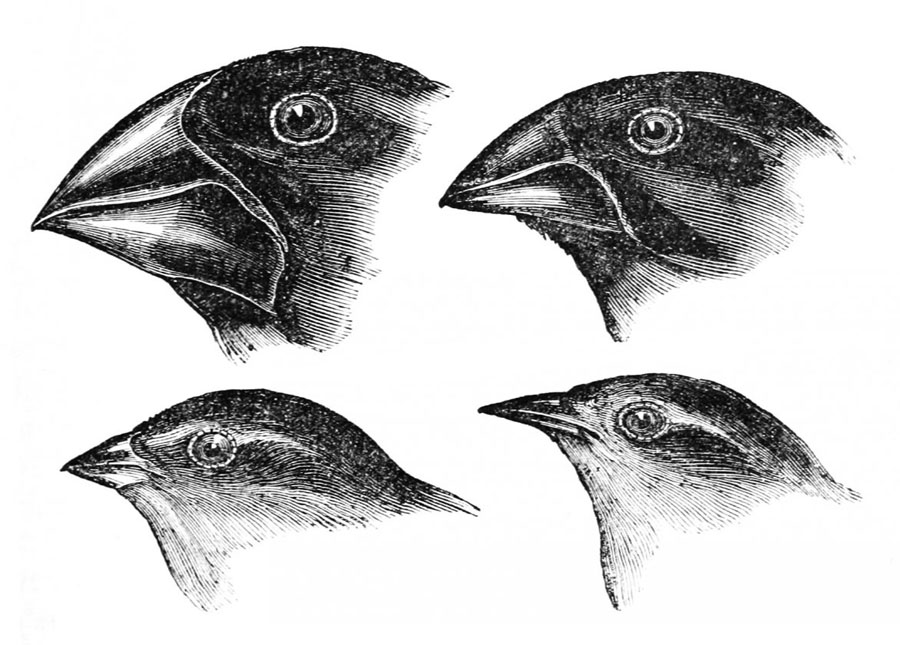
As a visual representation it has many
connotations and remains a memory of how to think about what
subjects for art may be. (by the by this quote from Barnett Newman
seems to connect up nicely "Art critiques are to artists as
ornithologists are to the birds")
As I walked round Stourhead Garden recently I found a spot where I could imagine Adrian drawing rather than painting; at the same moment of remembering him I thought of our 'Lucas Tooth' movements through the air. One of the 'other' works that leant against his wall was a study of figures that took my breath away. They were coloured outlines of models and at the time I blatantly used the notion for this painting (Leviathan) of which all I have left is a rather poor photograph.

Adrian's teaching perhaps made a link for me between movement and being still; being able to see our own weaknesses and to laugh at them. As I walk about the city or do anything among others I try to look with a hint of his gift; it has led to a different way of drawing from a static model that I still think is the best way to begin, to observing the moving form and capturing a static memory with a drawing.
I was mystified by him and would have loved to have been taught by him for longer than a couple of years. He would walk round galleries with students and once, he had a deep vibration, let out a peel of laughter as we looked at a surrealist twist. Surrealism ... now that really must be an appraisal for later.
Back to titles
04/01/2016
Sometimes I'm a bit vague.
"Far too vague" at the bottom of something I had
written when, as a schoolboy, I slowly crumpled beneath 'the red
pen'. I think that I liked school or would have had I had one of
these machines; thankfully for me it underlines, reminiscently in
red , but without, "It's easy, just look it up". I did try looking
for words in dictionaries and liked some of the things I found
there though it was seldom the spelling that told me how many c's
or s's are in necessacery nesacery necessary (there, there at
last)
There were other things that went wrong even though I clearly loved English lessons. To the delight of Mrs. French I separated and displayed parts of speech from the early years of subject and predicate through to adjectival and adverbial clause analyses. Poor Mrs. French could not understand why my essays might have incomprehensible aspects and intermittent incorrect spellings.
I began to truant, hid at home with the radio, played with my Meccano set and remember once venturing out to a wasteland rivulet where I built dams.
What is worth thinking about is correctness; I was told that my spellings were incorrect and I can see that it is important to be agreed about them. What I can also see is that certain things we see are 'wrong'. I used to be lured into saying they were incorrect to make my point; I was cross and hadn't thought it through.
The easiest example of this is to do with colour.
Many people paint their houses the wrong colour rather than the
incorrect one. Spellings of words must at some time have been
decided and agreed upon; there were other possible spellings,
which existed but were rejected. It is clear that as time passes
we tend to accept that the chosen spellings are now what we call
the 'correct' ones. There has never been an agreement about colour
juxtaposition and yet if one has been educated to respond to
'looking' many choices jar. I have to put up with many of the
things I see painted with wrong colours even though I feel we
might well be more content if the things we looked at were
agreeable to see.
When Paul Cezanne painted he analyzed 'the visual world' with a
degree of visual thinking that used no words. I still enjoy
looking at his work and trying to comprehend the depth of his
study. Quite soon after his death visual art changed from looking
and responding to 'something else' made possible because his work
seems to be almost conclusive. The 'something else' can cause many
heated disagreements and has added to the whole package of
struggle about what visual art might be.
I do not know what art is but do not feel vague about it because I have certainly felt it as an inexplicable sensation. There is plenty of bad art around but sadly when there is money to be made lots of artists are content to elbow their way towards a bank balance; they'll never know what a red pen looks like.
Fleeting thoughts and vagueness may well not have a status of grandeur but we all experience both on occasion during our lives. Our agreement of spelling being correct seems to me in a way to be connected; how can this be? Well, after a while many of the things we have experienced, even though they may have broken our hearts at the time they happened, we eventually see as correct.
All the arts have the possibility to reveal truths we might encounter. Proust for example points out that memory and time are seldom synchronized that one of the joys of life is being able to say "... all that sorrow for some one who was not even my type"; even though Odette and Swann caused each other such pain I feel for them both in memory and completely outside of time.
Back to titles
Back of the queue face
When I was first introduced to the 'route mean square value' I was thrilled; I'll try to explain how it works. It's a simple calculation that reveals the average value of something that goes up and down.

Here the curvy line goes up and down, above and then below the Y line; without going into how the calculation is made (I don't want to put you off) the dotted line is the curvy ones average value, now isn't that lovely and all because two multiplied negatives make a positive. What has it got to do with anything other than electricity is trickier to explain yet here I go.
The sign wave above lines up with all sorts of things around us and gives a rhythm of things. There are easy to spot things like 'life has it's ups and downs' or the 'harvest is good one year and bad the next' to slightly harder to fathom ones like the traffic on the M6; what's more I reckon, is that everything within and around us operates like these waves. They may be hard to spot, vary in height even be in and out of sync but there they are just like rococo to minimalism and back.

In the second half of the 1970s I had a season ticket for Queens Park Rangers Football Club and sat between two well-known composer musicians Michael Nyman and Gavin Bryars; they were a lot less well known in those days. Along with other musical minimalists we can hear their music a lot, sadly often without knowing it to be theirs. At that time Minimalism was not preferred, generally in fact not liked.
Staying back in the 1970s there was a magazine called 'The Listener' and Michael wrote a weekly column in it. One of his articles was titled 'Back of the queue face'; in it was his complaint that minimalist music was not being given a fair hearing; he began the piece with 'The other day a friend of mine said he had a back of the queue face; I didn't believe him but later that same evening he went on to prove it with out even trying....'. Michael was writing about his own 'back of the queue position' but the illustrating friend he used was me; it's taken a lifetime to realize its constancy and value.
I first heard minimalist/experimental music via art schools; back then these were frequently the places with early access to the complete 'art world'. I listened to Steve Reich and Phillip Glass who are now well known but then works like 'It's gonna rain' were hard to locate. Michael taught at two art schools benefiting from their being oases of 'off beat thinking' so no surprise that I met him at Goldsmiths College where he had an evening class when his music was in an early stage. He was an interesting teacher but even so ran a small class; one evening he played one hundred and sixty eight repetitions of eight bars that comes at the end of an Eric Satie work; Satie was one of the early experimentalists. Michael and I became friends and I learned lots about minimalist music from him. One of the things he thought of back then was to lift phrases from the 'classics' and repeat them with minimal variation. His 'take' from Mozart's Don Giovanni was one of my favourits and I think led to a form that carried him along for quite a while.
My love of repetition began when drawing or painting and I learned to concentrate; being 'outside of time' is a desire when the pencil or brush is close to Scheherazade. Minimalism may well be on the other end of a see saw from something like rococo; this is the point of the route mean square value many of us prefer; sometimes though it is far more exciting to go up and down with the 'reality' of the sine wave which is what happened to me when after a long journey in the year 2000 I got to Marfa in Texas and on a Thursday morning walked into this room.

My knees nearly gave way and I took refuge against a wall; the effect upon me of Donald Judd's minimalist work was easy at first because I was overwhelmed. My wife and I looked at other works around the Foundation for the morning but in the afternoon while I stayed she went to the 'Giant' hotel. On what might well have been my exit walk the young Scotsman who worked there said, "You were really moved by Donald's work this morning would you like another look". He gave me the key to the building, "Lock up when you leave, lock up and pop the key back into the office; I'll be there for an hour or so". I have no translation for the time I spent with 'one hundred aluminum boxes'. I may well have a back of the queue face but here I was at the apogee of my sine wave.
Post script.
In the early Michael Nyman years he was playing in public his
version of 'On the beautiful Blue Danube'; a passing listener
stopped her journey and asked him to "Please stop". Soon after he
recorded his score for 'A walk through H' and 'The Draughtsman's
Contract' but that is a story for later.
Back to titles
20/12/2015
The Art Market.
Many fine art students seem to stop working once they leave college when other things in life get in the way. Sometimes they return after a while away but some hang on through thick and thin. All of them though see the world differently because of their education.
During my student years we learned drawing as a basis of all the various things we were introduced to and tried. I'm not entirely sure how courses are run these days but certainly notice that generally there are fewer things around to feel good about looking at. There are though still wonders that artists introduce into our lives so perhaps it's the layers of things that have altered; quite how this works is tricky because, like rock formations, the order of layers is shifty and in need of history to reason out an explanation.
Money issues seem to dominate much of our lives and might well be the cause of the way our art markets are organized; this seems to me to be unfortunate. The monetary value of art is frequently an early thing that's mentioned when critics, historians and newsreaders are broadcasting. Money may well not be the only thing talked about but there is, and always has been, a difficulty in talking about what art is, naming a particular value is a real nuisance and helps little. Rich people have tempted artists to overprice their work and those 'layers' underneath are troubled by how much to sell works for. If you have lots of money and want an investment then you may be advised to seek out art that is unique, thus tempting the artists to make for and exhibit in, the market of obscurity.
It is easy to understand why many people refer back to the Impressionists or the Pre-Raphaelites as benchmarks. During these times artists/genres were more clearly layered, although not all the works are art. The money boys have their 'owned' works as valuable possessions and may like them or not; they often buy by 'name' unconcerned about anything other than the money value of the work. This doesn't help us to see very well. Manet on a bad day, kicking a work into no man's land rather than destroying it, leaves 'an investment' rather than a bad work of art.
When being taught to draw we were put into a 'place' where we learned/were taught to be alone and still; that place has been a retreat all through my life and I am lucky to have been introduced. Art, when one sees it, is a rarity and one of life's highest achievements; like the quantum it is tricky to follow but it definitely flows. What triggers that flow is not dissimilar from the twin slit experiment where looking at or away from affects the outcome. With art you can look at the same work on different days and either deeply connect or not; there are though always layers. Being still is quite a good opening gambit for looking. The art world is separate from most of us and like many things in life has a Mafia, assumed positions and addicts, meanwhile as you learn how to look the elusive art may float towards you and make you catch your breath at its wonder.
Back to
titles
29/11/2015
Daydreaming train ride to London
Lena Garnade died before she became herself and is buried in the vagueness of Brookwood cemetery. Traveling past her I gaze at the memory I have for this delightful young woman; in my daydream I am always allowed to give her some of that memory. Lena is a student at the art school I work in and we share a good exchange especially during the evening class I manage on sounds. She is interested in tape loops; this leads her to making a short work that is concerned with a continuous ending. She gives me a loop made on her Revox; we run it and talk about possibility, with three tape machines we feed two loops into the third machine that completes her work. Soon after listening to the results she is taken to hospital with a pancreatic fault; she dies. All the things we do at such times happen and Lena's ending leaves an annual prize and two of her works embedded into the courtyard wall at the art school.
After Lena's death her mother gave me Lena's tape recorder, which I still have; she also gave the art school an investment for the annual prize, The Lena Garnade Memorial Award.
How I would love it if there were an emotional language but there is none. Art is what it is and nothing else, something like that says Ad Reinhardt; close to emotion there is nothing else but emotion; I long to be there. When working with my paints I sometimes feel myself to be inside painting; then I am the closest I can get to our visual language; visual thoughts are so hard to translate. There seems to be one of those complex knots mathematicians know of that tie my emotion to my depictions. My time is running out, my fingers are stiffening as the love I feel for humanity deepens and I keep trying to approach visual art more closely.
I went back to Farnham Art School after many years; there was no sign of Lena, there her memory is gone.
"The next station is your final stop, Waterloo".
Back to titles
Dick Lee
Dick Lee was the person who ran the first year of the degree course for fine art painting at Camberwell School of Art. I loved this yearlong part of my education, not only as an afterwards memory but in the reality of that time; I longed to be there working in the building to the exclusion of all else. In the art school then were many who, like me, hadn't functioned well with academic education; how we loved learning now. Dick Lee steered his oddballs through the year with a generosity of human spirit and love of art that seemed to circle and entwine us with a need to learn how to draw what we looked towards before all else. His 'set ups' were so imaginative that when en route to the drawing days I imagine we all dreamed of what he would have prepared ready to challenge us.
There is such a range of things to look at these days that I feel sure many struggle with what art might be; how lucky was I and others who sat for days drawing from a Dick Lee 'set up'. There were many dedicated teachers at the college and we learned many things from our conversations with them but Dick Lee's 'set ups' made conversation that was about a tradition in a context.
If you enter any life drawing room there is first the model on the same floor as yourself; then the horseshoe of chairs or donkeys placed around him or her. At Camberwell, and most other art schools back then, there might well be an antique cast nearby but there is always something. Dick Lee was able to turn that something into what you could not fail to see and draw with the model.
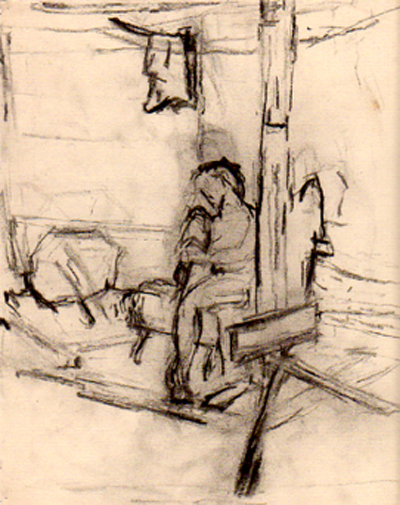
I'm not sure that I ever got to draw in relation to the whole
rectangle but it was a constant attempt; relating the top and
bottom of pictures is the struggle with the horizontal picture
plane, more difficult to my mind than the vertical one. Even if
there is a wondrous depiction the rectangle will seldom flash into
life unless all rises from the lower edge. Looking at a Dick Lee
set up made you aware that one of the things to find was that
elusive 'bottom line'.
Visual artists often struggle with translating what they do into words and as we humans mostly use words to communicate it's always worth a try. Art teachers along with their students have to forefront an exchange; Dick Lee had seen many pictures from the past and held that with what was happening around him in the art world all in his head at once; by sitting us around 'a whole scene' he initiated the possibility that as well as recording what we saw as a respectable drawing we might open the door and creep inside a work of art as we looked at it.
One cannot say all the things one has thought and learned in one lump and artists often seem to have a ball of knots in mind as they try to explain a depiction. It is not always helpful to say that the depiction is the explanation; I needed 'spoken' help when as a student I looked at an Arshile Gorky for example and only saw one of his works deeply after many years of looking. There are many works I have looked at and partially enjoyed but perhaps will never see deeply. We see many very ordinary works arranged in galleries alongside the great ones and I began to learn about this in my conversations with my teachers but especially Mr. Lee.

I painted this during that year and it's not a bad painting for a student but had it not been for the teachers it would not exist and I'll always remember the conversation I had about the bottom right hand corner; no need to tell you with whom.
Dick Lee went to France during the summer
vacation and I was one of the lucky few who got to mind his cat
while he was away working. The Barnes house was an oasis in my
troubled life; he even bought a painting of mine which I saw
hanging there among many others. What a lovely man he was.
Oh and as I painted the still life with apples above I was sitting
alongside Sid Barret, or Roger as we called him, but that's a
story for later.
Back to titles
31/10/2015
Angela Swann
A long while ago I was fortunate to have worked at the London School of Needlework, where I managed a drawing class, and lucky enough to have worked on the day that the students were given a series of history of textile lectures in the evenings. Some were technical and glanced in brief at weaving methods around the world; others, on the whole history of textiles, toured the globe in a different way. Only once did a lecturer complain about the treatment of women in the textile domain and I imagine there is still plenty to put right.
Among the fascinating talks some aspects of early Egyptian weaving were revealed and we learned about 'flat and wavy' cloth. Men's kilts were woven to be flat while women's dresses could be made to fall in curves. The weavers managed this by the arrangement of their warp threads. Spinning of threads can be either clock or anti clockwise and these are know as S and Zs. If you imagine arrows in the ends of these two letters you will get the picture. When setting the warp threads up tensions can be regularized to make the cloth flat or tend to fall in curves; it's quite easy to imagine.
As I dreamed of Artisan Egyptians weaving textiles I also thought of their wonderful interiors and began to wonder about the differences dividing arts and crafts. Egyptian works on walls and ceilings inside tombs had purpose. They were and still are beautiful to look at but are they crafts or works of art? Any looker can see the dresses and kilts of this ancient race clearly depicted as images and in the London Museum we can also look at one of the dresses inside a glass case.
I once tried to explain to a child that 'grown ups' could make a dress and sell it then paint a picture of the same dress and sell it for more. I then found my self in deep water. Tanya had just made a nice pocket to sew onto her pajamas and asked, "What is art Mr. Wallace? Is design first and art afterwards?" Alas there is so much child bluff around and I knew I would soon see her laughing, which was often my way out of working harder on these difficult thoughts that need an explanation.
'Where is art?' sometimes seems to me to like 'Where is the past?' or for the religious among us 'Where is the soul?'perhaps living in time is less fair than hereditary titles, being poor or having a talent.
Degas who 'Liked to draw' made a small figure called 'Ballet Dancer' she resides inside a glass case at our Tate Gallery. His figure is wearing a dress and has a ribbon in her hair; a few years ago the ribbon had clearly worn out and conservationists were asked to preserve it; after some debate the ribbon was replaced with another. The old one is now in a specially made case and housed in the gallery archive, possibly there for a future television programme but certainly not for looking at as part of 'general viewing'. On the figure I wonder if the new ribbon is now part of what sometimes flows between an artwork and a looker and whether in the long shut case there is an Egyptian Fayum painting equivalent.
I have never heard a really good explanation of what art is and I don't have one either. There are people out there though who are quite brilliant at putting you in a 'place' where you might be more tuned in. Tanya's questions are for me the target; an explanation for her might mean I understood my self and as I have to admit to myself each day I mix and apply repeat 'I do not'... 'I do not'... 'I do not'.
Before I muddle myself more than I am already what has all this got to do with Angela Swann? Well many years ago Angela lived and worked in Warwick Square where I was painting a mural for the woman who owned the flat. While she weaved Russian weft into her textile in a nearby room I tried to fit my depiction onto a wall; it's very different from making one work in a rectangle but I got on with it and finished. Here I might add that Angela Swann was beautiful both in name and gesture; the rhythm of a weaver can be a visual treat and she had a hint of sadness in her eyes that makes me happy to remember her.
I left my work and Angela in Warwick Square and have not seen either since until she appeared as a judge on a Monty Don Television programme about reviving crafts. As I watched the television I wondered had she been a little 'rounder' I might have thought, "a stout woman came and stood beside me". If she ever reads this I hope she will forgive the Proust reference. I'd like to talk with her about 'Times Arrow', which by coincidence connects with the flat we worked in; the owner was Pru Arrow I seem to remember.
I find judgments really difficult but we need them and Angela Swann took the lead on the Monty Don Show. Sadly though Monty Don's, like so many other 'entertainments' ended with a winner; how unlike our lives.
Back to titles
Clement Greenberg
In the 1960s there was a show at the Tate Gallery called 'The Guelbenkian Five Hundred'. It was extensive and had American artists' post-painterly abstractions, a term coined by the then well known art critique Clement Greenberg, along with some other 'slots' of that time. 'Op and Pop Art' were emergent and 'Girl with a Ball' on show in that exhibition remains one of the most memorable pictures I have seen, it was quite, quite ecstatic. I have looked at many Roy Lichtenstein paintings since that time but never 'Girl with a Ball' even though he painted other versions. This show was one of my life markers and no doubt I shall mention it again as I ramble through my history notes.
From that time I have a personal story about Clement Greenberg. When I was in my last year at Camberwell School of Art he was a judge at the Liverpool John Moores Show in 1967 and had selected one of my paintings (here is the rather awful snap I took of it back then) I still have the picture and could ask Richard to photograph it for me but somehow I think this one is better for the story.
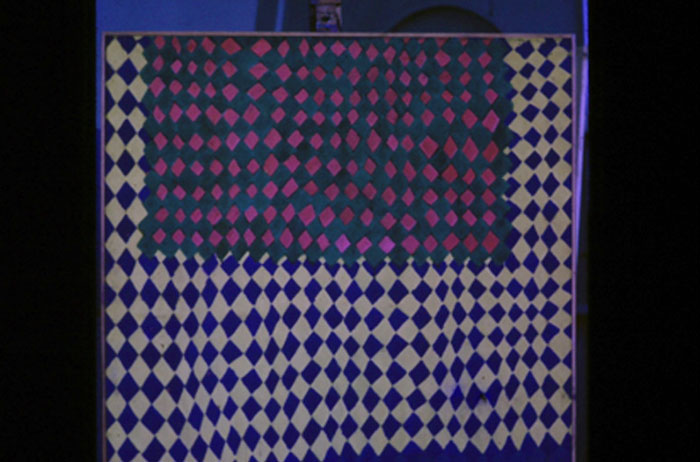
I was quite surprised to get the picture into the show, as were the teachers and students of my 'year' at the art school. I think that at that time I was still on the fulcrum of change and made many personal mistakes as I expect many of us do; it's a bugger and in some cases spoils people's lives. One of the good things for me though was that I met Clement Greenberg. While up in Liverpool I had acquired his temporary London phone number; he had taken a flat on the Chelsea Embankment. I rang and rang the number but it seemed he was never there, until one day there was a reply, I was stunned. What to say? What to say? "Er, Hello Mr. Greenberg?" "Speaking", "Er, I'm a student at Camberwell School of Art and er, wondered if you'd come and give a talk/lecture at the school?" "I don't give lectures." "Er, Oh Dear that's a shame", (I remember a pause) "I'll come and answer Questions", " Er crikey, sorry - er - er when could you do that?". The great man gave a date; I have no memory of or how we made arrangements but we did.
My dear friend Tim rented a basement room in one
of the teachers houses and that teacher kindly lent us his Renault
4L to bring him, Clement Greenberg, to the Art School. I had
mentioned to the Staff that I had done this but in all honesty
remember very little of what happened before 'the event'. What I
do recall was opening the door to Room 26 and finding that it was
packed; Tim and I stood just inside the door as Mr. Greenberg
stepped carefully through and across the entwined limbs of
students to the empty chair at the front. Once more, and in all
honesty, I cannot remember a single question or answer; what I can
recall is that every teacher was seated right in front of him and
that they dominated the proceedings.
After 'the event' Mr. Greenberg was taken to the Principal,
Leonard Daniel's room along with the then head of fine art Phillip
Mathews. I was wandering around dazed when someone told me I had
to go to the Principal's room. I had no idea where it was but
eventually turned up and hovered nervously.
Phillip Mathews drove Mr. Greenberg back to Chelsea while I along with other students went back to the studios and carried on painting.
Looking back now I think that it must have been quite a coup for me as well as the Art School but I made nothing of it. I put this down to my then naivety and other things I'll talk about later.
Back to titles
01/10/2015
Looking with AD Reinhardt
At the beginning of his Reith Lectures in 1982 Dennis Donahue quoted Jasper Johns; "I can imagine a society without art and it is not a bad place", AD Reinhardt said, "Art is Art. Everything else is everything else. I tried to oppose the academic in the marketplace. Only a bad artist thinks he has had a good idea. A good artist does not need anything"
After thinking about these two quotes I can imagine myself wondering if I am an artist at all and that luckily it doesn't matter anyway; phew. What I do care about is that I have seen works by both of these artists and that when I last looked at an AD Reinhardt I had tears in my eyes. Years ago I would not have seen the painting very well and the one I saw recently took a while to tune into. I have to add that with works like these it is useless looking when not in front of the actual work. You could say that about any picture, and you would be right, but there is more of the sense of a figurative work in reproduction because it has an image, with AD Reinhardt there is none.
I might digress here a little and mention a change in the Reith Lectures. After listening again to the 1982 Dennis Donahue I listened to the more recent Grayson Perry ones, how very different they are. During his lectures Grayson Perry was firm in his statement that his television programes are not art and yet my deeply thoughtful adopted daughter and myself (she is also a 'phew that was close' artist) were moved greatly by his television performance of 'Julie's House' especially the 'Cycle ride of the Julies'; I have not seen the house though most of us are or know a Julie.
My digression is that the lecturer now has a live audience with whom they interact; Dennis Donahue sat in a studio reading his notes. I have been told at times to stick to the point but one of the joys of dyslexia is that you can wander around bumping into these differences.
Back with the looking notion we mostly see pictures in galleries and if someone walks into 'the frame' I try to include them in the looking; I had this simple notion a while ago when looking at an enormous Marc Rothko painting. Later when looking at Vermeer's tiny 'Lace maker', while among a huge crowd peering, I ventured to include the remarks I heard because quantum theory has made us rethink the position, direction and route of tiny particles. Now this may seem a dyslectic leap too far into 'a theory of everything' but bear with me. Feelings we have are somehow tied into the science model so why isn't there a 'quantum looking' diagnosis? The much loved twin slit experiment does not say quantum notions cannot be used because they are not fully explained or understood so perhaps when we truly or deeply connect with art through looking at it we just might be the recipient of 'entanglement' or 'spooky action at a distance'. I do not feel alone when I am transfixed by art; a thoughtful look at an AD Reinhardt painting takes time but when a 'vision' arrives in your thoughts it seems to me quite still, outside of time perhaps.
Back to titles
23/08/2015
"Bleeding Heart Yard".
“Cotton thread danced across her hand and through the needle’s
eye; the stitcher turned to her daughter, “We cannot have magic
without cost” pointing to blood on the tip of a finger.” I
remember this fragment or something like it from many years ago
when reading ‘The Corn King and the Spring Queen’ by Naomi
Mitchison. Virago Press published some of her books when they
still had an office at 105, Great Russell Street not far from
the British Museum. The address now houses the art shop
Cornelissen, well worth going into and finding something or
other to buy even if you don’t paint pictures.
As a student I remember finding the shop daunting but started to
use it more as I switched from packaged paint to making my own
from pigments. There were other art suppliers I recall from
student days like Spectrum paints, Bird and Davies who, along
with Russell and Chappell, were and still are important though
both have moved from their original addresses.
There must be many stories associated with these suppliers but I
imagine the shop with most would be Lawrence Art Supplies at the
wondrous location, Bleeding Heart Yard. In our day it was run by
the lugubrious Stanley and there is a book ‘Tales from Bleeding
heart Yard’ which as a limited edition is expensive so I only
know this quote from the internet:’
(Stanley said) "What do you want?",
I said "I'd like to buy some blocks".
He said, "I don't sell to new people".
Back to titles
Barrington Court and a potter.

Emptiness has a special quality; Barrington Court, a Tudor Manor House in Somerset is empty, well almost empty, and as a consequence is a wonder for our imaginations.
There are a few workshops near the 'Big House'
one of which has two potters; I chatted with Paul. During the talk
I began to remember my brief encounter with pottery when I was on
my foundation year at Camberwell School of Art. In those days
foundation was a busy time and the school tried to cram in a few
crafts as well as figurative drawing, held up as the basis of all
our looking. Thursdays was pottery day, we were shown how to
throw, glaze, make and decorate tiles and use slip.
One Thursday there was a special treat; back then I had less
notion of its magnitude than I realize now. We arrived for the
craft day and found the small throwing room converted; it had I
think five wheels but on this day in the rearranged room we saw
only one. All of the potter/teachers were there, all of the
students proper and we of the foundation stood, I seem to
remember, to watch the great Shoji Hamada.
Bernard Leach was there to translate and explain; he began with
curved bottomed jugs I seem to recall and gradually made us aware
of our privilege on this special day. I had no idea of the status
of the quiet man in the black Kimono who stood back during the
longish introduction. Then Shoji Hamada pushed his thumb into a
row of carefully prepared clay bodies and chose. He ascended a
raised platform sat crossed legged, sideways on to a kick wheel;
one of our teachers skillfully kicked for him as in Japan he used
a four holed wheel that he spun using a stick.
He placed the clay stump onto the slowly turning wheel not so much
with precision but a sense of a tradition I knew nothing of.
Bernard Leach stood close by and as he watched his head moved in
accord with his friend, sharing a special bond.
Mr. Hamada worked his way down the stump and there was for me, for
us all I expect, a special moment when he took the clay back in
and enclosed an empty space. How could this be? But then he put
his hand into the black kimono and withdrew what looked to me like
a fine toothpick; he pushed it into the spheroid with the briefest
of movements and moments to make a lid.
This gentle potter showed, no made, what philosophers call a union
of mind and body. Bernard Leach translated the little he spoke;
the only phrase I remember was, "Shoji says making pottery is not
like climbing a mountain but more like walking downhill into the
breeze". At Barrington Court I watched as Paul raised a bat with
four or five just turned pots; they were a set, all the same but
different and as yet quite empty.
Back to titles
23/08/2015
The Goodge Street Lift
Between 1940 something and the year 2000 I
occasionally stood on a corner in Stanstead Road where on the side
of a house a huge V had been painted. Sometimes on visits to my
mother who'd spent most of her life living in the same nearby
house, I would make a point of walking past the V for those looks
that take us back to childhood memories. Gradually I watched as
the V disappeared and, once I knew it was going, took pleasure in
knowing what it used to be and why it had been put there.
In 2000 if you knew it had been there you could still detect specs
of paint that gave a feeling of some sort or another.
In 1950 something I traveled to Goodge Street
Station for the first time and in the lift quite clearly heard,
"Stand clear of the opening/closing gates". I traveled on and off
in the same lift over perhaps forty years; there must have been
regular lift users and I wonder what they noticed? On my
intermittent journeys my hearings of "stand clear ........"
gradually changed as the instruction became less distinct and
finally inaudible.
In the year 2000 the rumble, prior to the lifts ups and downs,
would mean nothing to a newcomer but old hands might well remember
what the message had once been.
In 1960 something I went to see West Side Story
with a girlfriend; it was on at Her Majesty's Theatre in the
Haymarket, we were entranced.
In 2000 and something I saw the same 'girlfriend' one afternoon in
a café that I walked to from Goodge Street Station; I had thought
of her off and on through my life wondering what she had done,
what she had come across and noticed as the years rolled by. After
many years she was different, had gained a self-assured certainty;
we haven't spoken since our 'second' meeting which I find rather
sad; perhaps she found my vagueness difficult.
In 1970 something I walked from Goodge Street Station to London University to hear a talk given by Phillip Glass; he had recently begun a work called 'Music in Twelve Parts'; I'm listening to it as I write. There were only a few people there and two left part way through, we remaining enthusiasts heard a tape recording of parts one and two.
In 2000 and something I sat in the back row of the packed Barbican Concert Hall to listen to new Phillip Glass compositions. At the end of his first piece the audience rose as one with rapturous applause and cheer. The extent to which his music is now used as background amazes me but then I like it; as it seems do lots of others.
'Spooky action at a distance', as Albert Einstein called it, is well worth trying to grasp, as are the whole quantum estates.
Back to titles
28/07/2015
Paul Strathem reveals in his book 'Mendeleyev's Dream' the trials and tribulations of the route to the periodic table, a most revealing and exciting story of quest. My own road to 'The Table' began with a chemist called Stanley sadly no longer alive; Stanley slowly laid out the cards bearing the names, symbols and atomic numbers of the elements into the iconic form many of us are lucky enough to have seen pinned up in our schools. As he took us through the horizontal periods and vertical groups he managed to engender inside me an ember almost out. Peter, another chemist, explained the shell structure of atoms and Sylvia the different strengths of carbon; both managed this with penciled diagrams and what a picture they revealed. I would not have understood any of this renewed revelation without my ability to see; this experience changed my whole way of thinking on what art might be.
It was Stanley though who made an indelible impression; he was old and frail as he laid out his hand written cards and yet forced himself to his feet after completion. He paused, engendering a powerful atmosphere among our small group, and with reverence from a lifetimes study declared, "Isn't it beautiful." We did not see the same beauty as he but saw him, which for me was one of my life's most beautiful moments.
Mendeleyev's mother left her son these words, "Refrain from illusions, insist on work and not on words. Patiently seek divine and scientific truth." I have spent my life making art, much of it as paintings, a different kind of illusion from the one I think she meant. There is something else in painted depiction that is not the illusion we see first when the subject is, like Stanley's vision, a deeper thinking of what our views of the world are made from.
Back to titles
Gold leaf and Electricity
During the 1950s, as an apprentice electrician, I worked in the City of London's post war reconstruction and so saw inside many of its buildings where I would not be allowed today. One I can easily pop into however is the ground floor of 40/45 Fenchurch Street, a Sainsbury 'Shop Local'; when we worked there it was a bank. We also worked on the rebuilding of the Clothworker's Hall, an adjacent building in Dunster Court. I recently visited the hall after an exchange with the Guild's archivist; who kindly gave me copies of the electrical plans; here is the corner of one so you can see I was apprenticed to Grierson Ltd of 140, Cromwell Road London. The drawing was completed on the 6th of March 1959.

As well as other aspects of the electrical installation much of my time was spent in basements working on boiler house control panels or intake rooms where, among other things, we soldered lugs and wiped a few armored cable joints. Ken Scullard, a quite brilliant engineer, took great pride in the appearance of control panels first laying them out on the floor where I moved things around while he instructed from the top of a pair of steps; only when satisfied with 'the look' did we attach the starters, timers, switches etc to the wall. I can remember Ken meticulously measuring the diameter of pyrotenax cable coils attached to a row of pump motors; "Pride in your work' was a way of life for him and most other electricians I worked with.
The last part of an installation was lighter work fixing switch plates, socket outlets and light fittings, often installed after, or while, the rooms up stairs were being decorated. It was during one of these times at the Cloth Workers' Hall that I watched the application of gold leaf to cornices.

A picked out cornice is one of the ways one can give a room status, this was my first encounter with decoration on a level I had never witnessed; I climbed up the trestles to watch for a while, quite entranced by the process. The relation between visual art and decoration interests me and these early times of watching skilled people engage with deeper human responses to life was, and still is, more than what we often refer to as being, 'clever with his hands'.
Later on at art school we students were warned against the perils of allowing 'being decorative' within our studies. I carried out suggested procedures without truly knowing the depth of these differences; differences that, at the thrilling edge of making things, are the key and locked doorway between the possibility of art and imitation of work that exists already. Great art seems to me to begin its possibility when an artist makes something on the boundary of time and space; in this place we have the chance of changing ourselves.
Perhaps the beauty of decoration is a respite from some of our hostile exchanges but I know that's not quite correct. There are though clues around to the difference; one from the Shaker movement where a carpenter would be allowed tiny adornments to functional joints, another can be seen in non-functional adornments to early pottery; so we know the desire to adorn is an ancient human response to making things. I must admit to being stumped to explain to myself a truth in this but keep trying because therein lies the possibility of a deeper response and understanding of art. I try to avoid being casual about the use of the 'art' word; its being banded around too glibly robs us all of being closer to a truth of our human spirit.
Back to titles
Sam and Vivi's clock: 28/06/2015
I gave my adopted son and his wife a carriage clock; they like it but never wind up the spring. As a child we had a mantle piece clock that was wound up every day as a kind of ritual. I thought it rather sad that they never wind my present but now realize that it is me who is out of touch; there are so many ways to know the time that there is little need for a mechanical device on a mantelshelf other than decoration.
When I lived in Camberwell I acquired a clock made by Mr. Harvey; it has his name on it with 'Camberwell' inscribed below. As a local he apparently cycled round on Mondays to wind all of his timepieces personally; that way I suppose he could keep an eye on their performance. My clock's distinctive tick tock has been heard by me for over forty years and overlaps the childhood one I heard, off and on as an adult until my mother died, as it ticked on her mantelshelf.
In the days of Mr. Harvey and his fellow makers there was a code that repairs would be recorded and kept inside the case, others could then refer to these handwritten sets of notes.
If you listen to Julian Barbour on you tube, here's a link to one of his videos or indeed read his book 'The End of Time' you'll join in the confusion. Time in science has plenty to say and it's fascinating but unresolved. If we turn to Marcel Proust however we learn, through his wonderful book, that memory because it is in the past is outside of time. This is true even in terms of duration; remembering a past pleasure, say in a theatre, never takes the same duration as when we saw the actual event. We can also turn to James Joyce writing Ulysses and see the bubble of time we travel in. Perhaps, because I cannot think of myself out side of time, what I might be, is unimaginable.
I doubt I shall ever be in eternity where there is no change, movement or limit to the language so I wouldn't be able to thank Mr. Harvey for making the timepiece that may stop being wound or ticking soon after my ticker conks out
Back to titles
Fog and gunpowder.
As children, like many others of that time I imagine, we played fog hide and seek; along came smog, the extra 's' adding density to our game. Freddie Homburg, what a great name for a childhood friend, had an inventive mind and began to win on a regular basis; his best hiding place was up a lamppost. The realization that we mostly look horizontally also led to a wonderful tram game; from the top deck you could ping the pavement people with peashooters, only our laughter giving us away.
I shared a noisier 'game' with Peter Bellamy, a
slightly older neighbour who could mix gunpowder with ingredients
bought from a corner shop; those were the days. His potions even
had different strengths. Down in the coalhole, where he made a few
guns, I watched as he nailed gas pipe to blocks of wood, one end
blocked with a hammered wedge and the other free to emit, at
speed, a small bolt. Once constructed he/we prepared to fire. A
hatpin, heated by a 'meths' flame, was plunged into a tiny hole,
painstakingly drilled by hand into the top back end of the barrel;
as the heat hit the powder the bolt fired into the heap of coal a
tiny way off in the gloom. I had my foot on the block to steady
the process; then a whoop of delight and off we went again. I find
it hard to believe now what we went on to do, me acting as a kind
of Igor; the experiments moved into a garden shed and we slowly
acquired the knack of aiming.
A few years before our frolics different guns had been aimed in a
war intended to end the extremist thoughts of fascists, at the
same time as Victor Passmore painted 'The Quiet River', a foggy
view of the Thames.
|
|
I saw and fell in love with this picture in the early 1960s. Laurie Glover, who lived in the next room to me, took me to the Tate Gallery for my introduction to the world of visual art. Soon aware that I had fallen for 'colouring' Laurie suggested I go to evening classes and learn how to draw. "What's an art school, Where is it?" were my naïve responses. |
|---|
I went to Camberwell School of Art and drew, for free, four evenings a week and all day Saturday, there was even a sculpture class on Wednesdays.
I was, and remain, ignorant of so many things; only recently beginning to see that the order we remember, the order we long for, cannot be lied about or even mistakenly made up. Our belief systems fail to tell us that even though our memories might be disguised as truth for the most part the past is a kind of fiction and not a single soul knows where it is.
Back to titles
David Wallace: 20/06/2015
Dear Madam / Sir,
I am the Prime Minister of Greece and I write you a politically correct letter in which "Dear Madam" precedes "Dear Sir." Thank you for noticing.
We here in Athens, cradle of Western civilization (apart from the bits the Arabs translated) send you the greetings of Dionysus and other well-known drunkards. May the blessings of Pythagoras, Plato and Aristotle be upon you, unless you prefer those of Euclid, who, we feel bound to point out, is from Alexandria.
Anyway, the point is that we appear to be in a little trouble; a negligable matter of $several trillion and we wonder if you, as well-known lovers of the classical arts (excluding nude wrestling, which anyway is Spartan rather than Athenian), would care to take part in our time-share offer on the few remaining artifices we possess, since Lord Elgin. - Have a browse through just five of our amazing summer offers:
1. Own the Parthenon for a day: Yes, for the ridiculously low sum of $1m, you can be sole owners of the Parthenon for the 24 hours of your choice, unless that date has been bagged by another.
2. Ouzo for life: Yes, at just $500 a day, you
can be guaranteed a continual supply of Ouzo, through your own
kitchen taps.* until you go the way of Socrates.
*Ouzo supplied via bathroom taps would set you back $700 per day,
but we are relying on you not to read the small print.
3. A seat on Mt Olympus: Who would not covet a deck-chair in season on the misty top of Mt Olympus, home of the Gods, launching site of Zeus thunderbolts and love-pad of Pallas-Athene? Hurry now for this summer's sit-in, including afternoon ouzo with one of our most popular gods, Mars, God of War.
4. Own your own trireme; Tired of landscape? Longing for sea horizons through every porthole? Why not invest in a trireme of your very own? Each one comes with a fully whipped group of slaves, with a waterproof laurel-wreath for your chosen captain, according to Greek democratic rules. A trireme offers the best opportunity to get away from the heat and city dust. Don't rely on the kindness of friends! Get your own trireme today!
5. Buy Corinth: This once in a debt-life offer comes with all the attendant benefits you might expect from purchase of this ancient Greek Province: a formidable navy, a crap army, traditional noisy neighbours in Corcyra and as many olives as you can eat. For one measly trillion dollars, you can help keep Angela Merkl at bay, not to mention that old French dragon, Christine Lagarde. And! - You'll own Corinth.
Here in Athens, we have an old saying: Democracy is for those who can afford it. So why not lay claim to your democratic pedigree by donating generously? I, my fellow communists and the starving Greek masses will be for ever in your debt. .... Er.... you know what I mean. ........... "in your spiritual debt."
Yours democratically
Alexandero Popokopodopolus
Back to titles
Here I am... write me a letter! or call +44 (0)7855 035785 for a chat.

